lordroel
Administrator
Member is Online
Posts: 68,017 
Likes: 49,422
|
Post by lordroel on Mar 11, 2024 3:48:58 GMT
Day 2008 of World War II, March 11th 1945Eastern Front The Red Army approaches Gotenhafen, closing a vital port of embarkation for tens of thousands of refugees from East Prussia who are now heading for the Hela peninsula. Western Front (1945) - Western Allied invasion of GermanyMap: HQ Twelfth Army Group situation map, March 11th 1945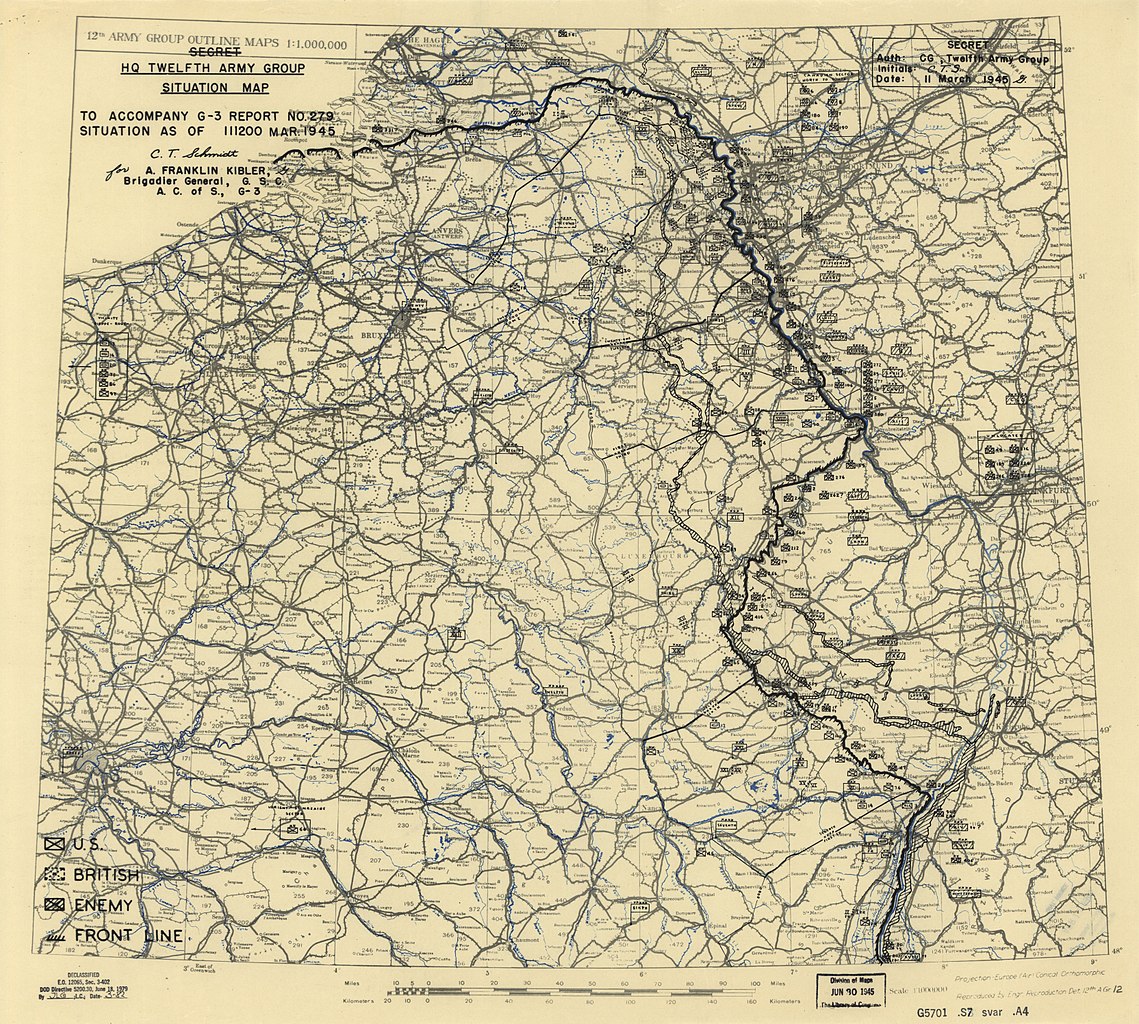 The US third Army captures Kochem on the lower Moselle river. Photo: 43rd (Wessex) Division troops and vehicles in the main street of Xanten, 11 March 1945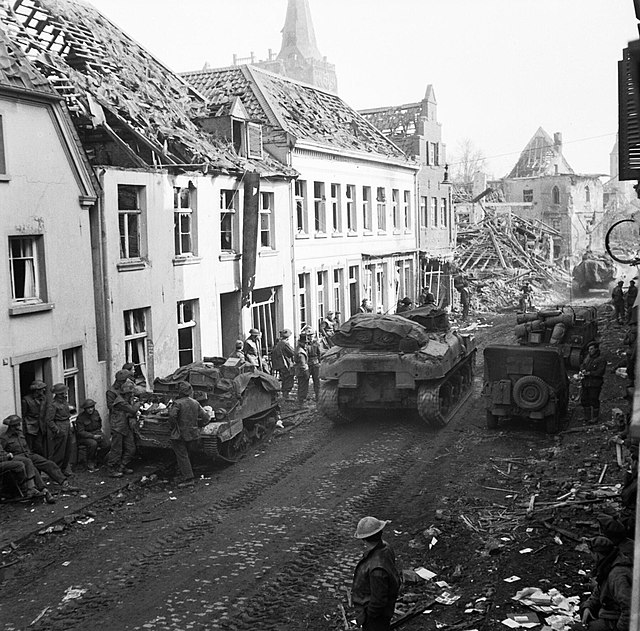 Photo: Sherman tanks of 8th Armoured Brigade in Alpen, 11 March 1945 Photo: Sherman tanks of 8th Armoured Brigade in Alpen, 11 March 1945 LCVPs (TG 122.5.1) go into action 200 miles from the sea, sailors assisting in erecting and maintaining an army pontoon bridge at the Remagen bridgehead. Navy support of the army's crossing the Rhine River proves invaluable and adds greatly to the successful invasion of the enemy's homeland. Map: Map of Operation Grenade from 22 February to 11 March 1945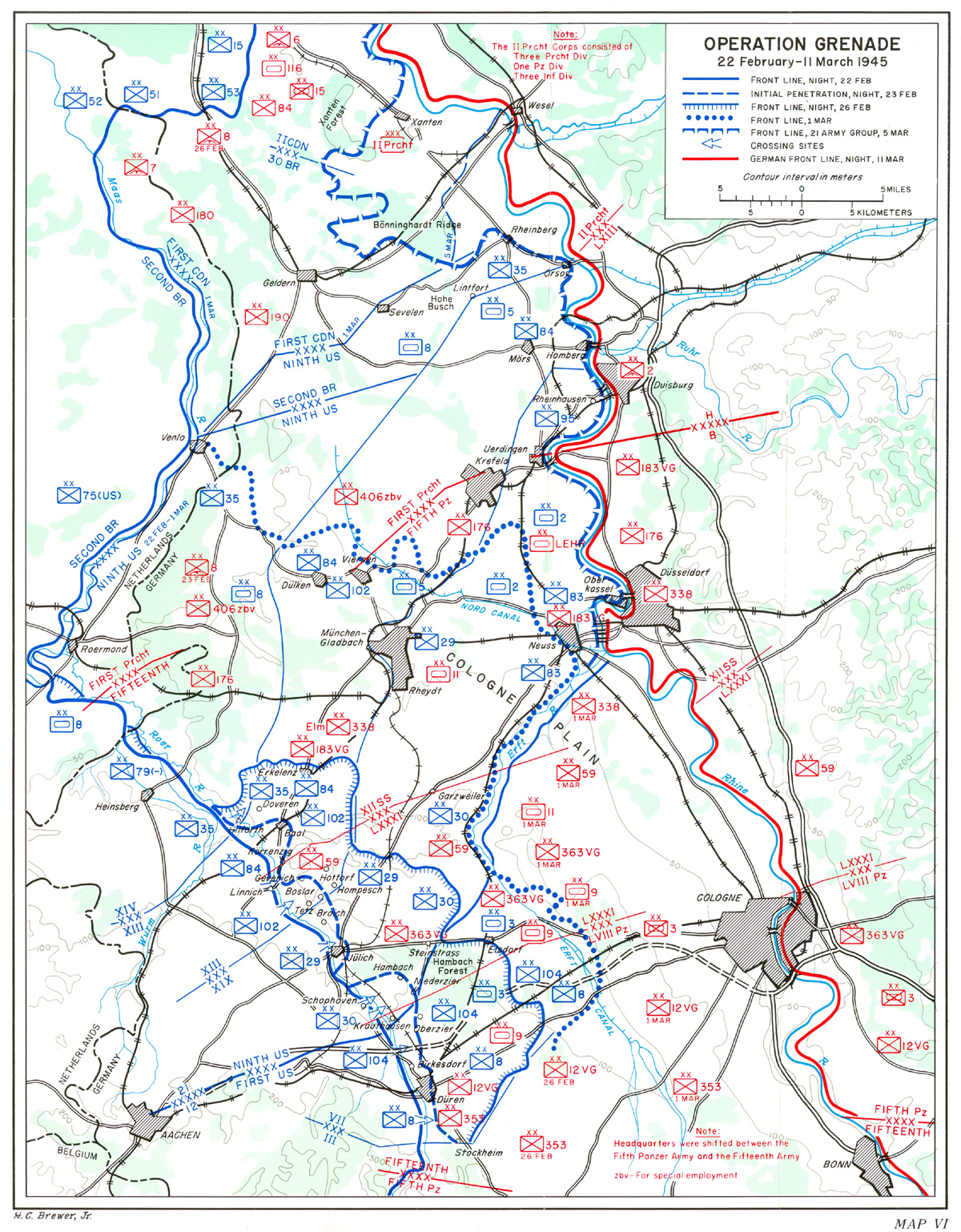 Air War over Europe Air War over Europe (US Eighth Air Force): 2 missions are flown. Mission 881: 1,256 bombers and 814 fighters are dispatched to make H2X radar attacks on U-boat yards at Kiel and Bremen and the shipyard and refinery area at Hamburg, Germany; 1 B-17 and 4 P-51s are lost: 1. 344 of 352 B-24s attack the Krupp Germania U-boat yard at Kiel; 2 B-24s are damaged. 232 P-47s and P-51s escort; 1 P-51 is lost. 2. 469 of 485 B-17s hit the Wilhelmsburg oil refinery at Hamburg; 1 other hits a target of opportunity; 1 B-17 is lost and 41 damaged; 3 airmen are WIA and 10 MIA. Escorting are 252 of 265 P-51s; 2 are lost. 3. 406 of 413 B-17s hit the Deschimag U-boat yard at Bremen; 9 B-17s are damaged. 237 of 255 P-51s escort; 1 is lost. 4. 6 B-17s fly a screening mission. 5. 18 P-51s escort 6 F-5s and a Spitfire on photo reconnaissance missions over Germany. 6. 27 of 29 P-51s fly a scouting mission. Mission 882: 11 of 12 B-24s drop leaflets in the Netherlands and Germany during the night without loss. (US Ninth Air Force): In Germany, 696 A-20s, A-26s, and B-26s, hit 4 airfields, 3 communications centers, 2 ammunition filling plants, and several city areas and other casual targets; these attacks are to obstruct air operations and supply and troop movements in general; fighters fly patrols and armed reconnaissance, escort the bombers, support the US 9th Infantry Division push at the Remagen bridgehead and fly cover over the area, and support the XX Corps E of Trier and Saarburg. HQ 363d Tactical Reconnaissance Group and the 160th and 161st Tactical Reconnaissance Squadrons (with F-6s) and HQ 373d Fighter Group move from Le Culot, Belgium to Venlo, the Netherlands; the 72d Liaison Squadron, Ninth AF (attached to Sixth Army Group), moves from Epinal to Buhl, France with L-5s. 1,079 RAF aircraft - 750 Lancasters, 293 Halifaxes, 36 Mosquitos - of all bomber groups attacked Essen. This was the largest number of aircraft sent to a target so far in the war. 3 Lancasters lost. 4,661 tons of bombs were dropped on Oboe-directed skymarkers through complete cloud cover. The attack was accurate and this great blow virtually paralysed Essen until the American troops entered the city some time later. This was the last RAF raid on Essen, which had been attacked so many times, though often in the early years of the war with such disappointing and costly results. Most of the city was now in ruins. 7,000 people had died in air raids. The pre-war population of 648,000 had fallen to 310,000 by the end of April 1945; the rest had left for quieter places in Germany. 90 RAF Mosquitos to Berlin and 6 each to Brunswick, Hannover and Magdeburg, 4 Mosquito patrols, 22 Lancasters minelaying in the Kattegat and off Oslo. No aircraft lost. Italian campaign (US Twelfth Air Force): In Italy, B-25s of the 57th Bombardment Wing score damaging hits on a bridge and fills at San Michele all'Adige, Volargne, and Ossenigo, and, attacking a target in Austria for first time, bomb a bridge at Drauburg; fighters and fighter-bombers of the XXII Tactical Air Command hit rail lines and dumps in the C Po Valley and in the Brenner area; during the night of 10/11 Mar A-20s hit several Po River crossings, Ghedi and Pavia Airfields, road junctions, and other targets in the Po Valley. Battle of the Atlantic PB4Y-1 (VPB 103) sinks German submarine U-681 southwest of the Scilly Islands, 49°53'N, 06°31'W. United KingdomThe first unexploded V-2 rocket to hit England lands in a field at Paglesham in Essex. The warhead is later extracted from a depth of 37 feet below ground. United StatesPhoto: A U.S. Navy Ryan FR-1 Fireball (BuNo 39648) at the Naval Air Test Center Patuxent River, Maryland (USA, on 11 March 1945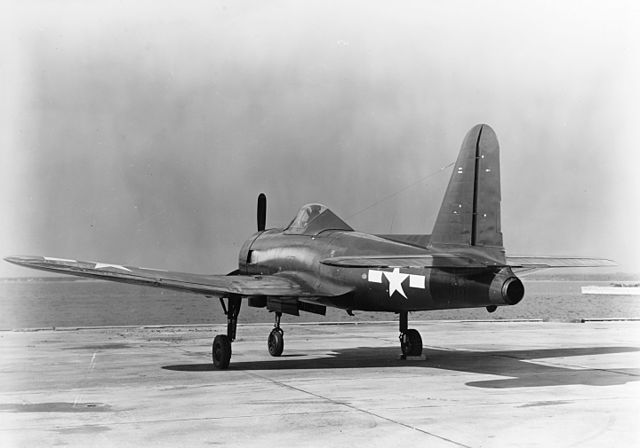 Pacific War Pacific War CHINA (Fourteenth Air Force): In French Indochina, 4 B-25s knock out 1 bridge and hit numerous boxcars at Kep and near Don Met. In China, 5 B-24s over the S China Sea and Gulf of Tonkin claim 1 freighter sunk and another damaged; 10 P-40s and P-51s blast locomotives on the Tsinpu railroad and demolish 3 villages E of Lohochai; the 1st Combat Cargo Group, 1st Combat Cargo Group, based at Hsinching with C-47s, sends a detachment to operate from Liangshan. INDIA-BURMA (Tenth Air Force): In Burma, 14 B-25s pound stores, troops, vehicles, and ammunition dumps at Konghsa, Kwai-Kong, Man Kat, and Mong Yai; 4 P-38s knock out a bridge at Mong Tong; 8 P-47s hit troop concentration at Kyaukme; 30+ P-47s hit targets of opportunity during a road sweeps behind enemy lines. Transports fly 547 sorties to forward areas. BURMA Mongmit is captured by a converging attack, from north (around Myitson) and west, by the brigades of the British 36th Division. GUAM Seventh Air Force: 11 B-24s from Guam again hit Susaki Airfield, while 8 more during the night of 11/12 Mar, pound the airfield individually. VII Fighter Command: Iwo Jima based P-51s also bomb Susaki Airfield and strafe Okimura and Kitamura on Haha Jima. HQ AAF (Twentieth Air Force): Mission 41: Attacking at altitudes ranging from 5,100 to 8,500 feet, 285 of 310 B-29s bomb the Nagoya, Japan urban area with incendiaries during the night of 11/12 Mar destroying 2.05 square miles; 6 others hit a secondary target; 1 B-29 is lost. SOUTHWEST PACIFIC AREA [Far East Air Force]: On Formosa, fighter-bombers hit Takao and B-24s bomb Mako. PHILIPPINE CAMPAIGN (1945) There is more fighting in the Batangas area south of Manila and in the north toward Baguio. Photo: Men of the 32nd Division are standing outside the Information and Education Tent at the Headquarters of the 32nd Division. Taytay, Luzon, P.I. 11 March, 1945 On Mindanao, B-24s bomb the Zamboanga area, Mercedes village, and San Roque Airfield and B-25s hit Mercedes, support ground forces near Zamboanga, and in conjunction with PT boats, hit Isabela, Barlak, Taluksangay, and a HQ N of Zamboanga. On Luzon , B-24s hit the Aparri area and support ground forces at Wawa; A-20s and fighter-bombers fly ground support missions and attack supply dumps and numerous targets of opportunity throughout Luzon. VOLCANO AND RYUKYU ISLANDS CAMPAIGN Photo: The U.S. Navy destroyer USS Paul Hamilton (DD-590) comes alongside the escort carrier USS Makin Island (CVE-93) during the Iwo Jima campaign, 11 March 1945. She is wearing Camouflage Measure 32, Design 3d. Note that the wartime censor has removed the radar antennas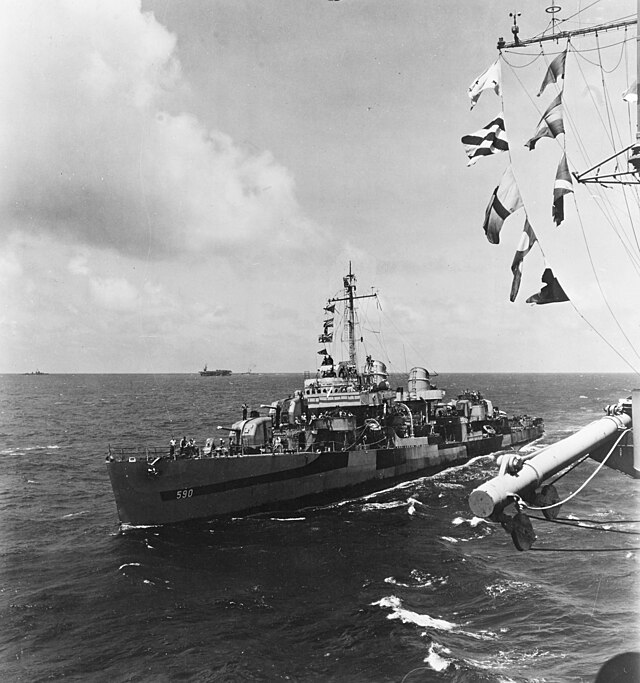 CAROLINE ISLANDS Japanese land attack planes [Frances], flying direct from Kanoya, Japan, attack U.S. fleet anchorage at Ulithi; one Frances damages carrier Randolph (CV-15), 10°01'N, 139°40'E, another crashes into Sorlen Island. Salvage vessel Current (ARS-22) is damaged by collision with Randolph during fire-fighting operations. UNITED STATES NAVY DEPARTMENT COMMUNIQUES, CINCPOA COMMUNIQUÉ NO. 295, MARCH 11, 1945 The Third and Fourth Marine Division drove through enemy lines to capture most of the east coast of Iwo Island on March 11 (East Longitude Date). The remainder of the enemy's garrison was compressed to a small area at the northern end of the island by the troops of the Fifth Marine Division. A small pocket of enemy resistance was by‑passed by the Fourth Marine Division and was still holding out at 1800 on March 11. At that time the Fifth Division was gaining slowly in the north against heavy resistance. The attack was supported by heavy artillery and Naval gunfire. Army fighters bombed Chichi Jima in the Bonin Islands scoring hits on airfield and harbor installations. Targets were strafed on Haha Jima. Liberators of the Strategic Air Force, Pacific Ocean Areas, bombed the airfield on Chichi Jima on March 10. Large fires were started among enemy defenses in the Palaus by fighters and torpedo planes of the Fourth Marine Aircraft Wing on March 10. Marine aircraft on the same date struck targets on Yap in the Western Carolines. PACIFIC Submarine Kete (SS-369) attacks Japanese Kagoshima-to-Naha convoy north of Okinawa, sinking transport Keizan Maru and army cargo ships Sanka Maru and Dokan Maru about 100 miles northwest of Amami O Shima, 29°48'N, 128°02'E; Coast Defense Vessel No.44 and auxiliary minesweeper No.2 Shinto Maru carry out ineffective countermeasures. USAAF B-25s (5th Air Force) sink Japanese army tanker Seishin Maru off Tourane, French Indochina, 16°01'N, 108°10'E.
|
|
lordroel
Administrator
Member is Online
Posts: 68,017 
Likes: 49,422
|
Post by lordroel on Mar 12, 2024 3:46:52 GMT
Day 2009 of World War II, March 12th 1945Eastern Front Kustrin falls to forces of the Soviet 1st Belorussian Front, after a bitter struggle. Apart from a small area in the north near Stettin, the Soviets now hold the whole of the Oder-Neisse river line as far south as Gorlitz. To the north, forces of 2nd Belorussian Front continue to push forward toward the Gulf of Danzig. In the Polish Corridor, they capture Tczew. Western Front (1945) - Western Allied invasion of GermanyMap: HQ Twelfth Army Group situation map, March 12th 1945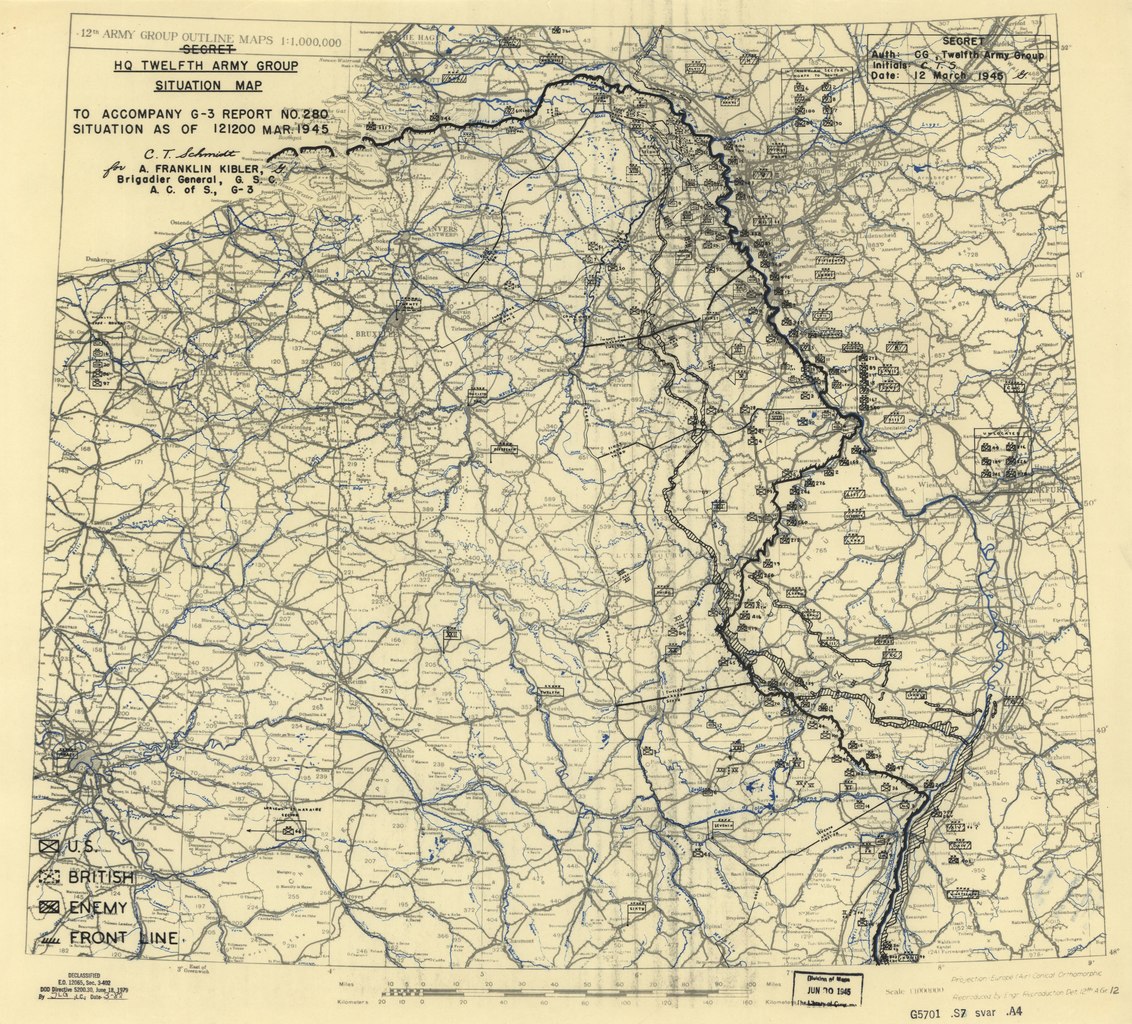 There is heavy fighting in the Remagen bridgehead where elements of the German 7th Army are counterattacking. Photo: View of destroyed buildings in Mayen, Germany, 12 March 1945. Two 3rd U.S. Army signalmen, Pfc. Patrick Sheery (New York, New York) and Pfc. Gerald [illegible] (Chicago, Illinois), are visible in the foreground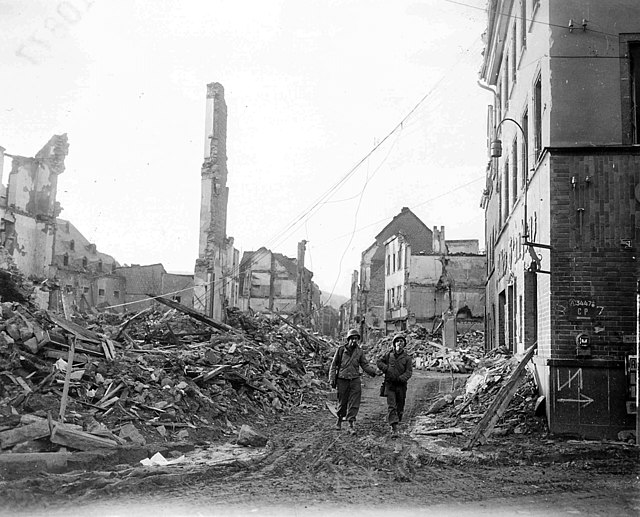 Photo: Two U.S. First Army, 78th Infantry Division soldiers patrol a deserted street in Honnef, Germany on the east bank of the Rhine River. 12 March, 1945 Photo: Two U.S. First Army, 78th Infantry Division soldiers patrol a deserted street in Honnef, Germany on the east bank of the Rhine River. 12 March, 1945
 Air War over Europe Air War over Europe (US Eighth Air Force): 2 missions are flown. Mission 883: 1,355 bombers and 797 fighters are dispatched to hit marshalling yards in Germany by PFF; they claim 4-0-1 Luftwaffe aircraft; 1 B-17 and 4 fighters are lost: 1. 220 of 227 B-24s and 441 of 450 B-17s attack the marshalling yard at Swinemunde; 1 other hit the marshalling yard at Husum, a target of opportunity; all attacks are made with H2X radar; 1 B-17 is lost, 6 B-17s are damaged; 1 airman is KIA and 10 MIA. Escorting are 412 of 452 P-51s; they claim 4-0-1 aircraft in the air; 4 P-51s are lost (3 pilots MIA). 2. 154 B-24s are sent to hit the marshalling yards at Friedberg (75) and Wetzlar (74) using Gee-H; 2 airmen are WIA. 3. 298 B-17s are dispatched to attack the marshalling yards at Siegen (141) and Marburg (113); 24 hit the secondary target, the marshalling yard at Frankfurt using Micro H; 4 B-17s are damaged. 4. 226 B-17s are sent to bomb the marshalling yards at Betzdorf (116) and Dillenburg (110) using Gee-H without loss. 5. The 2nd, 3rd and 4th forces above are escorted by 192 P-47s and P-51s without loss. 6. 97 of 108 P-51s fly a sweep to support the bombers without loss. 7. 10 P-51s escort 5 F-5s and 2 Spitfires on photo reconnaissance missions over Germany. 8. 23 of 24 P-51s fly a scouting mission. Mission 884: 11 of 12 B-24s drop leaflets in the Netherlands and Germany during the night and 4 of 10 B-24s fly a CARPETBAGGER mission. (US Ninth Air Force): 9th Bombardment Division A-20s, A-26s and B-26s attack 8 marshalling yards, an ammunition-filling plant, city areas and targets of opportunity; the attacks on the marshalling yards are aimed at blocking troop movements by rail into the Ruhr and Remagen areas; fighters escort the bombers, bomb special targets, fly armed reconnaissance, cover the Remagen area, and support the US 9th Infantry Division in the Kalenborn and Hargarten areas and the XX Corps in the Saarburg bridgehead area. The 387th and 388th Fighter Squadrons, 365th Fighter Group, move from Juzaine Airfield, Florennes, Belgium to Aachen, Germany with P-47s; and the 412th Fighter Squadron, 373d Fighter Group, moves from Le Culot, Belgium to Venlo, the Netherlands with P-47s. (US Fifteenth Air Force): In Austria, 790 B-24s and B-17s bomb the Floridsdorf oil refinery at Vienna and alternate targets, the marshalling yards at Graz, Zeltweg, and Wiener-Neustadt; 98 P-38s bomb the Knittelfeld railroad bridge (2 others hit nearby targets of opportunity) and strafe communications in the Wiener-Neustadt-Graz-Klagenfurt areas. 12 P-38s sweep the Zagreb, Yugoslavia area. Bad weather forces 60 P-51s sent against Austrian communications to abort; a supply mission to Yugoslavia and reconnaissance operations are successful. 1,108 RAF aircraft - 748 Lancasters, 292 Halifaxes, 68 Mosquitos attacked Dortmund. This was another new record to a single target, a record which would stand to the end of the war. 2 Lancasters lost. Another record tonnage of bombs - 4,851 - was dropped through cloud on to this unfortunate city. The only details available from Dortmund state that the attack fell mainly in the centre and south of the city. A British team which investigated the effects of bombing in Dortmund after the war says that, 'The final raid … stopped production so effectively that it would have been many months before any substantial recovery could have occurred'. 81 RAF Mosquitos to Berlin and 3 each to Halle, Magdeburg and Stendal, 2 RCM sorties, 16 Lancasters and 3 Halifaxes minelaying in the Kattegat. 3 Lancaster minelayers lost. Italian campaign (US Twelfth Air Force): In Italy, B-25s hit 7 railroad bridges, cutting two, and fills--severely damaging one and a train--in the Brenner area and in NE Italy as far E as the Yugoslav border area; fighter- bombers blast communications in N Italy, making 36 rail cuts, 19 of them on the Brenner line; P-47s also bomb and severely damage a munitions factory NW of Zagreb, Yugoslavia; during the night of 11/12 Mar, A-20s on intruder missions hit Po River crossings, a sugar refinery, vehicles, and trains. Pacific WarCHINA (Fourteenth Air Force): 4 B-25s knock out the Song Rang bridge in French Indochina; 6 P-51s hit road communications at Hwayuan, China and bomb a building at Ha Coi, French Indochina. (Twentieth Air Force): Mission 42: 44 of 49 B-29s hit oil storage facilities on Bukum , Malayan States, and Samboe and Sebarok s, Sumatra; 1 other B-29 bombs Arang Hill, Malayan States; they claim 0-0-1 Japanese aircraft; results are poor. INDIA-BURMA (Tenth Air Force): In Burma, 13 B-25s and 35 P-47s hit troop concentrations, supplies, vehicles, and AA guns along the battlefront and behind enemy lines; 66 P-47s hit transportation targets and a bridge during several road sweeps in C Burma; 12 others damage a bypass bridge at Hay-ti. Transports complete 677 sorties delivering men and supplies to advanced bases and dropping supplies to frontline forces. The 164th Liaison Squadron (Commando), 1st Air Commando Group, moves from Shwebo to Ondaw, Burma with UC-64s and L-5s. (Seventh Air Force): 16 P-51s bomb and strafe Okimura on Haha Jima. 13 B-24s fly daylight strike against Susaki Airfield; during the night of 12/13 Mar, 8 B-24s hit Susaki Airfield and Okimura. 24 B-24s from Angaur Airfield hit a Saragani Bay storage area on Mindanao. BURMA Myotha, southwest of Mandalay, falls to the British 20th Indian Division. PHILIPPINE CAMPAIGN (1945) B-24s hit Mercedes and Malabang on Mindanao. On Luzon , other B-24s bomb Japanese troops near Ipo, B-25s hit supply area at Bangued and troops at Pattao, A-20s and fighter-bombers fly ground forces support missions. fighter-bombers also bomb Calallo. Photo: Patrol of the 3rd Bn., 161st RCT, 25th Inf. Div., goes up a creek bed in the Luzon mountains near Digdig. 12 March, 1945 SOUTHWEST PACIFIC AREA [Far East Air Force]: On Formosa B-24s, with P-38 support bomb Takao and Tainan and P-51s also hit Tainan and bomb Jitsugetsu power plants. The 6th Troop Carrier Squadron, 374th Troop Carrier Group, moves from Biak to Tacloban, Leyte with C-47s; the 33d Bombardment Squadron (Heavy), 22d BG (Heavy), moves from Guiuan Airfield to Clark Field with B-24s; the 69th Bombardment Squadron (Medium), 42d BG (Medium), moves from Sansapor to Puerto Princesa with B-25s (the 69th is operating from Morotai). UNITED STATES NAVY DEPARTMENT COMMUNIQUES, CINCPOA COMMUNIQUÉ NO. 296, MARCH 12, 1945 The Fifth Marine Division continued its advance on Iwo Island on March 12 (East Longitude Date) and further reduced the area held by the enemy on the northern end of the island. Remnants of the enemy garrison in this sector continued to offer stiff resistance. Mopping up operations were in progress in the Third and Fourth Divisions zones of action, but one enemy pocket continued to hold out at 1800 on March 12. Naval gunfire and Army fighters supported the troops in the fighting on the northern end of the island. Army fighters bombed and strafed targets on Chichi Jima in the Bonins through intense antiaircraft fire on the same date. Liberators of the Eleventh Army Air Force bombed installations at Suribachi on Paramushiru and Kataoka on Shimushu in the Northern Kuriles on March 11. Columns of smoke rising to 15,000 feet were observed after the attacks. Army Thunderbolts strafed and bombed installations on Maug Island in the Marianas on the same date. Two buildings were destroyed and fires were started on Babelthuap in the Palaus by Corsair Fighters of the Fourth Marine Aircraft Wing on March 11. Neutralizing attacks on enemy held bases in the Marshalls were continued by Marine aircraft on the same date. PACIFIC Japanese guardboats No.1 Hinode Maru and Shosei Maru, are sunk by U.S. aircraft east of the Ryukyus, 26°54'N, 131°38'E.
|
|
lordroel
Administrator
Member is Online
Posts: 68,017 
Likes: 49,422
|
Post by lordroel on Mar 13, 2024 3:51:59 GMT
Day 2010 of World War II, March 13th 1945Eastern FrontThe German offensive to the north and south of Lake Balaton, in Hungary, begins to lose momentum. The Soviet 1st Belorussian Front (Zhukov) captures the Oder fortress of Küstrin, 70 miles east of Berlin, while the 2nd Belorussian Front (Rokossovsky) launches an offensive against the Braunsberg pocket south of Königsberg. Western Front (1945) - Western Allied invasion of GermanyMap: HQ Twelfth Army Group situation map, March 13th 1945 Eisenhower orders Bradley to limit the expansion of the Remagen bridgehead to a maximum width of twenty-five miles and a depth of ten miles, lest it detract from the main effort by the 21 Army Group. Air War over Europe HQ 61st Troop Carrier Group and the 14th and 15th Troop Carrier Squadrons move from Barkston, England to Abbeville, France with C-47s. 16 P-51s based at Chievres, Belgium fly an uneventful aircraft sweep in the Remagen-Koblenz, Germany area; 17 F-5s fly photo reconnaissance missions over Germany. (US Ninth Air Force): In Germany, 450+ A-26s, A-20s, and B-26s, bomb 3 marshalling yards, 2 airfields, rail sidings, and several targets of opportunity in the continuing interdiction campaign; fighters fly escort, patrols, and armed reconnaissance, attack assigned targets, cover the US First Army area in general along the Rhine River from Dusseldorf to Linz/Rhine, support the US 9th Infantry Division around Hargarten, cover the Remagen bridgehead, and support the XX Corps as it opens an offensive SE from the Saarburg bridgehead. (US Fifteenth Air Force): In Germany, 569 B-24s and B-17s bomb the marshalling yard at Regensburg; 3 other bombers bomb the Landshut marshalling yard and targets of opportunity; 280+ P-38s and P-51s provide escort and several strafe rail traffic in Germany and Austria during the return flight; 41 P-51s on a strafing mission attack rail traffic in the Munich-Landshut-Regensburg and Ingolstadt, Germany areas and between Vienna and Wiener-Neustadt, Austria. Photo reconnaissance is particularly extensive, with 18 F-5s covering areas of Germany, Austria, Czechoslovakia, Yugoslavia, Hungary, and N Italy; 41 fighters escort the photo missions. 354 RAF aircraft - 319 Halifaxes, 24 Lancasters, 20 Mosquitos - of Nos 4, 6 and 8 Groups to Wuppertal and Barmen. No aircraft lost. This attack also took place over a cloud-covered target and the bombs fell slightly east of the area intended, covering the eastern half of the Barmen district and extending into Schwelm. Bomber Command had now dispatched 2,541 sorties by daylight to Ruhr targets in a 3-day period. Approximately 10,650 tons of bombs had been dropped through cloud with sufficient accuracy to cripple 2 cities and 1 town. The bomber losses were only 5 aircraft, a casualty rate of 0.2 per cent. These results show the great power now wielded by Bomber Command, its technical efficiency and the weakness of the German defences. 38 RAF Lancasters of No 5 Group to bomb the Arnsberg and Bielefeld viaducts encountered bad weather. 1 aircraft bombed at Arnsberg and 2 further aircraft bombed alternative targets. No aircraft lost. 195 RAF Lancasters and 32 Mosquitos of Nos 1 and 8 Groups attacked benzol plants at Herne and Gelsenkirchen. The Gelsenkirchen attack was successful but not the Herne raid, 1 Lancaster lost from the Gelsenkirchen raid. 50 RAF Mosquitos to Berlin, 26 to Bremen and 6 to Erfurt, 58 RCM sorties, 37 Mosquito patrols. 1 Mosquito from the Berlin raid crashed in Belgium and 1 Halifax RCM aircraft in France. Italian campaign(US Twelfth Air Force): In Italy, B-25s bomb railroad bridges and fills at Perca, Vo Sinistro, Pizzighetone, Salorno, and Sacile; fighters and fighter-bombers attack bridges, flak positions, ammunition and a supply dump, rail lines, various other targets, and fly close support to the US Fifth Army force as the XXII Tactical Air Command operates over wide areas of N Italy from the N Apennines through the Po Valley, and into NE Italy; on the night of 12/13 Mar, A-20s hit railroads, Po River crossings, dumps, and movement, mainly in the Po Valley. Pacific WarCHINA (Fourteenth Air Force): 7 B-24s over the Gulf of Tonkin and the S China Sea claim a cargo vessel and a large junk destroyed. 13 P-40s, P-38s, and P-51s destroy a storehouse and damage a compound at Chinchengchiang, China and knock out a bridge and hit machinegun positions and other targets of opportunity at Lang Son, French Indochina. Photo: Entire convoy personnel of Maj. Gen. R. B. McClure, C.G. of C.G.C. and Gen. Ho Ying Chin, Supreme Commander of the Chinese Armies, 13 March, 1945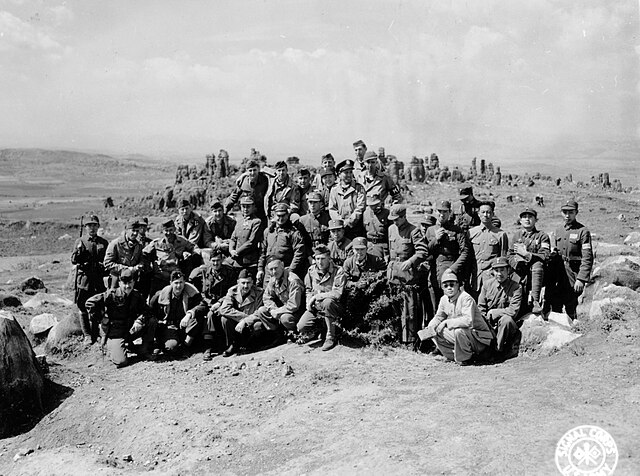 INDIA-BURMA (Tenth Air Force): In Burma, 16 P-47s support forces of the Chinese 50th Division, hitting Japanese positions along the Namtu River in the Namhsan area; 26 P-38s hit road targets S of the bomb line in C Burma; 12 B-25s attack troop concentrations, supplies, and gun positions behind enemy lines; 4 P-47s hit a wooded area in the British 36 Division battle sector; other fighter-bombers make ineffective bridge strikes. Transports complete 500+ sorties to forward areas. BURMA Maymo, to the east of Mandalay, is taken by the British 62nd Indian Brigade -- cutting the last rail line to Mandalay. Other units of the British 19th Indian Division are still engaged in Mandalay but most of the city has been capture in in a house-to-house fighting. Photo: The original IWM caption reads, "Sherman tanks and trucks of 62nd Motorised Brigade advancing on the road between Nyaungyu on the Irrawaddy bridgehead and Meiktila, March 1945." This however is slightly incorrect, possibly as the result of deliberate wartime disinformation. No 62nd Brigade was involved at Nyaungu or Meiktila (being part of 19th Division, engaged at Mandalay); the 63rd Brigade, part of 17th Division was part of the advance on Meiktila GUAM (Seventh Air Force): 6 B-24s from Guam hit Woleai while 10 others bomb Susaki Airfield; during the night of 13/14 Mar, 8 B-24s, flying individual strikes pound Susaki Airfield. 24 B-24s from Angaur Airfield bomb a storage area at Saragani Bay, Mindanao. (Twentieth Air Force): Mission 42: In the third of the Twentieth AF's great fire raids, 274 of 301 B-29s begin bombing Osaka, shortly after 2400 hours local on the night of 13/14 Mar; because of 8/10 cloud cover, bombing is by radar; the heart of the city, an area of 8.1 square miles, is wiped out during 3 hours of bombing from altitudes of 5,000 to 9,600 ft; 134,744 houses are destroyed, 1,363 houses damaged and Japanese casualties are 3,988 dead, 678 missing and 8,463 dead; 5 other B-29s bomb other targets; the B-29s claim 1-0-0 Japanese aircraft; 2 B-29s are lost. SOUTHWEST PACIFIC AREA B-25s hit sampans off Hainan, China while P-51s sweep Samah Airfield on the island. B-24s hit installations in WC Formosa and at Mako. The 408th Bombardment Squadron (Heavy), 22d BG (Heavy), moves from Guiuan Airfield to Clark Field with B-24s. PHILIPPINE CAMPAIGN (1945) On Mindanao, B-24s hit targets in the Saragani Bay area and effectively hit the town of Lagao and B-25s support ground operations in the Zamboanga area. B-25s, A-20s, and fighters support ground forces hitting forces and positions in the Cagayan Valley on Luzon. UNITED STATES NAVY DEPARTMENT COMMUNIQUES, CINCPOA COMMUNIQUÉ NO. 297, MARCH 13, 1945 No appreciable change was made in the front lines in Iwo Island on March 13 (East Longitude Date). The enemy occupying the northern end of the island continued to resist our attacks with small arms, machine gun and mortar fire. While mopping‑ up operations continued in the Third and Fourth Division sectors, our forces made unopposed landings on Kama and Kangoku Rocks west of the island. An enemy pocket in the Fourth Division sector was reduced in size but part of it still held out at 1800 on March 13. During the day 115 caves were sealed up. Army fighters bombed airfield and harbor installations on Chichi Jima in the Bonins on March 13. Seventh Army Air Force Liberators operating under the Strategic Air Force, Pacific Ocean Areas, bombed air installations on the same island on March 11 and 12. Fighters and torpedo planes of the Fourth Marine Aircraft Wing destroyed four buildings, set four other ablaze and destroyed or set afire three ammunition and fuel dumps on Babelthuap in the Palaus on March 13. Marine Corsair fighters destroyed one aircraft on the water and damaged a pier at Yap on the same date. PACIFIC USAAF B-24s and B-25s on antishipping sweeps off the China coast between Foochow and Hong Kong attack Japanese convoy KAI-311, sinking cargo vessels No.12 Aikoku Maru and 37 Kokoku Maru and 18 Tarumizu Maru and No.34 Tarumizu Maru. USAAF B-24s (5th Air Force) sink Japanese Coast Defense Vessel No.66 and transport Masajima Maru in South China Sea east of Swatow, 23°30'N, 117°10'E. Army barge PSB 111 runs aground on northeast side of Seguam Island Aleutians, but is pulled free by fleet tug Sarsi (ATF-111)
|
|
lordroel
Administrator
Member is Online
Posts: 68,017 
Likes: 49,422
|
Post by lordroel on Mar 14, 2024 3:50:27 GMT
Day 2011 of World War II, March 14th 1945Eastern Front Soviets forces capture Zvolen in western Czechoslovakia. Meanwhile, in Hungary, German Army Group South (Wohler) commits its remaining reserves to battle. The force is based on the 6th Panzer Division and consists of a mixed grouping of 200 tanks and assault guns which engage the Soviet 27th Army (Trofimenko). In East Prussia, the Red Army cuts all communications between Königsberg and the German forces fighting in the Braunsberg pocket. German counterattacks to recapture the oilfields near Lake Balaton come to an end. Western Front (1945) - Western Allied invasion of GermanyMap: HQ Twelfth Army Group situation map, March 14th 1945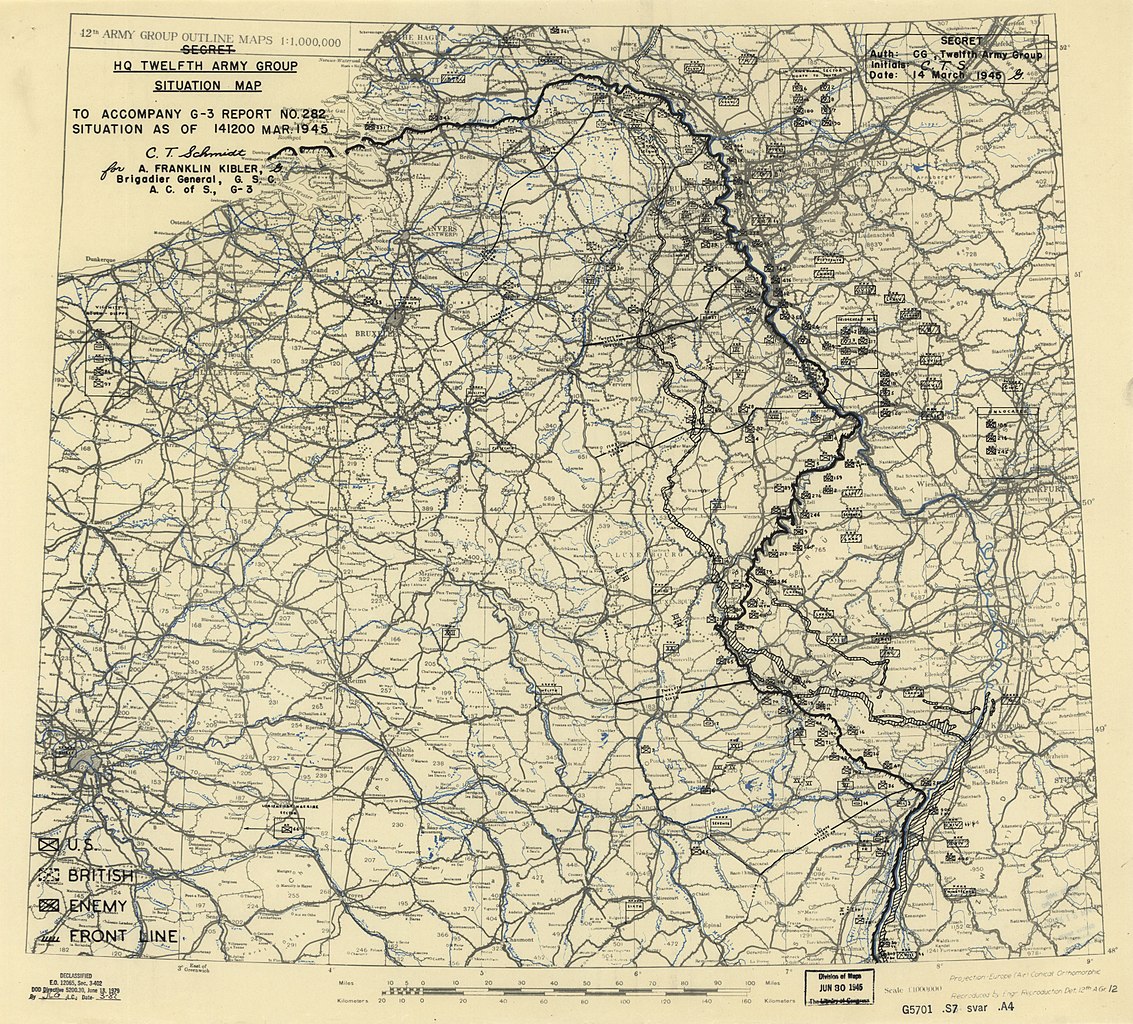 The US 7th Army launches attacks in the area around Saarbrucken and Bitche in a joint effort with US 3rd Army to eliminate German forces from the area between the Saar, Moselle and Rhine rivers. Photo: Mortar team of the 99th Infantry Division, U.S. First Army, prepares to fire 81mm mortar shell to halt advance of enemy patrol in woods between American-held Ariendorf, and Germany-held Honningen, 14 March 1945

Photo: Pvt. George W. Rodgers, Pittsburgh, Pa., and Cpl. Steve C. Lipinski, 84th Engineer Camouflage Battalion, attached to the 100th Division, Seventh U.S. Army, finish painting a M5-A1 tank, 14 March 1945

Photo: Black smoke pours from blazing tank loaded with ammunition, in background, which was set afire by German bombardment in Linz, Germany, on the east bank of the Rhine River, 14 March 1945
 Air War over Europe Air War over Europe HQ 367th Fighter Group moves from St Dizier to Conflans, France. The 410th Fighter Squadron, 373d Fighter Group, moves from Le Culot, Belgium to Venlo, the Netherlands with P-47s. (US Fifteenth Air Force): 634 B-17s and B-24s, with fighter escorts, hit the Szony and Almasfuzito oil refineries and marshalling yards at Komarom, Hungary; Nove Zamky, Czechoslovakia; Zagreb, Yugoslavia; and Wiener-Neustadt, Graz, and Knittelfeld, Austria. 90 P-38s dive-bomb bridges at Ptuj, Yugoslavia, 42 of them afterwards strafing rail traffic in Yugoslavia and Austria. 21 P-51s also strafe rail traffic in Austria. B-17s and B-24s drop supplies in N Italy and in Yugoslavia. F-5s continue reconnaissance missions, including a larger than usual number of photo reconnaissance flights (most of them heavily escorted) over Italy, Germany, Austria, and Yugoslavia. 169 RAF Lancasters of No 3 Group carried out G-H attacks through cloud on oil plants at Datteln and Hattingen (near Bochum). Both attacks appeared to be accurate but no results were seen. 1 Lancaster lost from the Hattingen raid. 32 RAF Lancasters and 1 Mosquito of No 5 Group, with 4 Oboe Mosquitos of No 8 Group, to attack the Bielefeld and Arnsberg viaducts. 28 Lancasters dropped Tallboy bombs and the No 617 Squadron Lancaster of Squadron Leader CC Calder dropped the first 22,000lb 'Grand Slam' bomb at Bielefeld. The Arnsberg viaduct, No 9 Squadron's target, was later found to be undamaged but more than 100 yards of the Bielefeld viaduct collapsed through the 'earthquake effect' of the Grand Slam and 'Tallboys' of No 617 Squadron. No aircraft lost. 244 RAF Lancasters and 11 Mosquitos of No 5 Group attacked the Wintershall synthetic-oil refinery at Lützkendorf. Photographic reconnaissance showed that 'moderate damage' was caused. 18 Lancasters were lost, 7.4 per cent of the Lancaster force. 230 RAF aircraft - 121 Lancasters, 98 Halifaxes, 11 Mosquitos - of Nos 6 and 8 Groups to Zweibrücken. No aircraft lost. This attack was directed on to the town area to block the passage through it of German troops and stores to the nearby front line, The raid took place in good visibility and was very effective. The local report shows that every public building and inn and 80 per cent of the houses in the town were destroyed or damaged. Most of the civilian population had been evacuated; those remaining took shelter in 2 large caves in the north and south of the town or in the normal basement shelters of their houses. 161 RAF aircraft - 127 Halifaxes, 23 Lancasters, 11 Mosquitos - of 4 and 8 Groups on the same task as the Zweibrücken raid proceeded to Homburg. No local report is available but it is believed that this attack was equally successful. 2 Halifaxes lost. 75 RAF Mosquitos to Berlin and 6 each to Bremen and Brunswick, 52 RCM sorties, 27 Mosquito patrols. No 100 Group lost 2 Mosquitos and 1 Fortress. The last Stirling operation of Bomber Command was flown on this night when Stirling LJ516, from No 199 Squadron at North Creake, flew a Mandrel screen operation; Squadron Leader JJM Button, the Australian pilot, and his crew landed safely. (US Eighth Air Force):: 3 missions are flown. Mission 886: 1,262 bombers and 804 fighters are dispatched to hit oil, rail and industrial targets in Germany; they claim 17-0-1 Luftwaffe aircraft in the air; 3 B-17s and 2 fighters are lost: 1. 526 B-17s are sent to hit oil refineries at Nienhagen (58) and Misburg (56), the Gebruder munitions plant (75) and Maschnbau (61) and Eisenwerke (74) factories at Hannover and the Seelze marshalling yard (80); secondary targets hit are Osnabruck (29) and the marshalling yard at Hannover; attacks were made visually and with H2X radar; 2 B-17s are lost, 1 damaged beyond repair and 188 damaged; 3 airmen are KIA, 6 WIA and 19 MIA. 192 of 204 P-51s escort; 2 are damaged. 2. 449 B-17s are dispatched to hit the bridges at Vlotho (72) and Bad Ostenhausen (114), the marshalling yard and road junction at Lohne (144) and industrial plants at Hildesheim (60); 39 hit Osnabruck, a secondary target; targets of opportunity are the marshalling yards at Hameln (12) and Wetzlar (1) and Diemonde (1); all but one target is bombed visually; 1 B-17 is lost and 56 damaged; 1 airman is WIA and 9 MIA. Escorting are 182 of 194 P-51s; they claim 1-0-1 aircraft. 3. 272 B-24s are sent to hit the marshalling yards at Holzwickede (31) and Gutersloh (126); 110 others hit the secondary target, the marshalling yard at Giessen; attacks are made visually and with H2X radar; 4 B-24s are damaged; 1 airman is KIA and 5 WIA. The escort is 185 P-47s and P-51s; they claim 3-0-0 aircraft; 1 P-47 is lost (pilot MIA). 4. 6 B-17s fly a screening mission without loss. 5. 29 of 33 P-41s escort Ninth AF bombers. 6. 50 P-51s fly a sweep of the Stein-Huder-Kassel area claiming 11-0-0 aircraft without loss. 7. 82 P-51s fly a sweep over the Remagen bridgehead; 1 P-51 is lost (pilot MIA) and 1 damaged beyond repair. 8. 20 P-51s escort 33 F-5s and 3 Spitfires on photo reconnaissance missions over Germany and Czechoslovakia. 9. 26 of 27 P-51s fly a scouting mission claiming 1-0-0 aircraft. Mission 887: 9 B-17s use DISNEY rockets weapons on the Ijmuiden submarine pens without loss. Mission 888: 7 B-24s bomb the marshalling yard at Wiesbaden by PFF during the night without loss. Photo: March 14, 1945. The 401st Bomb Group of the US Army Air Forces drop their bombs on the railroad marshalling yard and road junction at Lohne, Germany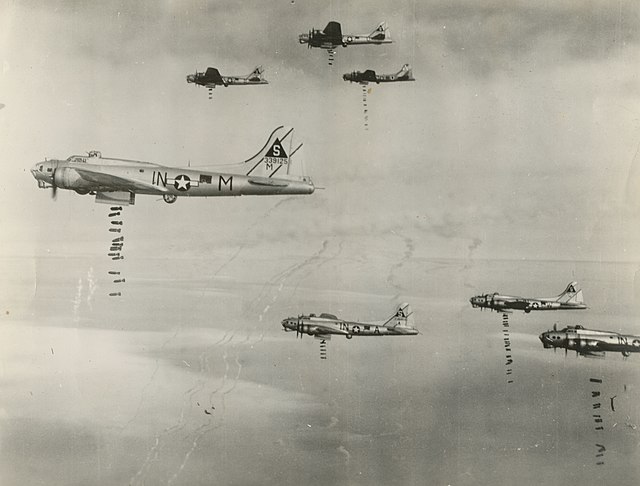 (US Ninth Air Force): In Germany, 350+ A-20s, A-26s and B-26s hit 3 airfields, 4 rail bridges, a junction, 5 towns, and 3 targets of opportunity as the interdiction operations continue; fighters escort the bombers, attack railroads and other special targets, fly patrols, sweeps, and armed reconnaissance, cover the Remagen area, and support the US XII Corps as it begins a drive from the Mosel River to the Rhine River, and the XX Corps operations W of Trier and Saarburg. Italian campaign The 71st Fighter Squadron, 1st Fighter Group, moves from Sallsola Airfield to Lesina, Italy with P-38s. (US Twelfth Air Force): In Italy, B-25s damage bridges at Casarsa della Delizia, Cittadella, Vipiteno, and Campo; fighters and fighter- bombers attack communications, ammunition and supply dumps, motor transport, trains, buildings, and other targets, escort medium bombers, and support ground forces, operating over much of N Italy from the Apennine battle area N and NE. A-20s hit river crossings and targets of opportunity in the Po Valley during the night of 13/14 Mar. Photo: 'A' Company, 1st Battalion of the Jewish Brigade ride on a Churchill tank in the Mezzano-Alfonsine sector, 14 March 1945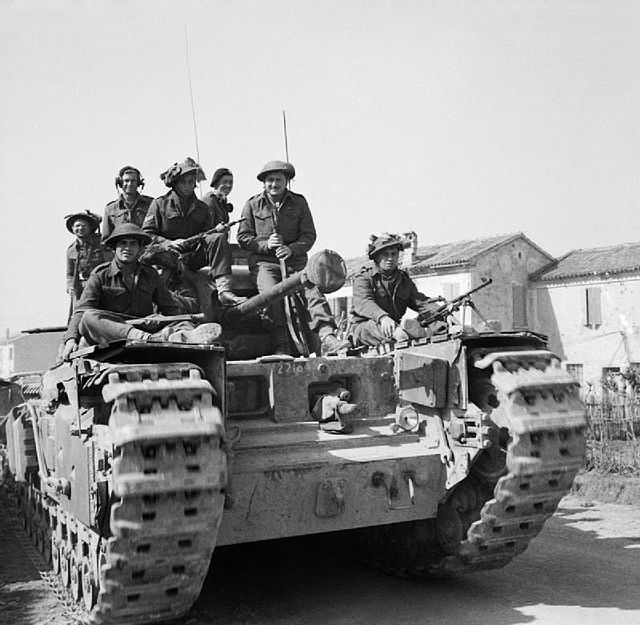 Pacific War Pacific War CHINA In China, 3 B-24s claim 1 cargo vessel sunk in the S China Sea; 1 B-25 and 4 fighter-bombers damage 12 track sections near Tungyangchen; and 4 P-51s hit railroad targets of opportunity near Chihsien. 19 P-51s and P-38s blast the barracks area at Vinh Yen, French Indochina. INDIA-BURMA (Tenth Air Force): In Burma, 20 P-47s fly close support for elements of the Chinese 50th Division in the Mansam area; 3 B-25s knock out a bridge at Laihka while 11 others bomb troop and a vehicle concentration nearby; 39 P-47s hit troop concentrations, supplies and vehicles at Laihka and Namlan while 29 others sweep roads S of the bomb line. 614 air supply sorties are flown to forward areas. The 165th Liaison Squadron (Commando), 1st Air Commando Group, moves from Asansol, India to Sinthe, Burma with UC-64s and L-5s and the 166th Liaison Squadron (Commando) moves from Sinthe to Asansol with the same aircraft. BURMA Maymo, to the east of Mandalay, is taken by the British 62nd Indian Brigade -- cutting the last rail line to Mandalay. Other units of the British 19th Indian Division are still engaged in Mandalay but most of the city has been capture in in a house-to-house fighting. Photo: Troops of 26th Division board a landing craft from a Royal Navy destroyer before coming ashore at Letpan on the Arakan coast, 14 March 1945 GUAM (Seventh Air Force):11 B-24s from Guam bomb Susaki Airfield while 23 from Angaur Airfield hit a Saragani Bay supply area on Mindanao . During the night of 14/15 Mar, 5 more B-24s flying individually hit Susaki Airfield. VII Fighter Command: 16 Iwo Jima based P-51s strafe and dive-bomb Susaki Airfield, the town of Okimura on Haha Jima, and several gun positions on Chichi Jima. The ground echelon of the 549th Night Fighter Squadron, VII Fighter Command, arrives on Iwo Jima from Hawaii (air echelon is operating from Saipan with P-61s). SOUTHWEST PACIFIC AREA [Far East Air Force]: B-24s bomb the Mako, Formosa naval base. B-25s on an armed reconnaissance and shipping sweep along the China coast bomb the secondary targets when no ships are sighted. The 2d Bombardment Squadron (Heavy), 22d BG (Heavy), moves from Guiuan Airfield to Clark Field with B-24s. PHILIPPINE CAMPAIGN (1945) On Mindanao, B-24s bomb the Konel area while B-25s and B-24s hit the village and AA positions near Zamboanga and dock area at Isabela. A-20s and numerous fighter-bombers (including some US Marine aircraft) hit installations and defensive positions throughout Luzon . A-20s over Palawan hit Pandanan. Photo: Infantrymen of Company I, 20th Infantry Regiment, 6th Infantry Division, advance up the side of a hill on the Kebayashi Line near Manila, Luzon, P.I, 14 March 1945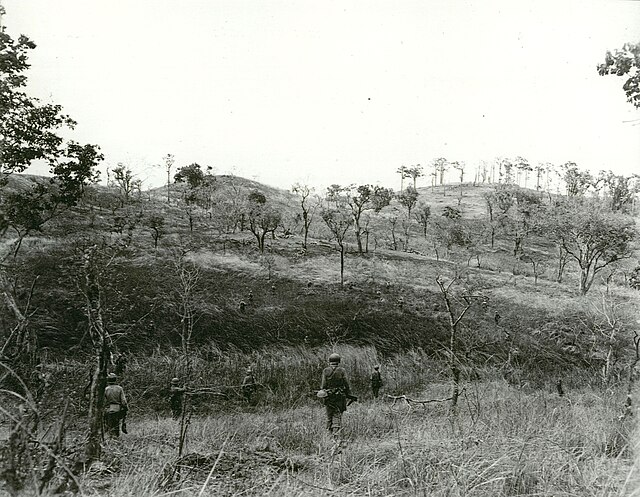 Photo: Infantrymen of I Co., 20th Inf., 6th Div., advance up the side of a hill on the Kebayashi Line near Manila, Luzon, P.I. 14 March, 1945 Photo: Infantrymen of I Co., 20th Inf., 6th Div., advance up the side of a hill on the Kebayashi Line near Manila, Luzon, P.I. 14 March, 1945 VOLCANO AND RYUKYU ISLANDS CAMPAIGN At 9:30 a.m. Americans consider the capture of Iwo Jima complete. PVs (VPB 151) begin operating from Iwo Jim's Motoyama Airfield No.1, thus bringing Japanese guardboats operating off the home islands within range of rocket-firing planes. ALASKA (Eleventh Air Force): Of 12 B-25s taking off to cover a naval task force on its way to Matsuwa in the Kurile s, 6 abort due to weather and failure to locate the task force; the others fly coverage sorties throughout the day. UNITED STATES NAVY DEPARTMENT COMMUNIQUES, CINCPOA COMMUNIQUÉ NO. 298, MARCH 14, 1945 Advances of 200 to 400 yards were made by the Fifth Marine Division on the northern end of Iwo Island on March 14 (East Longitude Date). From prepared positions the enemy continued to resist the pressure of our attacks and at nightfall the battle was continuing in this sector and in a small pocket in the Fourth Marine Division zone of action. Because of the complex system of caves in which enemy casualties have been trapped and sealed and because of the difficult conditions on Iwo Island an exact count of enemy losses is not possible. Counted burials plus very careful estimates as to numbers sealed in caves gives 20,000 as a very close approximation of enemy killed at end of March 14. That number is less than the detailed estimates made by commanders of front line troops. Our forces in the front lines have found "booby traps" set on the bodies of our dead. The United States Flag was formally raised over Iwo Island at 0930 on March 14 although some resistance continues. Planes of Navy, Army and Marine Corps are now operating from the island. Iwo‑based Army fighters made bombing and strafing attacks on airfield installations on Chichi Jima in the Bonins on March 14. On March 13, Army Liberators of the Strategic Air Force, Pacific Ocean Areas, bombed Chichi Jima airfield. Army Liberators of the Eleventh Air Force bombed airfield facilities at Kurabu Saki on southern Paramushiru in the Kuriles on the same date. The enemy sent up meager antiaircraft fire. Corsair and Hellcat fighters of the Fourth Marine Aircraft Wing destroyed a bridge, damaged two piers and set fuel dumps and motor facilities afire in the Palaus on March 14. Mopping up operations in the Marianas and Palaus continued. During March 4 through March 10, 48 of the enemy were killed on Saipan, Tinian and Guam and 13 prisoners were taken on Saipan, Guam and Peleliu. PACIFIC Destroyer Cotten (DD-669) and Dortch (DD-670) sink Japanese guardboats Futa Maru and No.17 Kaiko Maru off the Bonins, 30°58'N, 144°54'E. Submarine Bream (SS-243) sinks Japanese auxiliary submarine chaser Keihin Maru, 05°41'S, 114°03'E. Submarine Rock (SS-274) lands supplies on Lombok Island N.E.I. Submarine Trepang (SS-412) sinks Japanese guardboat Kaiko Maru off Inubosaki, 35°40'N, 141°00'E. British submarine HMS Spirit sinks Japanese auxiliary sailing vessel Ryuho Maru off Massalambo Island 05°34'S, 114°26'E. USAAF B-24 on antishipping sweep off south China coast sinks Japanese army ship No.3 Taisei Maru, 03°35'N, 112°10'E. USAAF B-29s (274 strong) pound Osaka; Japanese merchant cargo ships Shiraume Maru and Shirogane Maru are sunk in the fire bomb raid that lays waste to the heart of the city. USAAF B-24s damage Japanese auxiliary submarine chaser Cha 235 off Mako, Pescadores. Japanese auxiliary submarine chaser Yatsushiro Maru is damaged by aircraft, south of Wenchow, China. Attacks against Japanese convoy KAI-311 continue, and USAAF B-24s and B-25s sink small cargo vessel No.15 Gokoku Maru off south China coast. USAAF B-24 sinks small Japanese cargo vessel No.3 Taisei Maru off Hong Kong. Navy aircraft sink small Japanese cargo vessel No.1 Taiki Maru and damage guardboat No.1 Shinya Maru, 27°10', 132°09'E. Coastal yacht Amethyst (AMc-3) is damaged in collision with U.S. merchantman Platte Park 150 miles northwest of San Francisco.
|
|
lordroel
Administrator
Member is Online
Posts: 68,017 
Likes: 49,422
|
Post by lordroel on Mar 15, 2024 7:50:33 GMT
Day 2012 of World War II, March 15th 1945Eastern Front The Soviet 1st Ukrainian Front begins an offensive in the Ratibor area of Upper Silesia. Soviets begin a bombardment of besieged Breslau, and troops attack from all sides. Western Front (1945) - Western Allied invasion of GermanyMap: HQ Twelfth Army Group situation map, March 15th 1945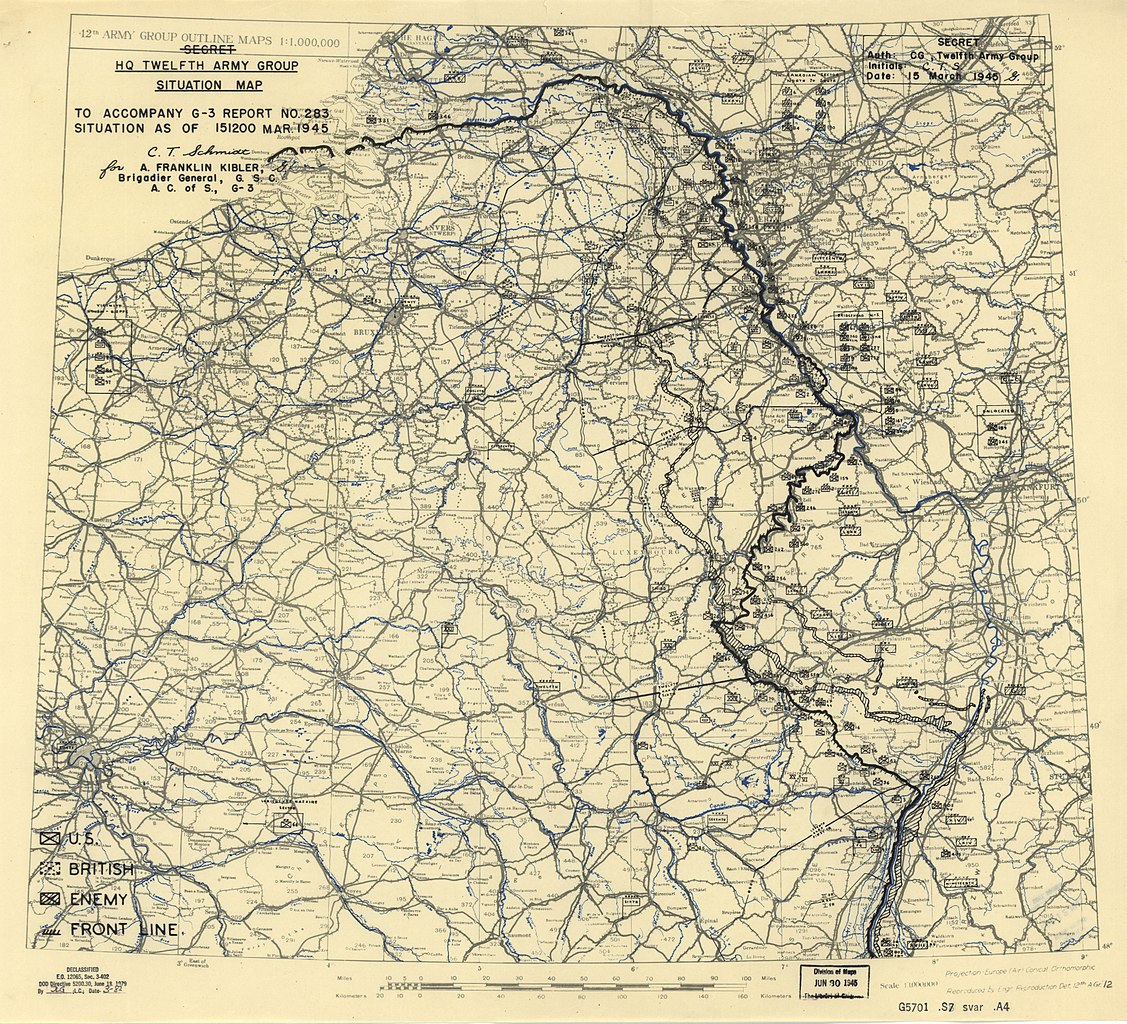 The US 7th Army launches attacks in the area around Saarbrucken and Bitche in a joint effort with US 3rd Army to eliminate German forces from the area between the Saar, Moselle and Rhine rivers. Photo: A Jadgpanther tank destroyer from schwere Panzerjäger-Abteilung knocked out on 15 March 1945 near Hargarten, Germany Photo: Panoramic view of upper Saar River Valley, taken from U.S. Third Army observation post on heights overlooking Serrig, Germany. 15 March, 1945 Photo: Panoramic view of upper Saar River Valley, taken from U.S. Third Army observation post on heights overlooking Serrig, Germany. 15 March, 1945 Photo: Men of the U.S. 94th Infantry Division, 3rd US Army, move up to the attack on Kell, Germany, 15 March 1945 Photo: Men of the U.S. 94th Infantry Division, 3rd US Army, move up to the attack on Kell, Germany, 15 March 1945 Western Front (1945) - Liberation of FrancePhoto: 7th U.S. Army infantrymen of the 7th Inf. Regt. prepare to rush house in which Nazi snipers are hidden. Guiderkirch, France. 15 March, 1945 Western Front (1945) - Liberation of FrancePhoto: 7th U.S. Army infantrymen of the 7th Inf. Regt. prepare to rush house in which Nazi snipers are hidden. Guiderkirch, France. 15 March, 1945 Air War over Europe Air War over Europe HQ 10th Photographic Group (Reconnaissance) and the 15th Tactical Reconnaissance Squadron move from Doncourt Airfield, Conflans and Giraumont, France respectively to Evren Airfield, Trier, Germany with F-6s; the 393d and 394th Fighter Squadrons, 367th Fighter Group, move from St Dizier to Conflans, France with P-47s; and the 411th Fighter Squadron, 373d Fighter Group, moves from Le Culot, Belgium to Venlo, the Netherlands with P-47s. 188 RAF aircraft - 150 Halifaxes, 24 Mosquitos, 14 Lancasters - of Nos 4, 6 and 8 Groups attacked oil plants at Bottrop and Castrop-Rauxel. Both raids were believed to have been successful. 1 Halifax of No 4 Group lost from the Bottrop raid. 16 RAF Lancasters of Nos 9 and 617 Squadrons attacked the viaduct at Arnsberg. Two aircraft of No 617 Squadron each carried a Grand Slam; the 14 aircraft of No 9 Squadron carried Tallboys. The viaduct was not cut. No aircraft lost. 267 RAF aircraft - 134 Lancasters, 122 Halifaxes, 11 Mosquitos - of Nos 4, 6 and 8 Groups attacked Hagen. 6 Lancasters and 4 Halifaxes lost. This area attack took place in clear visibility and caused severe damage; the local report estimated that the bomber force was 800 aircraft strong! The main attack fell in the centre and eastern districts. There were 1,439 fires, of which 124 were classified as large. 257 RAF Lancasters and 8 Mosquitos of Nos 1 and 8 Groups attacked the Deurag refinery at Misburg, on the outskirts of Hannover. Visibility was good and some fires were started but the main weight of the raid fell south of the target. 4 Lancasters lost. 54 RAF Mosquitos to Berlin, 27 to Erfurt, 16 to Mannheim and 5 each to Jena and Weimar, 53 RCM sorties, 37 Mosquito patrols. 1 RCM Fortress lost. (US Eighth Air Force): 2 missions are flown. Mission 889: 1,353 bombers and 833 fighters are dispatched to hit German Army HQ and a marshalling yard at Oranienburg; they claim 1-0-0 Luftwaffe aircraft; 9 bombers and 4 fighters are lost: 1. 308 of 372 B-24s and 276 of 300 B-17s hit the Germany Army HQ at Zossen, near Berlin visually; targets of opportunity for the B-24s are the Gardlingen rail center (31), the rail bridge at Parey (11) and other (3) and for B-17s, the marshalling yard at Stendal (13) and other (3); 1 B-24 is lost, 1 B-24 is damaged beyond repair and 32 B-24s and 20 B-17s are damaged; 4 airmen are KIA, 8 WIA and 21 MIA. Escorting are 397 P-51s and P-47s; they claim 1-0-0 aircraft in the air; 3 P-51s are lost (pilots MIA). 2. 612 of 675 B-17s attack the marshalling yard at Oranienburg visually; targets of opportunity are Wittenberg (31), Havelberg (12), the marshalling yards at Durstadt (1) and Mellendorf (1), Schmarsau (1) and Dedelstorf Airfield (1) some of which are hit with H2X radar; 8 B-17s are lost, 1 damaged beyond repair and 288 damaged; 8 airmen are WIA and 66 MIA. 320 of 352 P-51s escort; 1 is lost. 3. 6 B-17s fly a screening mission without loss. 4. 29 of 30 P-51s fly a scouting mission. 5. 9 P-51s fly a sweep of the Bonn-Koblenz area. 6. 9 of 12 P-51s escort 24 F-5s and 4 Spitfires on photo reconnaissance missions over Germany. Mission 890: 14 of 16 B-24s bomb the rail station at Munster during the night using PFF methods. (US Ninth Air Force): In Germany, 9th Bombardment Division A-20s, A-26s, and B-26s attack communications centers at Neunkirchen and Pirmasens, marshalling yards at Turkismuhle and Erbach, 3 flak positions, and several other targets, as well as dropping leaflets on Koblenz; fighters hit the Overberge marshalling yard and other targets, escort the bombers, fly sweeps and armed reconnaissance, and support the US XII Corps crossing the Mosel River in an offensive toward the Rhine River, and the XX Corps E of Trier and Saarbrucken. (US Fifteenth Air Force): In Germany, 109 B-17s bomb the oil refinery at Ruhland (marking the Fifteenth's deepest penetration into Germany). 103 others bomb the alternate target, the refinery at Kolin, Czechoslovakia. 470+ other bombers attack targets in Austria, including Moosbierbaum, Schwechat, and Vienna/Floridsdorf oil refineries, marshalling yards at Wiener-Neustadt, Sankt Polten, Graz, Bruck an der Mur, Klagenfurt, and Murzzuschlag, and a bridge at Klagenfurt. Supply missions to N Italy and Yugoslavia continue, along with extensive photo and weather reconnaissance. Fighters fly 300+ sorties in escort of the bombers and supply and reconnaissance flights. Italian campaign (US Twelfth Air Force): In Italy, B-25s attack railroad bridges and fills at Salzano, Canale d'Isonzo, Rovereto, Palazzolo sull'Oglio, Romano di Lombardia, and Mori; fighters and fighter-bombers of the XXII Tactical Air Command concentrate on communications lines in NE Italy, particularly the Brenner rail line, and also blast several supply and ammunition dumps; A-20s continue intruder missions during the night of 14/15 Mar, hitting Po River crossings and fills in the San Ambrogio di Valpolicella area. Destroyer 'Parker' (DD-604) and three British destroyers carry out anti-shipping sweep in the Gulf of Genoa, but encounter no enemy vessels. United StatesPhoto: The U.S. Navy destroyer USS Wiley (DD-597) off the Puget Sound Naval Shipyard, Washington (USA), on 15 March 1945. Wiley was the last commissioned Fletcher-classs destroyer, being commissioned on 22 February 1945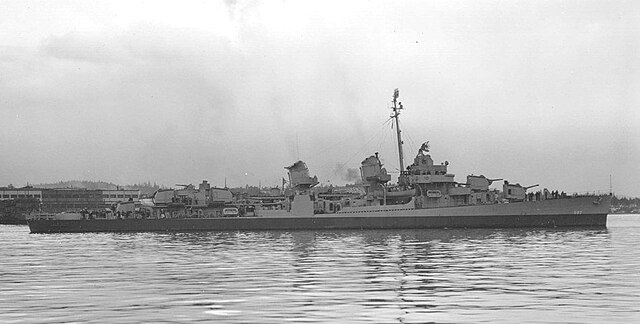 Photo: The U.S. Navy destroyer USS Douglas H. Fox (DD-779) underway with almost no way on, slightly backing down, off the Puget Sound Navy Yard, Bremerton, Washington (USA), on 15 March 1945. Note crew members at sea & anchor detail. The ship is painted in Camouflage Measure 22. She has haze grey bloomers on Mount 51, while Mount 52 has black bloomers Photo: The U.S. Navy destroyer USS Douglas H. Fox (DD-779) underway with almost no way on, slightly backing down, off the Puget Sound Navy Yard, Bremerton, Washington (USA), on 15 March 1945. Note crew members at sea & anchor detail. The ship is painted in Camouflage Measure 22. She has haze grey bloomers on Mount 51, while Mount 52 has black bloomers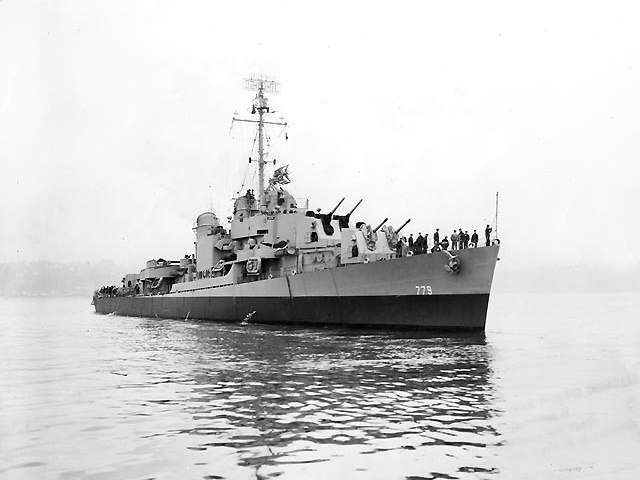 Photo: The U.S. Navy heavy cruiser USS Saint Paul (CA-73) underway in Massachusetts Bay, 15 March 1945 Photo: The U.S. Navy heavy cruiser USS Saint Paul (CA-73) underway in Massachusetts Bay, 15 March 1945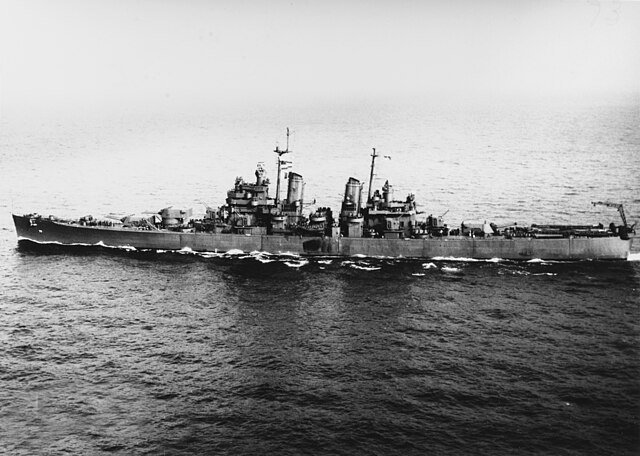 Pacific War Pacific WarCHINA (Fourteenth Air Force): 4 B-24s claim 1 vessel sunk in the S China Sea. In China, 4 B-25s hit the area E of Pingsiang; 4 P-51s hit locomotives between Sinsiang and Shihkiachwang and 4 attack motor transport in the Paotou area. INDIA-BURMA (Tenth Air Force): In Burma, 30 P-47s support elements of the Chinese 50th Division in the Namhsan area; 32 P-38s sweep roads S of the bomb line. Transports fly 625 sorties to forward areas. BURMA Japanese forces intensive their efforts against Meiktila but fail to make significant progress against the British 17th Indian Division which is receiving supplies, reinforcements and ground attack support from the air. Photo: Crew members of 'Cairngorm', a Sherman tank of 116th Regiment, Royal Armoured Corps, between Taungtha and Meiktila, 15 March 1945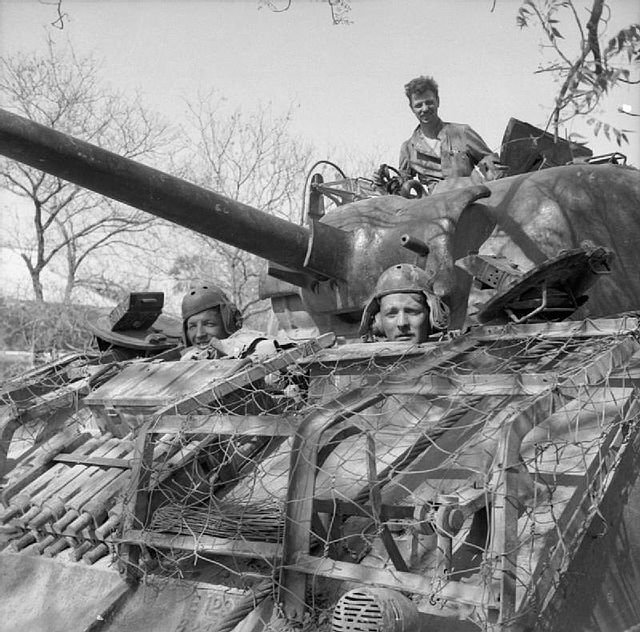 Photo: Captain Weir and Corporal Picken in the turret of their Sherman tank, 'Cairngorm', 116th Regiment, Royal Armoured Corps, between Taungtha and Meiktila, 15 March 1945 Photo: Captain Weir and Corporal Picken in the turret of their Sherman tank, 'Cairngorm', 116th Regiment, Royal Armoured Corps, between Taungtha and Meiktila, 15 March 1945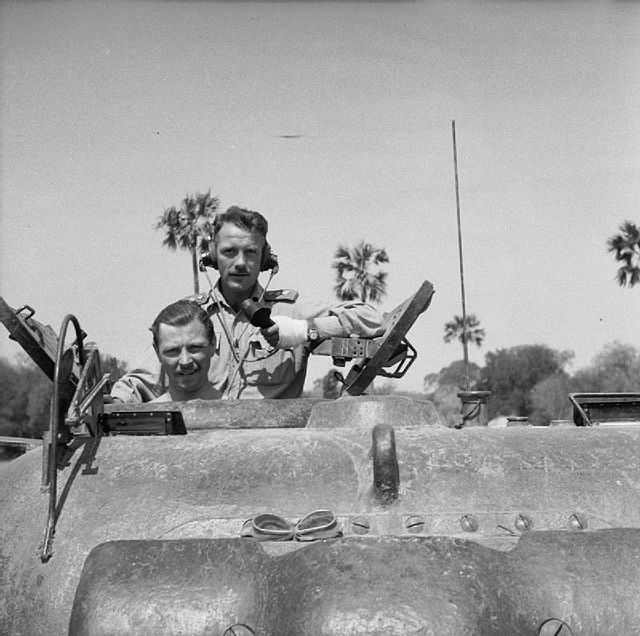 GUAM (Seventh Air Force): 8 Guam based B-24s bomb Susaki Airfield; 3 more, on snooper strikes, hit the airfield during the night of 15/16 Mar. PHILIPPINE CAMPAIGN (1945) In support of US ground forces on Luzon, B-24s, A-20s, and P-38s hit a HQ area at Baguio; P-47s hit Minuli bridge and enemy concentrations in the Balete Pass and W of Ft Stotsenburg; and A-20s and P-47s hit gun positions and occupied areas around Batangas. On Mindanao, B-24s and B-25s hit personnel N of Saragani Bay and troops and gun positions in the Zamboanga area. Photo: All supplies must be carried up this 55 grade to the fighting at the top. Villa Verde Trail, Luzon, P.I. 15 March, 1945 VOLCANO AND RYUKYU ISLANDS CAMPAIGN On Iwo Jima, US 5th Amphibious Corps continues to engage the Japanese forces which are now confined a small area in the northwest of the island. SOUTHWEST PACIFIC AREA B-24s bomb Lahug. P-47s dive-bomb Takao power installations on Formosa. HQ 22d BG and the 19th Bombardment Squadron move from Guiuan Airfield to Clark Field with B-24s; the 100th Bombardment Squadron (Medium), 42d BG (Medium), moves from Sansapor to Palawan with B-25s; the 403d Bombardment Squadron (Heavy), 43d BG (Heavy), moves from Tacloban to Clark Field with B-24s. JAPAN TF 92 (Rear Admiral John L. McCrea), consisting of light cruisers Richmond (CL-9), Concord (CL-10) and Trenton (CL-11) and seven destroyers, bombards Japanese installations on Matsuwa, Kurils. ALASKA (Eleventh Air Force): 1 B-24 flies air coverage for a naval task force; 7 others weather-abort. UNITED STATES NAVY DEPARTMENT COMMUNIQUES, CINCPOA COMMUNIQUÉ NO. 299, MARCH 15, 1945 The Fifth Marine Division on March 15 (East Longitude Date) continued to reduce further the area held by the enemy at the northern tip of Iwo Island. Our forces encountered intense small arms and mortar fire in that sector throughout the day. Mopping up operations were continued in the Third and Fourth Marine Division zones of action. Planes of the Seventh Army Fighter Command bombed airfields and other installations on Chichi Jima in the Bonins on the same date. On March 14 Liberators of the Seventh Army Air Force, operating under the Strategic Air Force, bombed Chichi Jima airfield. Navy search Privateers of Fleet Air Wing Two bombed Wake Island through meager antiaircraft fire on March 14. On the same date Corsair fighters of the Fourth Marine Aircraft Wing continued neutralizing attacks on enemy‑held bases in the Marshalls. UNITED STATES NAVY DEPARTMENT COMMUNIQUES, CINCPOA PRESS RELEASE NO. 34, MARCH 15, 1945 Iwo Jima, Volcano Islands, Mar. 14.‑(Delayed)‑With the rattle of musketry to the north, where the remnants of the Japanese garrison force were being exterminated by Marines, faintly audible, the United States government today officially took possession of this desolate but strategic island on the road to Tokyo. It did so in a proclamation issued by Fleet Admiral Chester W. Nimitz, Commander in Chief of the Pacific Fleet and Pacific Ocean Areas and military governor of the Volcano Islands. After the proclamation had been read, the American flag was officially raised over the island. The ceremony, held in the shadow of Suribachi, extinct volcano at the southern tip of Iwo, and attended by high ranking officers of the Marine Corps, Navy and Army, was marked by simplicity. Deep‑throated roars of nearby Marine field pieces drowned the voice of Marine Colonel D. A. Stafford, of Spokane, Wash., Fifth Amphibious Corps personnel officer, as he read the words suspending all powers of government of the Japanese Empire on the island. The Stars and Stripes were run up on a staff atop a strongly reinforced Japanese bunker with an anti‑aircraft gun emplacement above it. The military notables formed in rank on one side of the staff. On the other, an honor guard composed of eight military policemen from each of the three divisions that participated in the seizure of the island, was drawn up. Among the military and naval leaders who planned and executed the invasion were: Vice Admiral Richmond Kelly Turner, USN, Commander, Amphibious Forces, Pacific; Rear Admiral Harry Hill, USN, of Oakland, Cal., deputy commander of the attack force; Lieutenant General Holland M. Smith, Commanding General of the Fleet Marine Force of the Pacific; Major General Harry F. Schmidt, Fifth Amphibious Corps Commander; Major General Graves B. Erskine, of La Jolla, Cal., Third Marine Division commander, and his chief of staff, Colonel Robert E. Hogaboom, of Vicksburg, Miss.; Major General Clifton B. Cates, Fourth Marine Division Commander, and his chief of stag, Colonel M. J. Batchelder; and Major General Keller Rockey, Fifth Marine Division Commander, and his chief of staff, Colonel Ray A. Robinson. The Army was represented at the ceremony by Major General James E. Chaney. While Marine Private First Class John E. Glynn (309599), 21, of 2319 Humanity Street, New Orleans, La., veteran of Guadalcanal, sounded "Colors", Old Glory was sent fluttering in the breeze to the top of the flagstaff by Marine Privates First Class Thomas J. Casale (411750), 20, of (no street address) Herkimer, N. Y., and Albert B. Bush (437298), 24, of 16712 Woodbury Avenue, Cleveland, Ohio. Marine Sergeant Anthony C. Yusi (285607), 25, of 68 Grove Street, Port Chester, N. Y., was in charge of the color detail. The bugler and the color detail were chosen from the Fifth Amphibious Corps Military Police Company. Their commanding officer, First Lieutenant Nathan R. Smith, of Whitehaven, Pa., said the men had been selected for general efficiency and military bearing. Both Yusi and Bush took part in the seizure of Saipan and Tinian in the Marianas. Moreover, Yusi was serving aboard the USS Wasp when she was sunk by the Japs September 15, 1943. The proclamation was the first issued by Fleet Admiral Nimitz as military governor of the Volcano Islands. It was addressed, in Japanese as well as English, to the people of the islands. It read: "I, Chester William Nimitz, Fleet Admiral, United States Navy, Commander in Chief of the United States Pacific Fleet and Pacific Ocean Areas, do hereby proclaim as follows: "United States Forces under my command have occupied this and other of the Volcano Islands. "All powers of government of the Japanese Empire in the islands so occupied are hereby suspended. "All powers of government are vested in me as Military Governor and will be exercised by subordinate commanders under my direction. "All persons will obey promptly all orders given under my authority. Offenses against the Forces of Occupation will be severely punished. "Given under my hand at Iwo Jima this fourteenth day of March, 1945." The ceremony took place as the battle for Iwo Jima entered its 24th day. The stubborn Japanese defenders had been driven northward to the end of the island. The enemy was still defending his caves and bunkers to the death. As the official flag was raised, the one that had flown over Suribachi since the fifth day of the battle was lowered. The Stars and Strips had been planted on the volcano by the Marines who wrested it from the Japs. The place selected for the official flag is just off the beach in the southwestern section of the island. Selection of the site was prompted by convenience and the height of the ground. Several hundred dirty, bearded and weary Marines working and bivouacked in the vicinity gathered to witness the brief ceremony, which required less than 10 minutes. They, as well as the participants, came smartly to attention and saluted while the bugler was sounding colors. PACIFIC Submarine Bream (SS-243) is damaged by depth charges off North Borneo, 05°36'N, 114°33'E, and is forced to terminate her patrol. USAAF B-24s bomb Japanese convoy YUMO-01, which had departed Hong Kong the day before, but while the attack upon cargo ship Tatsumiya Maru proves unsuccessful, the Liberators damage one of the escorts, Coast Defense Vessel No.36, 23°03'N, 116°52'E. USAAF B-24 sinks Japanese auxiliary powered sailing vessel Hoseki Maru in Tonkin Gulf, 18°34'N, 108°37'E. Japanese submarine chaser Ch 21 is damaged by marine casualty off the south end of Namoa Island. Japanese netlayer Wakamiya Maru is damaged by marine casualty off Keelung, Formosa.
|
|
lordroel
Administrator
Member is Online
Posts: 68,017 
Likes: 49,422
|
Post by lordroel on Mar 16, 2024 15:08:31 GMT
Day 2013 of World War II, March 16th 1945YouTube (Smiling Albert Takes Command)Eastern FrontThe Soviet forces in Hungary, of 3rd Ukrainian Front, have regrouped following the German attacks, of Army Group South, around Lake Balaton and begin an offensive against the northern flank of the recently won German salient. The Hungarian 3rd Army takes the brunt of the first assaults and is soon in great difficulty. General der Infanterie von Krosigk 16th Army is killed at Kanden in Courland. Western Front (1945) - Western Allied invasion of GermanyMap: HQ Twelfth Army Group situation map, March 16th 1945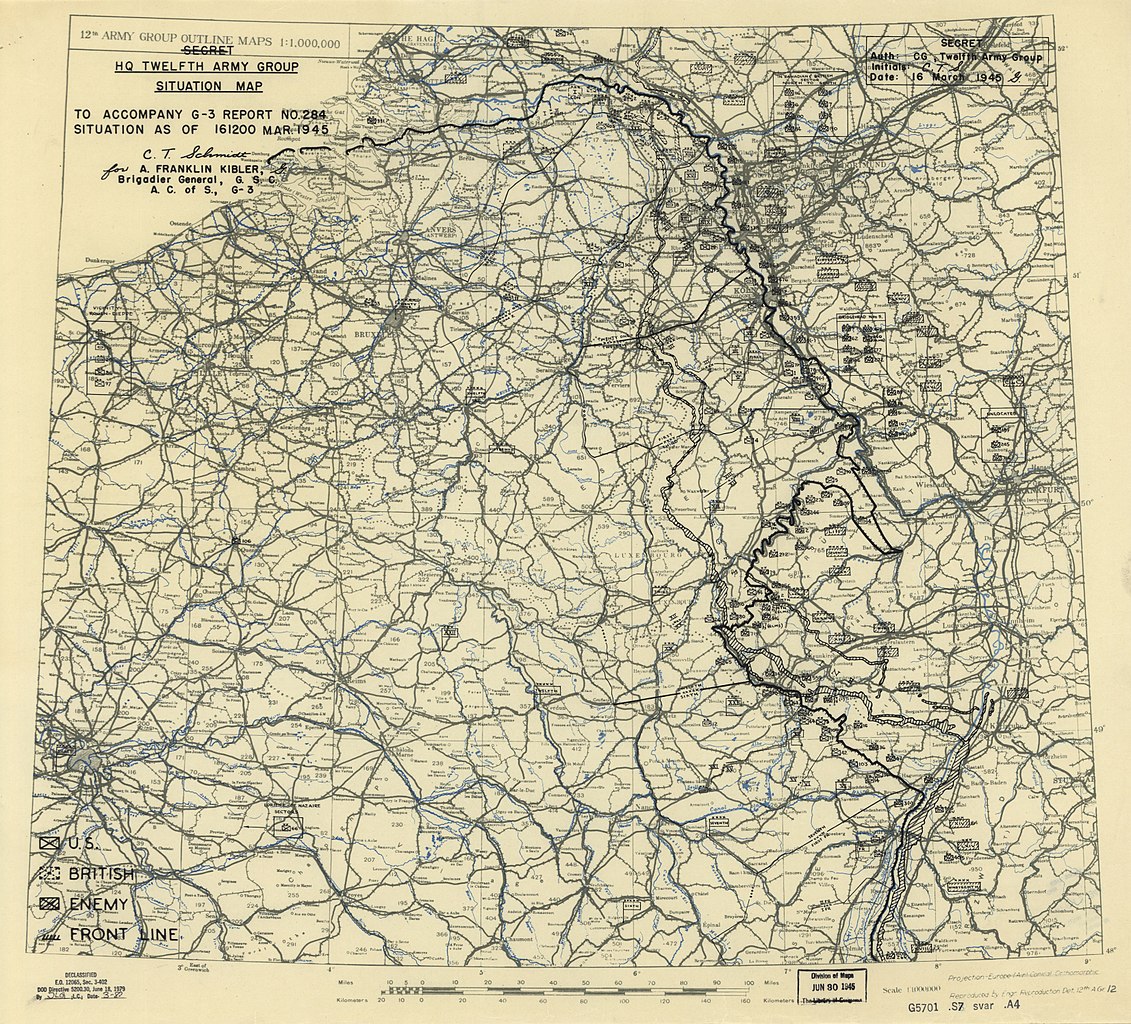 Allied forces make an attack along the Saar Basin. US 7th Army takes Bitche as the Siegfried Line begins to break. Photo: A jeepload of 94th Div., 3rd U.S. Army medics moves through the ruined streets of Hermeskeil, Germany. 16 March, 1945 Photo: "Mayen, Germany. Sgt. John Hylass, Brentwood, N.J., personal Military Policeman to guard Maj. Gen. Manston S. Eddy, CG of the XII Corps, U.S. Third Army, stands watch with a .50 caliber machine gun mounted on a jeep while General Eddy pays a visit to his Command Post in Mayen. In the background is the famous Castle of Mayen which dates back to the days of Charlemagne," 16 March, 1945 Photo: "Mayen, Germany. Sgt. John Hylass, Brentwood, N.J., personal Military Policeman to guard Maj. Gen. Manston S. Eddy, CG of the XII Corps, U.S. Third Army, stands watch with a .50 caliber machine gun mounted on a jeep while General Eddy pays a visit to his Command Post in Mayen. In the background is the famous Castle of Mayen which dates back to the days of Charlemagne," 16 March, 1945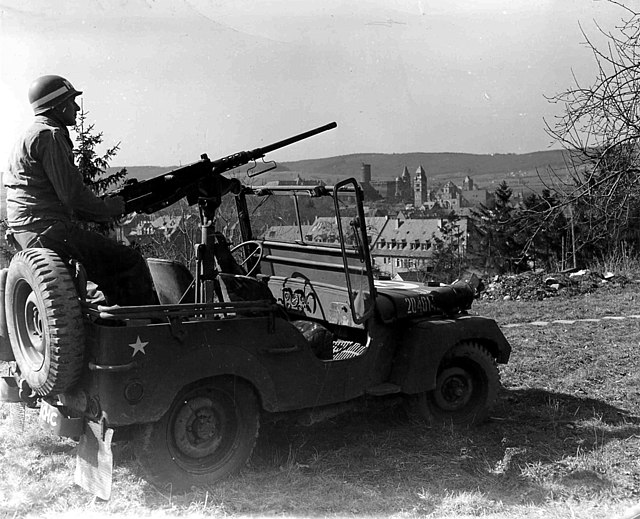 Photo: A halftrack of the 10th Armored Division, U.S. Third Army, parks near smoldering building in newly captured Kall, Germany. 16 March, 1945 Photo: A halftrack of the 10th Armored Division, U.S. Third Army, parks near smoldering building in newly captured Kall, Germany. 16 March, 1945 Photo: 5th Infantry Division units of 3rd U.S. Army move up through town of Chorweiler, Germany. 16 March, 1945 Photo: 5th Infantry Division units of 3rd U.S. Army move up through town of Chorweiler, Germany. 16 March, 1945

Photo: Men of the 5th Inf. Div., U.S. Third Army, file through Nazi roadblock into the newly captured town of Corweiler, Germany. 16 March, 1945

Air War over EuropeHQ 365th Fighter Group moves from Juzaine Airfield, Florennes, Belgium to Aachen; the 153d Liaison Squadron, IX Tactical Air Command (attached to Twelfth Army Group), moves from Duren to Euskirchen with L-5s; and the 392d Fighter Squadron, 367th Fighter Group, moves from St Dizier to Conflans, France with P-47s. Raid on Nuremburg by 231 RAF Lancasters of No 1 Group and 46 Lancasters and 16 Mosquitos of No 8 Group. 24 Lancasters, all from No 1 Group, lost, 8.7 per cent of the Lancaster force and 10.4 per cent of the No 1 Group aircraft involved. Most of these losses were due to German night fighters, which found the bomber stream on its way to the target. A local report states that the southern and south-western districts were hit as well as the ruins of the Altstadt which was destroyed in a previous raid. A serious fire was established in the Steinbuhl district. The main railway station was also on fire and the city's gasworks were so badly damaged that they did not resume production before the end of the war. This was the last heavy Bomber Command raid on Nuremberg. 225 RAF Lancasters and 11 Mosquitos of No 5 Group attacked Würzburg. 6 Lancasters lost. This was another dramatic and devastating blow by No 5 Group. 1,127 tons of bombs were dropped with great accuracy in 17 minutes. According to a post-war survey, the old cathedral city with its famous historic buildings suffered 89 per cent of its built-up area destroyed. Würzburg contained little industry and this was an area attack. 56 RAF Mosquitos to Berlin, 24 to Hanau and 6 each to Brunswick and Osnabrück, 32 RCM sorties, 40 Mosquito patrols, 12 Halifaxes and 12 Lancasters minelaying in the Kattegat and off Heligoland. No aircraft lost. Gerhard Friedrich, a night-fighter with thirty victories and a former transport pilot, is killed in action. Near Nurnberg Hptm. Martin "Tino" Becker, Gruppenkommandeur of IV./NJG 6 flying a Ju 88 G-6 "2Z+MF" destroys a RAF Lancaster for his fifty-eighth night victory. It will be his last victory of the war. (US Ninth Air Force): In Germany, 280+ A-20s, A-26s and B-26s hit the Landau barracks area and communications center, the Niederscheld town area and rail bridge, 6 other town areas, a marshalling yard, rail junction, crossroads, and also drop leaflets; fighters escort the bombers, fly patrols, sweeps, armed reconnaissance, and cover the VIII, XII, and XX Corps in an assault across the Mosel River from W of Koblenz and N of Boppard, at one point, as far E as Bad Kreuznach, and as far S as Merzig. (US Fifteenth Air Force): 720+ B-24s and B-17s bomb the Korneuburg, Vienna/Floridsdorf, Schwechat, and Moosbierbaum, Austria oil refineries and marshalling yards at Sankt Veit an der Glan, Amstetten, and Graz, Austria and Varazdin and Pragersko, Yugoslavia; 52 P-51s strafe rail lines in the Vienna and Linz, Austria and Passau and Regensburg, Germany areas and the airfield at Mettenheim, Germany. B-17s and B-24s continue supply drops to N Italy and Yugoslavia while F-5s and P-38s fly extensive weather and photo reconnaissance missions; fighters fly 300+ sorties in escort of the bombers, supply runs, and reconnaissance operations. Italian campaign HQ 1st Fighter Group and the 27th and 94th Fighter Squadrons move from Salsola Airfield to Lesina, Italy with P-38s. (US Twelfth Air Force): B-25s of the 57th Bombardment Wing, flying their farthest N penetration to date, bomb the Brixlegg, Austria railroad bridge. In Italy, B-25s also hit the Spilimbergo power plant, with excellent results, and lightly damage 3 bridges on the Brenner line, 1 in the C Po Valley, and 1 in NE Italy; XXII Tactical Air Command fighter-bombers continue to attack communications in the Po Valley and NE Italy, while A-20s bomb bridges and targets of opportunity on night intruder missions along the Po R and in the N Po Valley. Battle of the AtlanticAt 0920, the 'Inger Toft' in Convoy RU-156 was torpedoed and sunk by 'U-722' 3 miles 270° from Neirst Point, Isle of Skye. The master and 29 crewmembers were picked up by armed trawler HMS 'Grenadier' and landed at Loch Ewe. The Coast Guard-manned destroyer escorts USS 'Lowe', 'Menges',' Pride', and 'Mosely', which comprised Task Group 22.14, located the submerged German submarine 'U-866' off the coast of Sable Island and sank it with a loss of all hands. Battle of the Baltic Sea The German heavy vessels 'Schlesien' and 'Prinz Eugen' support the forces of Heeresgruppe Kurland in their defense against heavy Soviet attacks to break up the Kessel. 'U-367' sank in the Baltic Sea near Hela, in position 54.25N, 18.50E, after hitting a mine laid by the Soviet submarine L-21 three days earlier. 43 dead (all hands lost). Photo: The U.S. Navy landing craft repair ship USS Minos (ARL-14) underway on 16 March 1945. She is painted in a as yet unidentified camouflage pattern, probably in greens. Minos was sent 31/5L through Jacksonville Shipyard, Florida (USA), on 6 February 1945 but the patterns seem to match a version of Design 8L for LCI(L)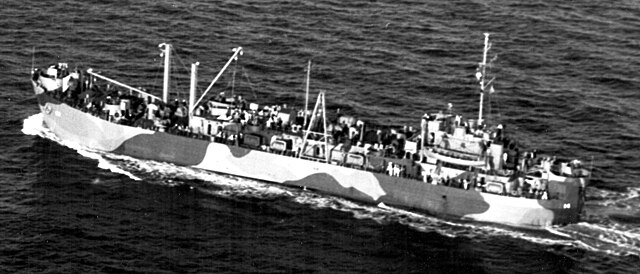 Pacific War Pacific WarCHINA (Fourteenth Air Force): In China, 32 B-24s, escorted by 10 P-51s, pound the N railroad yards at Shihkiachwang; 1 B-25 and 2 P-51s attack the railroad between Sinsiang and Shihkiachwang; the detachment of the 16th Fighter Squadron, 51st FG, operating from Laohokow with P-51s, returns to base at Chengkung (another detachment is operating from Poseh). INDIA-BURMA (Tenth Air Force): In Burma, 23 P-47s support forces of the Chinese 50th Division in the Hsipaw area; 4 P-38s, supporting the British 36 Division, bomb artillery positions NE of Mogok; 12 B-25s blast a fuel dump and troop concentration at Panghai; and 40 P-38s sweep roads S of the bomb line. Transport operations continue on a steady basis. GUAM Seventh Air Force: 13 Guam based B-24s bomb Susaki Airfield; during the night of 16/17 Mar, Susaki Airfield is hit again, by 5 B-24s flying individual harassment strikes. Iwo Jima is declared secure although fierce resistance continues on some parts of the island. VII Fighter Command: 16 Iwo Jima based P-51s dive-bomb and strafe radio and radar installations, gun positions, and a storage area on Chichi Jima. In Mar 45 HQ VII Fighter Command will be established on Iwo Jima from where some of its units escort B-29 missions. (Twentieth Air Force): Mission 43: 307 XXI Bomber Command B-29s, of 331 airborne, fire-raid Kobe in the heaviest attack to date, bombing from 5,000 to 9,500 feet during the predawn hours of 16/17 Mar; the attack lasts for 2 hours and 8 minutes; about 2.9 square miles, i.e., 20%, of the city's area is burned destroying about 500 industrial buildings and damaging 162; 65,951 homes are lost leaving 242,468 people homeless. Casualties are 2,669 dead or missing and 11,289 injured. The B-29 crews see 314 enemy aircraft which make a total of 93 individual attacks; the AAF claims 1-0-? Japanese aircraft; 3 B-29s are lost, none to the fighters. SOUTHWEST PACIFIC AREA [Far East Air Force]: On Formosa, B-24s also hit the town of Taihoku, airfields at Heito, and the Okayama naval airbase. HQ 43d BG and the 65th Bombardment Squadron (Heavy) move from Tacloban, Leyte to Clark Field, Luzon with B-24s; the 419th Night Fighter Squadron, XIII Fighter Command, moves from Middelburg to Puerto Princesa, Palawan with P-61s. PHILIPPINE CAMPAIGN (1945) Transported in medium landing craft (LCM) and one submarine chaser (SC), and supported by gunfire from three destroyers, two LCI(R), three LCS(L) and 2 LCI(M), Army troops (a reinforced company) of the US 41st Division lands on Basilan Island. Here, as on other small islands, the US forces to subdue the Japanese garrison during the first few days of battle and then mostly to withdraw, leaving the mopping up to Filipino irregulars. Meanwhile, fighting continues on Luzon, with US 14th Corps engaged along the Japanese held Shimbu Line, southeast of Manila, while the US 1st Corps is engaged to the north on the Villa Verde track. On Luzon, A-20s and B-24s continue pounding Japanese installations at Baguio; P-51s strike Patapat, hitting vehicles and supplies; fighters on patrol hit Caballo in Manila Bay; the Batangas area is again pounded by fighter-bombers and A-20s. B-24s hit Talisay and Carolina Airfields on Negros and bomb targets pinpointed by guerrillas on Cebu. B-25s bomb San Roque Airfield on Mindanao and attack Tarakan and Jesselton Airfields. ALASKA (Eleventh Air Force): Because of a navigational error, 2 B-24s on a photo mission to Matsuwa reach 130 miles S of the island, the deepest penetration of the Japanese Home s to date; the B-24s turn N, photograph Matsuwa and bomb Shimushiru with unobserved results. UNITED STATES NAVY DEPARTMENT COMMUNIQUES, CINCPOA COMMUNIQUÉ NO. 300, MARCH 16, 1945 The battle of Iwo Island has been won. The United States Marines by their individual and collective courage have conquered a base which is as necessary to us in our continuing forward movement toward final victory as it was vital to the enemy in staving off ultimate defeat. The enemy was fully aware of the crushing attacks on his homeland which would be made possible by our capture of this island only 660 nautical miles distant, so he prepared what he thought was an impregnable defense. With certain knowledge of the cost of an objective which had to be taken, the Fleet Marine Force supported the ships of the Pacific Fleet and by Army and Navy aircraft fought the battle and won. By their victory the Third, Fourth and Fifth Marine Divisions and other units of the Fifth Amphibious Corps have made an accounting to their country which only history will be able to value fully. Among the Americans who served on Iwo Island, uncommon valor was a common virtue. Organized resistance on Iwo Island ceased at 1800 on March 16 (East Longitude Date) when elements of the Third and Fifth Marine Divisions drove through the enemy lines breaking them up and reached Kitano Point at the northern end of the island. UNITED STATES NAVY DEPARTMENT COMMUNIQUES, CINCPOA COMMUNIQUÉ NO. 301, MARCH 16, 1945 The Marines on Iwo are continuing to mop up remnants of the enemy garrison. The central Iwo airfield was placed in operation on March 16 (East Longitude Date). Army aircraft of the Seventh Fighter Command bombed and strafed targets on Chichi Jima in the Bonins on the same date. On March 15, Army Liberators of the Seventh Air Force operating under the Strategic Air Force, Pacific Ocean Areas, bombed airfield installations on Chichi Jima. Fighters and Torpedo planes of the Fourth Marine Aircraft Wing destroyed bridges and damaged piers and other installations in the Palaus on March 15. On the following day barges were destroyed and fires were started on and around Babelthuap and Arakabesan in the same group. Radio, airfield and harbor installations on Yap in the Western Carolines were bombed by Marine Aircraft on March 15 and 16. Neutralizing raids on enemy held bases in the Marshalls were carried out by planes of Fleet Air Wing Two and the Fourth Marine Aircraft Wing on March 15. PACIFIC Tank landing ship LST-928 is damaged, by grounding, off Iwo Jima, 24°46'N, 141°19'E. Japanese Coast Defense Vessel No.69 sinks while in tow, eight miles off Hong Kong, 22°00'N, 113°40'E, as the result of damage inflicted by USAAF B-24s (14th Air Force) on 8 March. Japanese guardboat No.19 Gokoku Maru is sunk by U.S. aircraft, Kikaiga Jima, Japan. Japanese merchant tanker No.1 Nanryu Maru is sunk by aircraft, 29°09'N, 122°01'E.
|
|
lordroel
Administrator
Member is Online
Posts: 68,017 
Likes: 49,422
|
Post by lordroel on Mar 17, 2024 8:44:25 GMT
Day 2014 of World War II, March 17th 1945Western Front (1945) - Western Allied invasion of GermanyMap: HQ Twelfth Army Group situation map, March 17th 1945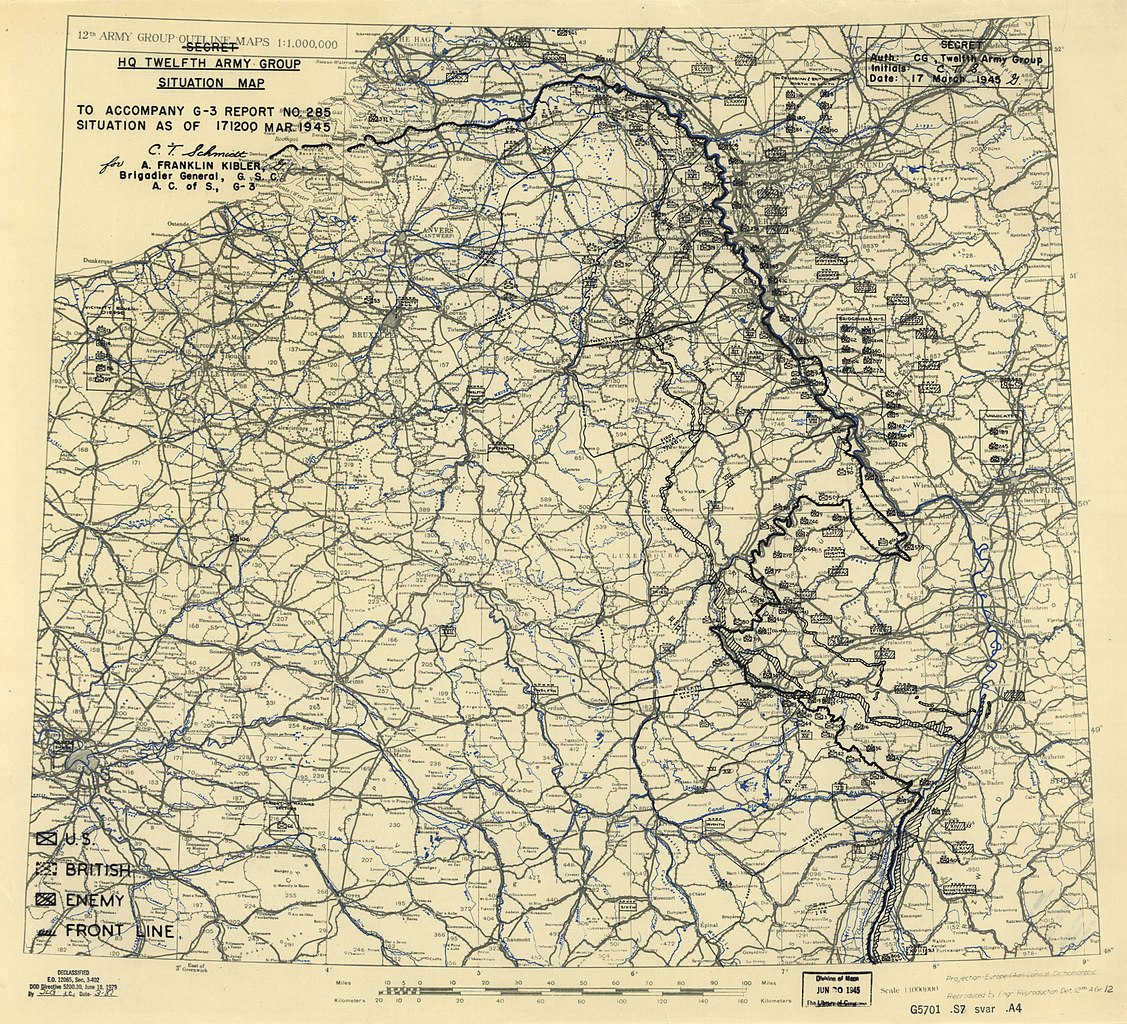 The Ludendorff Bridge over the Rhine River, at Remagen, collapses under the combined strain of bomb damage and heavy use but US Army engineers have built several other bridges nearby and the advance over the Rhine continues. Photo: "U.S. First Army at Remagen Bridge before four hours before it collapsed into the Rhine," 17 March 1945 To the south, the US 3rd Army offensive over the Moselle River takes Koblenz and Boppard on the left flank of the drive while farther forward, the Nahe River has been crossed. Photo: The destroyed 4-track railroad bride over the river Saar at Konz, Germany, 17 March 1945. Note the pontoon bridge on the right Eisenhower orders Patton not to advance toward Czechoslovakia, although there is nothing to stop him reaching Prague before the Russians. Photo: Field Marshal Montgomery crossing the Maas with some of his troops in a Buffalo amphibious carrier, during rehearsals for the Rhine crossing, 17 March 1945 Air War over Europe Air War over EuropeThe 386th Fighter Squadron, 365th Fighter Group, moves from Juzaine Airfield, Florennes, Belgium to Aachen, Germany with P-47s. 167 RAF Lancasters of No 3 Group carried out G-H attacks through cloud on benzol plants at Dortmund and Hüls. Both raids appeared to be accurate. No aircraft lost. 66 Lancasters and 29 Halifaxes from training units on a sweep over Northern France to draw up German fighters, 39 Mosquitos to Nuremberg, 38 to Berlin and 2 each to Mannheim and Stuttgart, 6 RCM sorties, 15 Mosquito patrols. 1 Intruder Mosquito of No 100 Group lost. (US Eighth Air Force): 2 missions are flown. Mission 892: 1,328 bombers and 820 P-51s are dispatched to hit oil, industrial and rail targets in Germany; clouds extend from 1,000 to 15,000 feet (305 to 4,572 m) and over the targets there is 9/10 to 10/10 cloud cover necessitating PFF methods for bombing; 5 B-17s and 2 P-51s are lost: 1. 527 B-17s are sent to hit the oil refinery at Ruhland (214); 138 hit the secondary target, the Bittefeld oil refinery; targets of opportunity are the Vomag munitions factory at Plauen (125), Fulda (19), Cottbus (11) and other (3); H2X radar is used; 4 B-17s are lost, 1 damaged beyond repair and 46 damaged; 1 airman is KIA, 1 WIA and 35 MIA. Escorting are 252 of 280 P-51s; 1 is lost (pilot MIA). 2. 449 B-17s are dispatched to hit the oil refinery at Bohlen (152) and the oil refinery and power station at Molbis (127); secondary targets are the Zeiss works at Jena (71) and the marshalling yard at Erfurt (51); targets of opportunity are Altenburg (36) and other (3); bombing is by H2X radar; 1 B-17 is lost, 2 damaged beyond repair and 15 damaged; 9 airmen are MIA. 266 of 283 P-51s escort; 1 is lost (pilot MIA). 3. 346 B-24s are dispatched to hit the marshalling yard at Munster (170) and the Hanomag tank factory at Hannover (146); 9 other hit Herford, a target of opportunity; Gee-H and H2X are used to bomb; 3 B-24s are damaged. The escort is 122 of 128 P-51s. 4. 6 B-24s fly a screening mission. 5. 79 of 86 P-51s fly a freelance sweep without loss. 6. 28 of 32 P-51s fly a scouting mission without loss. 7. 9 of 11 P-51s escort 2 F-5s and 1 Spitfire on a photo reconnaissance mission over Germany. Mission 893: 9 B-24s drop leaflets in Germany, the Netherlands and France during the night. (US Ninth Air Force): In Germany, 650+ A-20s, A-26s, and B-26s bomb 5 marshalling yards, 2 communications centers, an ordnance depot, 3 city areas, and several targets of opportunity; the attacks are to impede the enemy movement of troops, equipment, and supplies in the face of the advancing Allied forces; fighters fly escort, patrols, and armed reconnaissance, cover the Remagen bridgehead, support the US III Corps NE of Remagen, cooperate with the XII Corps which has penetrated several miles E of Bad Kreuznach at one point, and operate with the XX Corps which at one point reaches as far E as Birkenfeld. (US Fifteenth Air Force): Bad weather grounds the bombers. In Yugoslavia, 98 P-38s dive-bomb the Ptuj and Zagreb railroad bridges, the Klinca Sela marshalling yard, and the Sisak marshalling yard and bridge; B-24s, with fighter escort, drop supplies and F-5s, P-38s and P-51s fly reconnaissance and reconnaissance escort. During the night of 17/18 Mar, B-24s drop supplies in N Italy. Battle of the AtlanticMinesweeper HMS 'Guysborough' is attacked at 1835 and sunk by 'U-878' (Kapitanleutnant Hans Rodig) at 2000 hrs off Ushant in the Bay of Biscay at 46 43N 09 20W, hit by Gnat. There are 54 casualties. Italian campaign Motor torpedo boats PT-303 and PT-305 engage two German F-lighters off Point Mesco, Italy; PT-303 is damaged when she is accidentally rammed by PT-305. (US Fifteenth Air Force): Bad weather grounds the bombers. In Yugoslavia, 98 P-38s dive-bomb the Ptuj and Zagreb railroad bridges, the Klinca Sela marshalling yard, and the Sisak marshalling yard and bridge; B-24s, with fighter escort, drop supplies and F-5s, P-38s and P-51s fly reconnaissance and reconnaissance escort. During the night of 17/18 Mar, B-24s drop supplies in N Italy. Pacific WarCHINA (Fourteenth Air Force): In China, 1 B-25 and 12 P-51s damage 21 locomotives and a river launch in the Peking area, around Tsinan, and between Taiyuan and Tatung. BURMA Units of the Chinese 6th Army take Hsipaw on the Burma Road, 50 miles southwest of Lashio. The Chinese 1st Army is still trying to advance along the road from Lashio to clear it of Japanese blocks. (Twentieth Air Force): Mission 44: In Burma, 70 of 77 B-29s hit a storage dump at Rangoon; 2 others bomb targets of opportunity, the Sagyi Airfield and warehouses at Bassein without loss. Photo: Sergeant Albert (Tinny) Martin, Royal New Zealand Air Force (RNZAF) of Wellington, New Zealand, of No. 20 Squadron, RAF, at Monywa, Central Burma, 17 March 1945. He is holding two rockets, used by Hurricane Mk.IV aircraft in the background INDIA-BURMA (Tenth Air Force): In Burma, 16 P-47s support the British 36 Division around Mogok; 12 B-25s bomb troops and supplies near Namlan; 33 P-47s hit road targets behind enemy lines, concentrating on the Hay-ti and Mong Yai sectors; 40+ other fighter-bombers attack troops, supplies, tanks, and trucks behind the battleline including the Ta-mun, Namsaw, Pansupe, Tal-ti, and Kankang areas. Transports continue to fly troops and supplies to frontline areas. GUAM (Seventh Air Force): 11 Guam based B-24s hit Susaki Airfield; during the night of 17/18 Mar, 5 B-24s again hit the airfield. HQ 30th BG and the 27th, 30th and 819th Bombardment Squadrons move from Saipan to Wheeler Field with B-24s (the group will train and fly patrol missions until VJ-Day). SOUTHWEST PACIFIC AREA [Far East Air Force]: Formosa airfields are pounded by B-24s operating in force. PHILIPPINE CAMPAIGN (1945) On Luzon, nearly 500 sorties are flown in support of ground forces by B-25s, A-20s, and fighters. B-24s hit Panay beaches preparatory to allied landings on 18 Mar and bomb troops in the combat areas on Mindanao. Bacolod Airfield on Negros is also bombed. HQ 317th Troop Carrier Group moves from Leyte to Clark Field; the 31st Bombardment Squadron (Heavy), 7th BG (Heavy), moves from Morotai to Guiuan Airfield with B-24s. Photo: A Japanese mortarman captured by the 103d Infantry on Luzon points out Japanese positions to Major General Leonard F. Wing (center), commanding general of the 43d Infantry Division, and Colonel Joseph P. Cleland, commanding officer of the 103d, 17 March 1945 JAPAN Japanese children from the age of seven are to give up school to work in factories to help the war effort, the cabinet ordered today. The drastic new measures will take effect from 1 April for a year. Only primary schools for children up to six will remain open. All other schools, colleges and universities will close, and students and teachers will work in food and munitions factories, air defence, research work and anything else that helps the war effort. ALASKA (Eleventh Air Force): In the Kurile s, 2 B-24s fly bombing and photo missions over Matsuwa , concentrating on the airfield, and on returning photograph Shasukotan, Harumukotan, and Onnekotan. UNITED STATES NAVY DEPARTMENT COMMUNIQUES, CINCPOA COMMUNIQUÉ NO. 302, MARCH 17, 1945 The Marines on Iwo continued mopping up operations on March 17 (East Longitude Date). About noon a group of 150 of the enemy were observed attempting to organize in the northern part of the Island. They were dispersed by mortar fire. A few enemy troops attempted to "booby trap" installations in our rear areas. Surface units of the Pacific Fleet bombarded Matsuwa Island in the Kuriles on March 16. Our gunfire caused a large explosion and several large fires. Shore based batteries of the enemy answered our fire but caused no damage to our ships. UNITED STATES NAVY DEPARTMENT COMMUNIQUES, CINCPOA PRESS RELEASE NO. 39, MARCH 17, 1945 For twenty‑six days on Iwo Island, the United States Marines fought under conditions which have had no parallel in the war against Japan. Our troops have now defeated the enemy despite every natural advantage of his defenses. This accomplishment was made against concentrated fortifications which approached, as closely as it is possible to do so, impregnability against attack by mobile forces employing every useful weapon available in modern warfare. From the opening day, when at H‑hour the pre‑invasion bombardment successfully beat down the island defenses long enough for the troops to gain a foothold which they were never to lose, our forces met and solved problems which could have been insuperable for men less resolute in mind, heart and purpose. Volcanic ash which immobilized even tracked vehicles and made them motionless targets; artillery long since registered on every possible landing place; interlocking and mutually supporting pillboxes and strong points; underground labyrinths extending a total of many miles and the result of many years of military planning and construction; defenses whose depth was limited only by the coastlines of the island; a garrison which was made up of units of the enemy forces especially trained to utilize the defensive advantages of this island; a terrain that was characterized by a high volcanic cone, cliffs, deep gulleys, several commanding hills and a series of terraces rising from the beach to the prominences and plateaus which had to be taken these were the problems of Iwo Island. That it was taken was the direct result of the fortitude of our officers and men who, by 14 March, had killed more than 21,000 of the enemy. In achieving this victory, the forces involved lost 4,189 officers and men killed, according to reports from the front line units at 1700 on 16 March. The wounded, a very considerable number of whom suffered slight wounds or combat fatigue and have already been returned to action in the Iwo operation, numbered 15,308. Missing in action are 441 officers and men. The majority of our seriously wounded have been evacuated from the island by hospital ship and by evacuation aircraft. Complete medical facilities are operating to provide the best possible care for those wounded on Iwo Island. PACIFIC Submarine Sealion (SS-315) sinks Bangkok-bound Thai oiler Samui off Trengganu coast, 05°18'N, 103°23'E. Submarine Spot (SS-413) attacks Japanese Keelung-to-Shimonoseki convoy TAMO-49 escorted by escort vessel Ikina, Coast Defense Vessel No. 41 and minesweeper W.17, sinking army cargo vessel Nanking Maru off Yushiyama Island 25°28'N, 120°10'E, and damaging cargo ship I komasan Maru, which is beached off Matsu Island 26°07'N, 119°57'E, to permit salvage. Spot is damaged, however, by gunfire from one or more of the escorts. Later that day, USAAF B-25s further damage Ikomasan Maru (see 26 March). PB4Y attacks Japanese convoy TAMO-49, damaging cargo vessel Kitakata Maru, 29°09'N, 122°07'E. U.S. freighter Oliver Kelly, while proceeding through Surigao Strait, is damaged by what is most likely a dud torpedo; Japanese midget submarine activity during this month is recorded from bases on the coast of Cebu. Japanese transport Ken'Yo Maru is sunk by aircraft, Kagoshima Bay. Japanese cargo ship Mansei Maru is sunk by USAAF mine in the Yangtze, near Shanghai, 31°19'N, 121°42'E. USAAF B-29s (20th Air Force) bomb Kobe, Japan, damaging Japanese submarine I 158 and cargo vessels Enkei Maru and Teika Maru (ex-Cap Varella).
|
|
lordroel
Administrator
Member is Online
Posts: 68,017 
Likes: 49,422
|
Post by lordroel on Mar 18, 2024 3:52:30 GMT
Day 2015 of World War II, March 18th 1945Eastern FrontTroops of the Polish 1st Army, part of the Soviet 1st Belorussian Front, take Kolberg on the Pomeranian coast. Other Soviet forces are closing in around Gdynia and Danzig to the east and making further inroads into the German positions in East Prussia. Western Front (1945) - Western Allied invasion of GermanyMap: HQ Twelfth Army Group situation map, March 18th 1945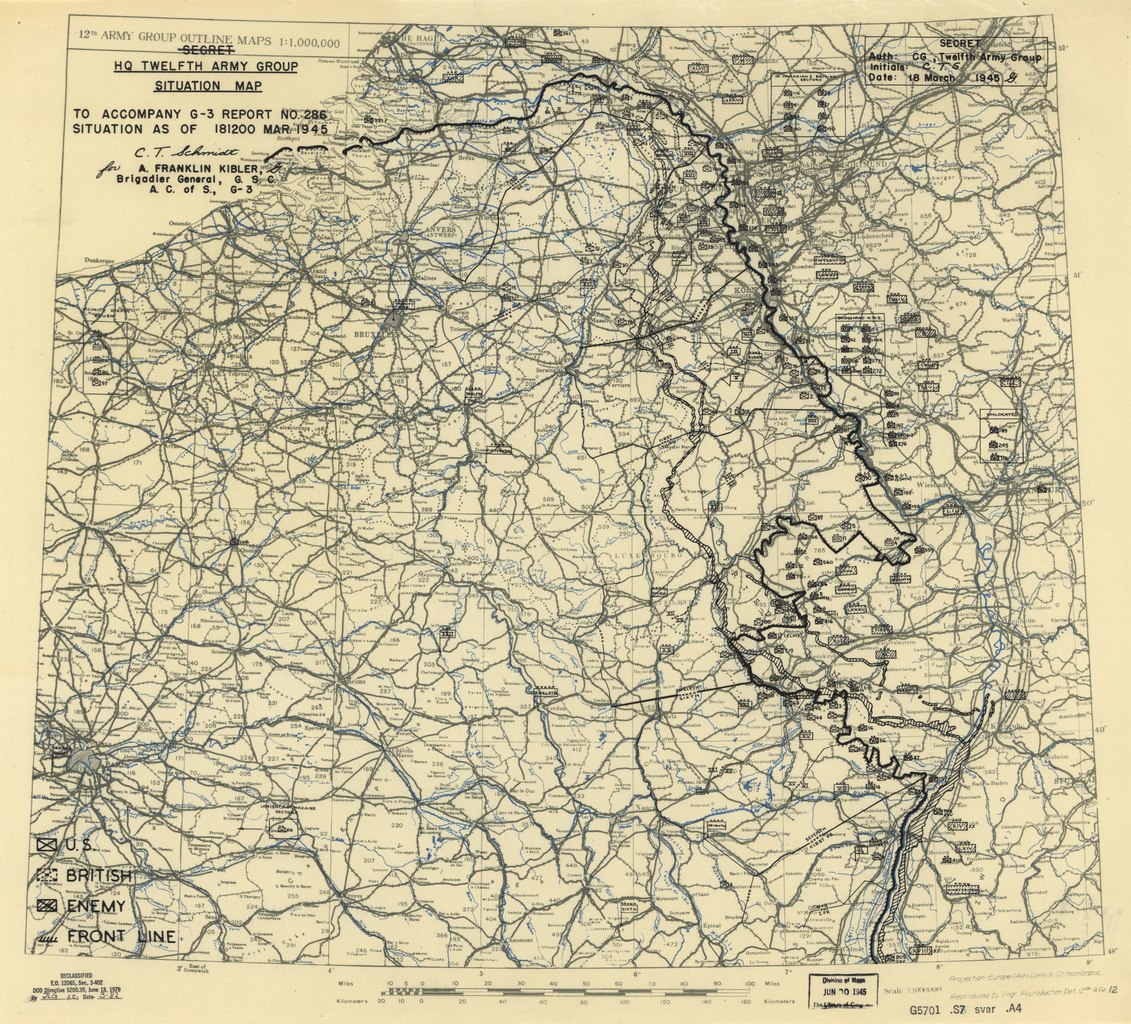 Forces of US 3rd Army capture Bingen and Bad Kreuznach as the advance to the southwest continues. To the south, the progress of US 7th Army is beginning to accelerate, with most of its forward units having now crossed the German border. Photo: Soldiers of the 97th Infantry Division in Cologne, Germany, March 18, 1945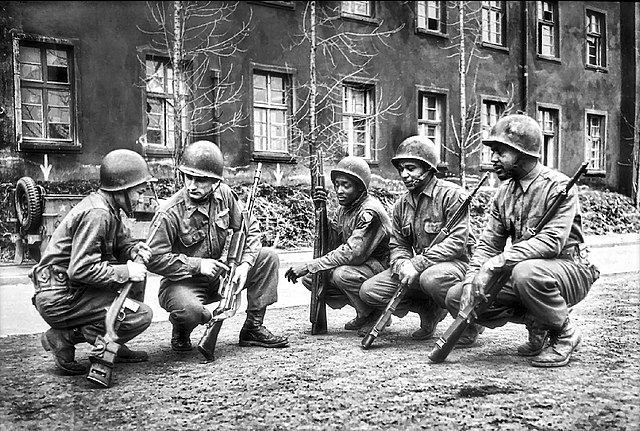 Photo: Infantrymen of the 5th Division, U.S. Third Army, march on Wintersbach, Germany, to clear out the few remaining Nazis cut off from their main units. 18 March, 1945 Photo: Infantrymen of the 5th Division, U.S. Third Army, march on Wintersbach, Germany, to clear out the few remaining Nazis cut off from their main units. 18 March, 1945 Photo: 94th Division infantrymen, supporting 10th Armored Division of 3rd U.S. Army, move out of Hermeskeil, Germany. 18 March, 1945 Photo: 94th Division infantrymen, supporting 10th Armored Division of 3rd U.S. Army, move out of Hermeskeil, Germany. 18 March, 1945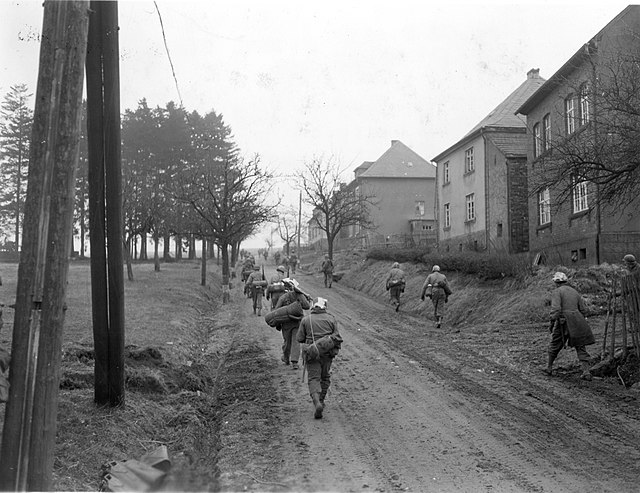 Photo: Vehicles of the 5th Infantry Division, U.S. Third Army, move into the newly captured town. Simmern, Germany. 18 March, 1945 Photo: Vehicles of the 5th Infantry Division, U.S. Third Army, move into the newly captured town. Simmern, Germany. 18 March, 1945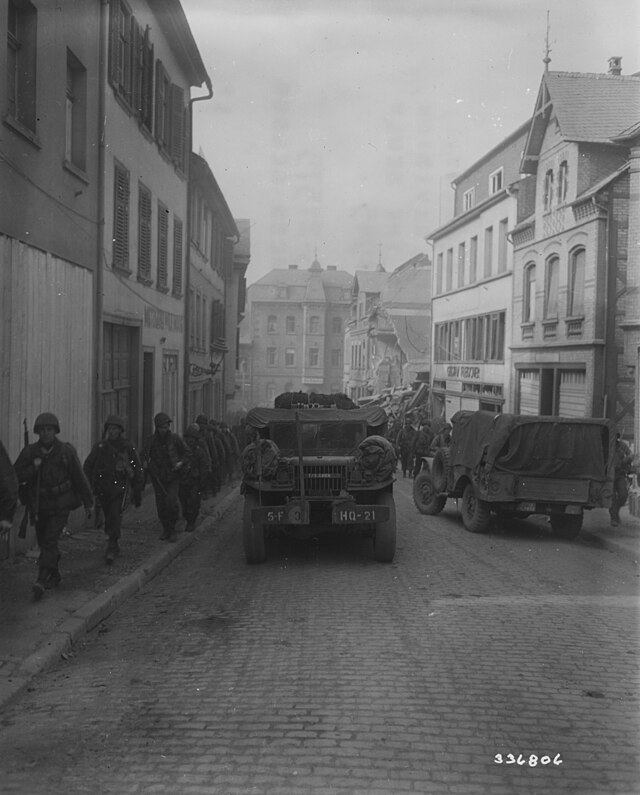 Air War over Europe Air War over Europe The 415th Night Fighter Squadron, 64th Fighter Wing, moves from Ochey to St Dizier, France with Beaufighters. (US Fifteenth Air Force): Bad weather limits operations to reconnaissance and supply missions, a fighter-bomber attack by P-38s on the Varazdin, Yugoslavia railroad bridge, after which many of the P-38s strafe railroad communications in the Zagreb, Varazdin and Maribor, Yugoslavia, and Villach, Austria areas, and a strafing mission against rail communications and airfields in the Graz and Wiener-Neustadt, Austria, Maribor, Yugoslavia, and Szombathely, Hungary areas. 100 RAF Lancasters of No 3 Group carried out G-H attacks on oil plants at Hattingen and Langendreer. Both raids appeared to be accurate. No aircraft lost. 324 RAF aircraft - 259 Halifaxes, 45 Lancasters, 20 Mosquitos - of Nos 4, 6 and 8 Groups dispatched to Witten. 8 aircraft - 6 Halifaxes, 1 Lancaster, 1 Mosquito - lost. This was an area raid carried out in good visibility. 1,081 tons of bombs were dropped, destroying 129 acres, 62 per cent of the built-up area (according to the post-war British Bombing Survey Unit). 277 RAF Lancasters and 8 Mosquitos of Nos 1 and 8 Groups bombed Hanau. 1 Lancaster lost. This was another accurate area raid. 0 industrial buildings and 2,240 houses were destroyed. The Altstadt was completely devastated and, says the report, all of the town's churches, hospitals, schools and historic buildings were badly hit. Support and 70 aircraft on a sweep over France, 30 Mosquitos to Berlin, 24 to Kassel and 18 to Nuremberg, 40 RCM sorties, 53 Mosquito patrols. No aircraft lost. (US Eighth Air Force): 2 missions are flown. Mission 894: 1,329 bombers and 733 fighters are dispatched to hit railway stations and tanks plants in the Berlin area; the attacks are made both visually and with H2X radar; the Luftwaffe makes it's most concentrated and successful attacks with Me 262s to date; the AAF claims 21-1-5 Luftwaffe aircraft; 13 bombers (8 to flak) and 6 fighters are lost: 1. 421 of 450 B-17s hit the Schlesischer rail station in Berlin; 13 hit the secondary target, Zehdnuk; and 1 hits Vechta, a target of opportunity; they claim 6-0-0 aircraft; 5 B-17s are lost, 8 damaged beyond repair and 268 damaged; 1 airman is KIA, 18 WIA and 49 MIA. 179 of 199 P-51s escort; they claim 4-0-2 aircraft; 2 P-51s are lost. 2. 495 of 530 B-17s hit the Nord rail station in Berlin; targets of opportunity are Ludwigslust (3) and other (3); they claim 1-1-1 aircraft; 7 B-17s are lost, 6 damaged beyond repair and 319 damaged; 1 airman is KIA, 12 WIA and 79 MIA. Escorting are 219 of 238 P-51s; they claim 7-0-1 aircraft; 2 P-51s are lost. 3. 347 B-24s are sent to hit the Tegel (225) and Henningsdorf (80) tank factories in Berlin; targets of opportunity are Oranienburg (9), Uelzen (9) and other (3); 1 B-24 is lost, 1 damaged beyond repair and 127 damaged; 1 airman is KIA, 1 WIA and 11 MIA. The escort is 254 P-51s; they claim 3-0-1 aircraft; 2 P-51s are lost. 4. 2 B-17s fly a scouting mission. 5. 27 of 30 P-51s fly a scouting mission. 6. 1 of 12 P-51s escort 5 F-5s on photo reconnaissance missions over Germany. Mission 895: 10 of 12 B-24s drop leaflets in France, the Netherlands and Germany during the night without loss. (US Ninth Air Force): In Germany, 660+ A-20s, A-26s and B-26s hit the marshalling yards at Wetzlar, Worms, Kreuztal, and Bad Durkheim, a communications center at Bad Durkheim, and 4 town areas with the aim of hampering enemy movement; fighters escort the bombers, attack assigned targets, fly patrols, and armed reconnaissance, and cooperate with the US III Corps at Remagen, with the XII Corps as it begins an assault towards the Mainz-Worms sector of the Rhine River, and with the XX Corps as it moves rapidly eastward through the Sankt Wendel area toward Kaiserslautern. HQ 70th Fighter Wing moves from Verviers, Belgium to Bruhl, Germany. The jets of JG 7 for the first time use the new R4M air-to-air rocket in place of the expensive wire-guided Ruhrstahl X-4. Fifty-four of the jets receive 4 kg rockets while six aircraft from 9 Staffel are fitted with twenty-four shot armament. On missions against USAAF bombers it is reported that the rockets literally blow the bombers to pieces. But it is difficult to judge who should be credited with a kill so, kills on this day are made as group kills instead of individual scores. As a result thirteen kills are credited to JG 7 for a loss of three pilots and five jets. One of the pilots lost is Oblt Wegmenn who is hit by return fire from a B-17 over Glowen. Trying to reach his airfield at Parchim his engines fail on approach and he bales out at a height of 4000 meters. Oblt Wegmenn survives the jump but loses his leg later at hospital. He is replaced as Staffelkapitän of 9./JG 7 by Lt. Karl Schnorrer. Another pilot lost from JG 7 is Oblt. Hans-Peter Waldmann, Staffelkapitän of 3./JG 7. Taking off with a flight of four jets, the schwarm becomes lost in some cloud and Oblt Waldmann collides with Lt Hans-Dieter Weihs' aircraft. Both jets crash with Lt Weihs successfully baling out but Oblt. Waldmann is killed upon landing. While watching the rest of his Schwarm disintegrate, Obfw Schrey is attacked by P-51s and as he parachutes from his stricken jet is shot at again and killed. Lt. Weihs replaces Waldmann as Staffelkapitän of 3./JG 7. Italian campaign (US Twelfth Air Force): In Italy during the night of 17/18 Mar, A-20s and A-26s continue intruder missions in the Po Valley, concentrating on Po River crossings; B-25s bomb the railroad bridges at Bozzolo, and Palazzuolo sull' Oglio, the railroad fill at Salorno, and the causeway at Mantua; fighters and fighter-bombers hit dumps and support ground forces S of Bologna, and attack communications targets over wide areas of the Po Valley; the most devastating raid of the day is flown against the Novara marshalling yard where 14 locomotives are destroyed. Two ex-Italian torpedo boats and a destroyer minelaying off the Gulf of Genoa were engaged by destroyers "Meteor" and "Lookout". In the last Royal Navy destroyer action of the Mediterranean, torpedo boats "TA-24" and "TA-29" were sunk. Battle of the Atlantic 'U-866' (type IXC/40) is sunk north-east of Boston, in position 43.18N, 61.08W, by depth charges from the US destroyer escorts USS 'Lowe', 'Menges', 'Pride' and 'Mosley'. 55 dead (all hands lost). GermanyAlbert Speer, the armaments minister, tells Hitler that the war is lost and economic collapse is nigh; Hitler insists that he retracts these comments. In the Brandenburg Prison in Germany, General Erich Fromm is shot. He was convicted of cowardice for his part in the bomb plot against Adolf Hitler in July 1944. Pacific War CHINA (Fourteenth Air Force): 6 B-24s sweep the Gulf of Tonkin and S China Sea, claiming 1 freighter damaged. 2 P-51s over N French Indochina strafe trucks, troops, and horsecarts. INDIA-BURMA (Tenth Air Force): In Burma, 12 P-47s support the Chinese ground forces near Hsipaw; 8 others support British 36 Division troops by dropping napalm NE of Mogok; 11 B-25s and 20 fighter-bombers hit troop concentrations and supplies immediately behind the battlefront and roads S of the bomb line are swept by 16 P-38s. Transports continue steady operations. GUAM Seventh Air Force: 14 B-24s from Guam pound Susaki Airfield and 1 other hits Haha Jima; during the night of 18/19 Mar, 5 more B-24s individually strike Susaki Airfield. The 392d Bombardment Squadron (Heavy), 30th BG (Heavy), moves from Saipan to Kipapa, Hawaii with B-24s. VII Fighter Command: 16 P-51s from Iwo Jima dive-bomb radar and radio installations and barges on Chichi Jima. (Twentieth Air Force): Mission 44: During the night of 18/19 Mar, 290 of 313 XXI Bomber Command B-29s continue the fire raids on Japanese cities, bombing Nagoya from 4,500 to 9,000 feet with incendiaries for the second time this month; an additional 3 square miles are destroyed; the Nagoya arsenal, Aichi engine plant and freight yards are damaged but the Mitsubishi plants escape with minor damage; this mission ends the March fire raids. BURMA The British 2nd Division takes Ava on the bend of the Irrawaddy River only a few miles south of Mandalay. The heavy fighting in Mandalay and round Meiktila continues. SOUTHWEST PACIFIC AREA [Far East Air Force]: On Formosa, Tainan Airfield, seaplane base at Takao, and emergency field at Koshun are also hit. PHILIPPINE CAMPAIGN (1945) There are American landings on Panay by 14,000 men of US 40th Infantry Division (General Brush) in the area near Iloilo. There is little initial opposition from the Japanese garrison. Photo: Troops of the 185th Inf., 40th Div., take cover behind advancing tanks while moving up on Japanese positions on Panay Island, P.I. This is one of the shots salvaged from the camera of Lt. Robert Fields who was killed in action shortly after it was taken, 18 March 1945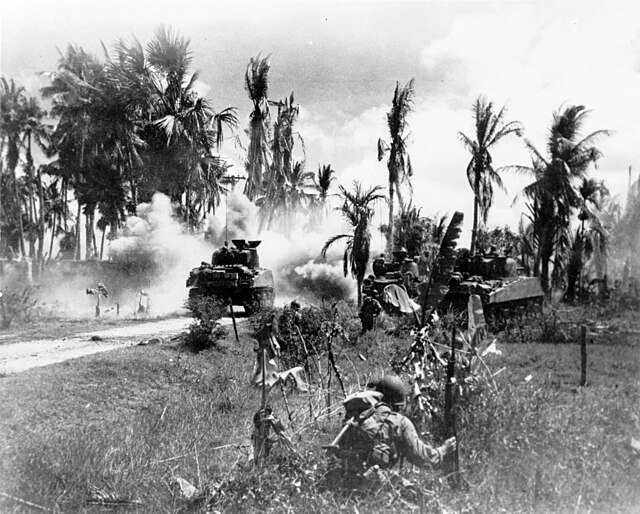 B-24s, A-20s, and fighters support ground forces by hitting the Ipo area and various targets in Batangas Province. B-24s again bomb Bacolod, hit several targets on Cebu, and bomb Sepinggang and Jesselton Airfields. The 419th Night Fighter Squadron, XIII Fighter Command, based at Puerto Princesa, Palawan with P-61s, sends a detachment to operate from Zamboanga, Mindanao. PV-1s (VPB 128), on the basis of reports from Filipino guerillas, bomb two Japanese midget submarines in Davao Gulf. Tank landing ship LST-635 is damaged by grounding, P.I., 11°05'N, 125°05'E. JAPAN TF 58 (Vice Admiral Marc A. Mitscher) planes bomb airfields on southern Kyushu and shipping, attacking convoy KATA-504, escorted by Coast Defense Vessel No.29 and submarine chaser Ch 58, damaging cargo vessel Kiyo Maru and sinking transport Kenyo Maru and tanker No.1 Nansei Maru, and Okinawa-bound auxiliary sailing vessels Kamo Maru and Tenjin Maru off Noma Misaki, 31°24'N, 130°07'E. Off Kyushu, Japanese planes bomb carriers Enterprise (CV-6), 30°50'N, 133°42'E, and Yorktown (CV-10), 30°40'N, 133°49'E, damaging both. Intrepid (CV-11) is crashed by kamikaze and hit by friendly fire, 30°47'N, 133°50'E. Photo: The U.S. Navy aircraft carrier USS Bunker Hill (CV-17) at sea during strikes against targets on Kyushu, Japan, 18 March 1945. The battleship USS New Jersey (BB-62) is in the right distance Photo: The U.S. Navy aircraft carrier USS Yorktown (CV-10) and other ships of Task Group 58.4 steaming off Kyushu on 18 March 1945. The photo was taken from USS Intrepid (CV-11), USS Independence (CVL-22) is visible aft of Yorktown. On this date 16 carriers if Task Force 58 under the command of Vice Admiral Marc A. Mitscher began launching strikes to neutralize Japanese air power prior to the Allied invasion of Okinawa on 1 April 1945. In five days of operation, U.S. naval aviators destroyed 482 enemy planes Photo: The U.S. Navy aircraft carrier USS Yorktown (CV-10) and other ships of Task Group 58.4 steaming off Kyushu on 18 March 1945. The photo was taken from USS Intrepid (CV-11), USS Independence (CVL-22) is visible aft of Yorktown. On this date 16 carriers if Task Force 58 under the command of Vice Admiral Marc A. Mitscher began launching strikes to neutralize Japanese air power prior to the Allied invasion of Okinawa on 1 April 1945. In five days of operation, U.S. naval aviators destroyed 482 enemy planes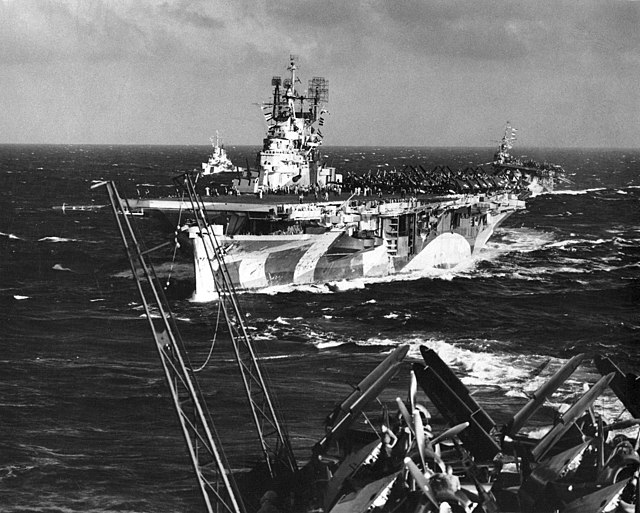 ALASKA (Eleventh Air Force): A weather sortie is flown. UNITED STATES NAVY DEPARTMENT COMMUNIQUES, CINCPOA COMMUNIQUÉ NO. 303, MARCH 18, 1945 On March 18 (East Longitude Date) a strong force of carrier aircraft of the Pacific Fleet attacked enemy aircraft bases and installations on the Island of Kyushu. The Marines on Iwo mopped up isolated remnants of the former enemy garrison in the rugged terrain of the northern part of the island on March 18. Marine uniforms were again found on enemy soldiers, one of whom stopped one of our ambulances, shot and wounded the driver and escaped. Snipers continued to be active. Army fighters bombed and strafed barges and radio and radar facilities on Chichi Jima in the Bonins on the same date. Army Liberators of the Strategic Air Force bombed the airfield on Chichi Jima on March 16 and 17. Without opposition, Liberators of the Eleventh Army Air Force bombed Shimushiru in the Kuriles on March 17. Fighters, dive bombers and torpedo planes of the Fourth Marine Aircraft Wing bombed radio towers, airstrip and other targets on Yap in the Western Carolines on March 18. On March 17 and 18, Marine Aircraft attacked buildings, bridges and other facilities on Babelthuap in the Palaus. One plane was lost in the attacks. UNITED STATES NAVY DEPARTMENT COMMUNIQUES, CINCPAC PRESS RELEASE NO. 743, MARCH 18, 1945 Reiterating that the battle for Iwo Jima was "the toughest and hardest fight in Marine Corps history," Lieutenant General Holland M. Smith, USMC, Commanding General of Fleet Marine Force, Pacific, has returned to his Pearl Harbor headquarters with members of his staff. The bloody conquest of Japan's Gibraltar of the Pacific further evidenced that the fighting will "get tougher" as we close in on the Nipponese empire, General Smith said. PACIFIC Submarine Balao (SS-285) sinks Japanese merchant trawler No.2 Daito Maru, 35°00'N, 123°51'E. Submarine Springer (SS-414), attacking Japanese convoy, sinks fast transport T.18 and damages minesweeper W 17 near Mutsure Jima, Ryukyus, 26°38'N, 127°12'E. Submarine Trigger (SS-237) sinks Japanese army cargo ship No.3 Tsukushi Maru northwest of Okinawa, 28°05'N, 126°44'E. TF 58 planes sink Japanese auxiliary submarine chaser No.43 Yusen Maru 45 miles southwest of Satamisaki Light; planes from carrier Hornet (CV-12) sink merchant vessel No.1 Nansei Maru and damage Tokuho Maru and Asahi Maru in Yamakawa harbor. Japanese landing ship T.137 is damaged by aircraft, Yaene, Hachijo Jima. Japanese merchant cargo ship Taiju Maru is sunk by aircraft, off Hime Jima. Japanese ship Koichi Maru is damaged by aircraft, Amachi harbor, Kochi-Ken.
|
|
lordroel
Administrator
Member is Online
Posts: 68,017 
Likes: 49,422
|
Post by lordroel on Mar 19, 2024 3:44:45 GMT
Day 2016 of World War II, March 19th 1945Eastern Front There are renewed attacks by 3rd Belorussian Front against the German forces in East Prussia, especially in the area south of Konigsberg. The offensive lasts for a week until most of the German forces are eliminated or evacuated. About 38,000 people, including many wounded and refugees, are evacuated by the many ships involved. Western Front (1945) - Western Allied invasion of GermanyMap: HQ Twelfth Army Group situation map, March 19th 1945 US 7th Army forces complete the capture of Saarlouis. Fighting in Saarbrucken and the towns to the east continues. US 3rd Army continues to advance east and southeast toward the Rhine River. Worms is reached, while to the left and right other units are near Mainz and Kaiserslautern. Photo: After the capture of Wadern by the 80th Division of the U.S Third Army, civilians move through the public square. 19 March, 1945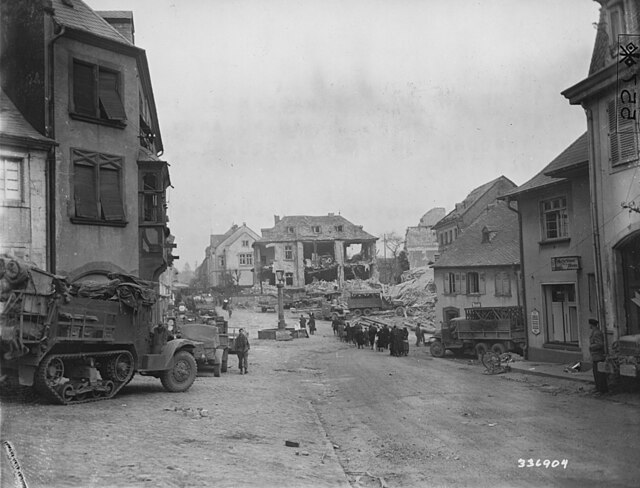 Air War over Europe Air War over Europe 79 RAF Lancasters of No 3 Group attacked the Consolidation benzol plant at Gelsenkirchen. Smoke and dust from the bombing prevented observation of the results. No aircraft lost. 37 RAF Lancasters of No 5 Group attacked the railway viaduct at Arnsberg and the bridge at Vlotho, near Minden. The attack at Arnsberg by No 617 Squadron using 6 Grand Slams, was successful and a 40-foot gap was blown in the viaduct. No 9 Squadron's attack at Vlotho was not successful. 34 RAF Mosquitos to Berlin. No losses. (US Eighth Air Force): 2 missions are flown. Mission 896: 1,273 bombers and 675 fighters are dispatched to hit airfields and industrial targets in Germany visually and with H2X radar; clouds force 2 of the 3 forces to hit secondaries; 100+ Luftwaffe fighters including 36 Me 262s in formation (largest number of jets seen as a unit) are encountered; the AAF claims 41-3-19 Luftwaffe aircraft (including 3 Me 262s); 6 bombers and 10 fighters are lost: 1. Cloud cover prevents 496 B-17s from hitting the primary targets; secondaries hit are the optical works at Jena (197) and the motor vehicle plant at Zwickau (177); targets of opportunity are Plauen (32), the marshalling yards at Fulda (44) and Saalfeld (10) and other (4); bombing is by H2X radar with some visual attacks; they claim 1-1-2 aircraft; 4 B-17s are lost, 4 damaged beyond repair and 121 damaged; 9 airmen are KIA, 5 WIA and 49 MIA. Escorting are 183 of 198 P-51s; they claim 2-0-3 aircraft; 4 P-51s are lost. 2. Cloud cover forces 404 of 436 B-17s to hit the industrial area at Plauen, the secondary target using H2X radar; targets of opportunity, bombed visually, are the Fulda marshalling yard (20) and Prissig (1); 1 B-17 is lost, 2 damaged beyond repair and 4 damaged; 9 airmen are KIA, 3 WIA and 9 MIA. The escort is 141 of 153 P-51s. 3. 341 B-24s are dispatched to hit airfields at Neuburg (125) and Leipheim (84) and jet aircraft plant at Baumenheim (126) visually; 1 B-24 is lost; 11 airmen are MIA. 175 of 194 P-51s escort; they claim 5-0-0 aircraft without loss. 4. 95 of 98 P-51s fly a freelance sweep for the bombers; they claim 33-2-14 aircraft; 6 P-51s are lost. 5. 2 of 4 P-51s escort 15 F-5s and 2 Spitfires on a photo reconnaissance mission over Germany. Mission 897: 11 of 12 B-24s drop leaflets in the Netherlands and Germany during the night. (US Ninth Air Force): In Germany, the 9th Bombardment Division strikes 2 marshalling yards, 5 rail bridges, a communications center and several casual targets as part of the interdiction program to impede enemy movement; fighters escort the bombers, fly patrols and armed reconnaissance, support the US III Corps W of Remagen, cooperates with the XII Corps' 4th Armored Division E of Kaiserslautern as it drives toward the Rhine River; fighter- bombers of the XIX Tactical Air Command, on a special mission, bomb the HQ of Commander-in-Chief West (Field Marshall Gerd von Rundstedt) at Ziegenberg. (US Fifteenth Air Force): 800+ B-17s and B-24s, with fighter escorts, hit marshalling yards at Landshut, Passau, Muhldorf, Plattling, Garching an der Alz and Altenmarkt an der Alz, Germany, and Sankt Veit an der Glan, Lambach, Klagenfurt, Austria and 54 P-51s strafe railroads in the target areas; 36 P-38s bomb the marshalling yard at Varazdin, Yugoslavia; B-24s drop supplies in Yugoslavia while P-38s and P-51s fly reconnaissance and escort. HQ 27th Fighter Group and the 522d, 523d and 524th Fighter Squadrons move from St Dizier to Ochey Airfield, Toul, France with P-47s. Italian campaign (US Twelfth Air Force): In Italy, XXII Tactical Air Command A-20s strike heavily against general movement in the Po Valley during the night of 18/19 Mar, and are followed during the day by fighter and fighter-bomber attacks on communications in the C Po Valley and NE Italy where numerous rail cuts are made, 3 bridges damaged, and several supply dumps hit; medium bombers damage a bridge at Muhldorf, Germany, bridges and fills at Perca, and at 7 other locations on the N Italian approaches to the Brenner Pass. Battle of the AtlanticSS 'Crichtoun' (1,097t) on a voyage from Leith to London and SS 'Rogate' (2,871t) on a voyage from Sunderland to London, were probably the last two ships to be sunk by E-Boats, on the east coast route. They were both sunk off Lowestoft. GermanyHitler orders a scorched earth policy to be put into effect on all fronts. Industrial plants, buildings and food are to be completely destroyed. Speer, who remains in charge of German industry, does his best to prevent this decree being carried out. In addition, many of the German army commanders in the field either ignore or circumvent the order. Pacific WarCHINA (Fourteenth Air Force): 5 B-24s on a sweep over the S China Sea and Gulf of Tonkin claim a large freighter sunk. 4 P-38s strafe trucks from Son La to Hoa Binh, French Indochina. INDIA-BURMA (Tenth Air Force): In Burma, 24 P-38s support the forces of the Chinese 50th Division near Hsipaw; 12 P-38s sweep roads S of the bomb line while 27 P-47s operating over and behind enemy lines hit troop concentrations and supplies at Namlan, Namio, and Nam-maw-long and a Japanese-held monastery at Nammaw-long. Transports fly 502 sorties to forward areas. BURMA Mogok is taken by the British 36th Division. Photo: Major General T W Rees, commanding 19th Indian Division, enters Fort Dufferin in Mandalay, 19 March 1945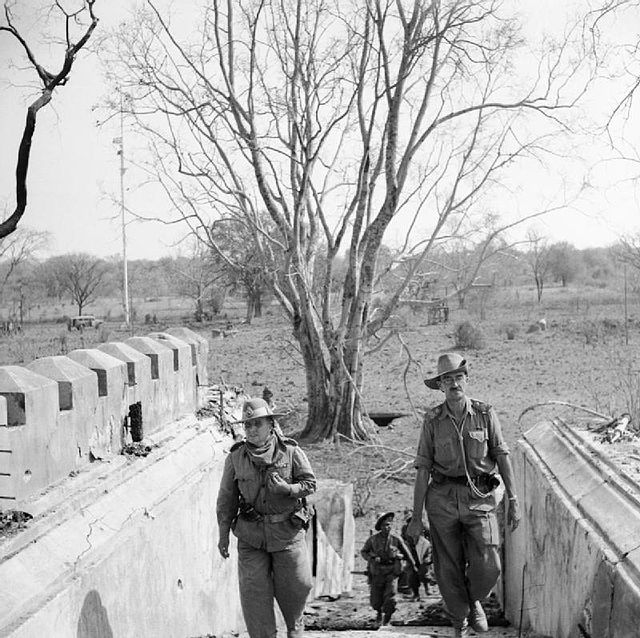 Photo: A Stuart tank, crewed by members of the 19th Indian Division, passes a destroyed jeep on the outskirts of Mandalay shortly after the fall of Fort Dufferin, 19 March 1945 Photo: A Stuart tank, crewed by members of the 19th Indian Division, passes a destroyed jeep on the outskirts of Mandalay shortly after the fall of Fort Dufferin, 19 March 1945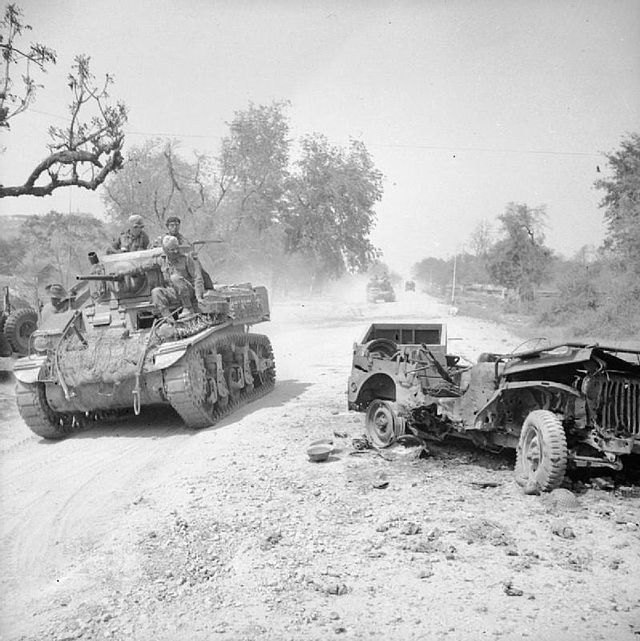 GUAM Seventh Air Force: 12 Guam based B-24s attack the Susaki Airfield and radio installations in the afternoon. During the night of 19/20 Mar, Susaki Airfield is hit again by 5 B-24s flying separate snooper strikes. VII Fighter Command: 16 P-51s from Iwo Jima bomb and strafe Susaki Airfield, a radio installation, and storage area on Chichi Jima. PHILIPPINE CAMPAIGN (1945) In their northward attacks along the west coast, US 1st Corps captures Bauang, south of San Fernando, on Luzon. B-24s and fighter-bombers again hit installations on N Luzon. B-24s hit a variety of targets on Cebu including the town of Minglanilla. The 8th Combat Cargo Squadron, 2d Combat Cargo Group, moves from Biak to Dulag with C-46s; the 63d Bombardment Squadron (Heavy), 43d BG (Heavy), moves from Tacloban, Leyte to Clark Field, Luzon with B-24s. ALASKA (Eleventh Air Force): 5 B-24s bomb and photograph the Kashiwabara naval base on Paramushiru . 8 B-25s bomb canneries along the Masugawa and Asahigawa Rivers. JAPAN TF 58 (Vice Admiral Marc A. Mitscher) pounds airfields on Kyushu, and shipping at Kure and Kobe, Honshu, destroying incomplete Japanese submarine I 205 in drydock, and damaging battleships Yamato Hyuga and Haruna; carriers Ikoma, Katsuragi, Ryuho and Amagi; small carrier Hosho; escort carrier Kaiyo; heavy cruiser Tone, light cruiser Oyodo, submarines I 400 and RO 67, auxiliary submarine chaser Cha 229 at Kure; and escort destroyer Kaki at Osaka. Photo: U.S. Navy planes from the aircraft carrier USS Essex (CV-9) attack two Japanese aircraft carriers at Kure, Japan, on 19 March 1945. A Curtiss SB2C "Helldiver" scout bomber is visible in the upper right, painted in Essex markings. The ship at bottom is either Amagi or Katsuragi. The other carrier is Kaiyo Photo: U.S. Navy carrier aircraft attack the Japanese Kure Naval Base on 19 March 1945 Photo: U.S. Navy carrier aircraft attack the Japanese Kure Naval Base on 19 March 1945 Japanese planes single out carriers for attack: off Shikoku, Wasp (CV-18) is bombed, 32°16'N, 134°05'E. while friendly fire hits Essex (CV-9), 32°10'N, 134°20'E. On board Franklin (CV-13) damaged off Kyushu, 32°01'N, 133°57'E, as the ship is rocked by a succession of explosions, Lieutenant Commander Joseph T. O'Callaghan, ChC, the carrier's Roman Catholic chaplain, ministers to wounded and dying men irregardless of faith or creed, organizes and leads fire-fighting parties, directs the jettisoning of ammunition and the flooding of a magazine, and mans a hose to cool hot, armed bombs rolling on the listing deck. O'Callaghan's courage and fortitude inspires his shipmates. Elsewhere on board, Lieutenant (j.g.) Donald A. Gary calms anxious shipmates trapped in a smoke-filled compartment and after repeated tries through dark, debris-filled passageways manages to find a way to escape. Later, he organizes and leads fire- fighting parties in the blazing inferno of the hangar deck, and then enters number three fireroom to raise steam in one boiler in the face of extreme hazards. O'Callaghan and Gary will be awarded Medals of Honor. Photo: The U.S. Navy aircraft carrier USS Wasp (CV-18) under attack by Japanese aircraft off Japan on 19 March 1945. The bomb penetrated the flight deck and the armor-plated hangar deck, and exploded in the crew's galley. Many of her shipmates were having breakfast after being at general quarters all night. The blast disabled the number-four fire room. Around 102 crewmen were lost. Despite the losses, Wasp continued operations with the Task Group and the air group was carrying out flight operations 27 minutes after the damage Photo: The U.S. Navy aircraft carrier USS Franklin (CV-13) burning and listing on 19 March 1945 Photo: The U.S. Navy aircraft carrier USS Franklin (CV-13) burning and listing on 19 March 1945 Photo: The U.S. Navy aircraft carrier USS Franklin (CV-13) afire and listing after a Japanese air attack, off the coast of Japan, 19 March 1945. Note the fire hoses and the crewmen on her forward flight deck, and water streaming from her hangar deck. Photographed from the light cruiser USS Santa Fe (CL-60) Photo: The U.S. Navy aircraft carrier USS Franklin (CV-13) afire and listing after a Japanese air attack, off the coast of Japan, 19 March 1945. Note the fire hoses and the crewmen on her forward flight deck, and water streaming from her hangar deck. Photographed from the light cruiser USS Santa Fe (CL-60) Photo: View of the after 5"/38 twin gun mount of the U.S. Navy aircraft carrier USS Franklin (CV-13) burning, as her crew tried to control fires on 19 March 1945. The carrier had been hit by a Japanese air attack while operating off the coast of Japan. Photographed from USS Santa Fe (CL-60), which extinguished the fire in this gun mount by playing streams of water through the mount's open door. Later, the other 5"/38 twin gun mount and the 40 mm quad gun mount (at right) also burned. Note ammunition loaded in the feed racks of the 40mm guns Photo: View of the after 5"/38 twin gun mount of the U.S. Navy aircraft carrier USS Franklin (CV-13) burning, as her crew tried to control fires on 19 March 1945. The carrier had been hit by a Japanese air attack while operating off the coast of Japan. Photographed from USS Santa Fe (CL-60), which extinguished the fire in this gun mount by playing streams of water through the mount's open door. Later, the other 5"/38 twin gun mount and the 40 mm quad gun mount (at right) also burned. Note ammunition loaded in the feed racks of the 40mm guns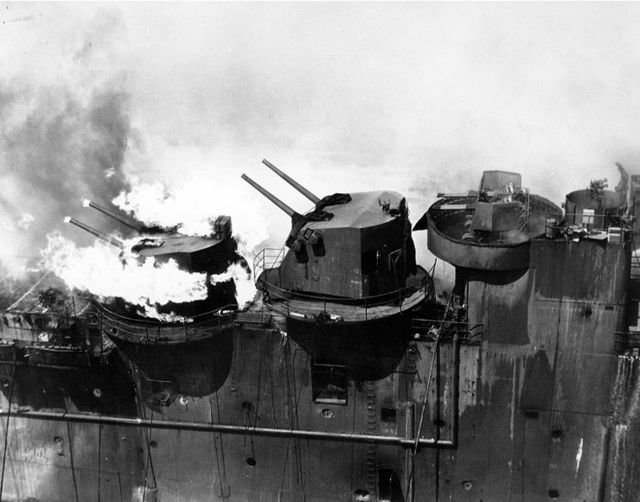 Photo: Still smoking, the U.S. Navy aircraft carrier USS Franklin (CV-13) is towed from the scene of the disatrous air attack on 19 March 1945 by the heavy cruiser USS Pittsburgh (CA-72) before the crewmen aboard the carrier effected emergency engine repairs Photo: Still smoking, the U.S. Navy aircraft carrier USS Franklin (CV-13) is towed from the scene of the disatrous air attack on 19 March 1945 by the heavy cruiser USS Pittsburgh (CA-72) before the crewmen aboard the carrier effected emergency engine repairs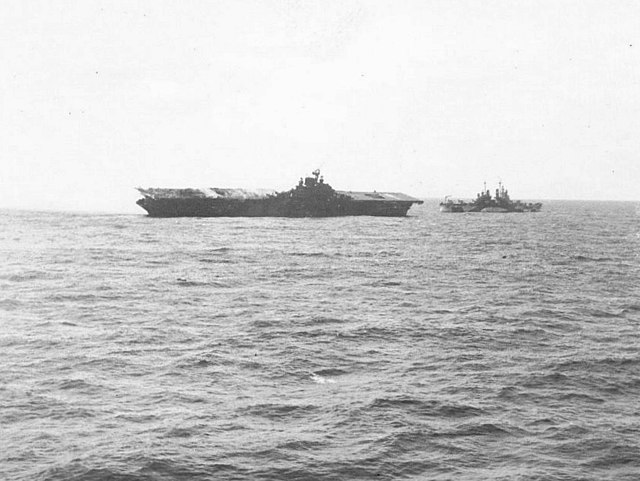 UNITED STATES NAVY DEPARTMENT COMMUNIQUES, N. D. COMMUNIQUÉ NO. 585, MARCH 19, 1945 Pacific Area. 1. U. S. submarines operating in Far Eastern waters have sunk 15 enemy vessels, including two escort vessels and three destroyers. The vessels sunk were: 3 destroyers 2 escort vessels 1 large tanker 1 large cargo transport 6 medium cargo vessels 1 medium transport 1 small cargo vessel 2. These actions have not been announced in any previous Navy Department communiqué. UNITED STATES NAVY DEPARTMENT COMMUNIQUES, CINCPOA COMMUNIQUÉ NO. 304, MARCH 19, 1945 Carrier aircraft of the Pacific Fleet continued their attacks on Japan on March 19 (East Longitude Date). They attacked Kobe Kure and other objectives in and around the Inland Sea. The Marines on Iwo Island continued to search out snipers and isolated remnants of the enemy garrison on March 19. On the same date Army fighters from Iwo bombed and strafed the airfield and radio stations on Chichi Jima in the Bonins. Army Liberators of the Strategic Air Force bombed targets on Chichi Jima and Haha Jima on March 18. One enemy fighter was observed in the air at Chichi. A single Navy search Ventura of Fleet Air Wing Four made rocket attacks on small craft and buildings in the Torishima group southeast of Paramushiru on March 18. On the same date Liberators of the Eleventh Army Air Force bombed Matsuwa in the Kuriles without opposition. A Navy search Privateer of Fleet Air Wing One sank a lugger and four small craft in the anchorage at Truk in the Carolines on March 19. Fighters, torpedo planes and dive-bombers of the Fourth Marine Aircraft Wing struck piers, runways, buildings, and radio installations on Yap in the Western Carolines on March 19. On the same date Marine aircraft carried out attacks on enemy‑held islands in the Palaus. Fourth Marine Aircraft Wing planes continued neutralizing attacks on enemy bases in the Marshalls. PACIFIC Submarine Balao (SS-285) attacks Japanese convoy MOTA- 43, sinking troopship Hakozaki Maru and damaging transport Tatsuharu Maru off the Yangtze estuary about 90 miles north-northwest of Shanghai, 33°10'N, 122°10'E, and sinking merchant fishing vessels No.1 Katsura Maru and 1 Eiho Maru and No.2 Eiho Maru, 34°40'N, 122°55'E. Submarine Bluefish (SS-222) damages Japanese guardboat No.1 Shinya Maru, 31°35'N, 137°50'E. PV-1s (VPB 128) bomb and damage Japanese midget submarine at Cebu; strike is repeated the next day. Japanese river gunboat Suma is sunk by USAAF mine (laid by 14th Air Force planes on 4 March ), in the Yangtze, 51 miles above Kiangyin, China, 32°00'N, 120°00'E. Mine also claims merchant ship Kozan Maru, on the Yangtze below Chinkiang, 32°05'N, 119°56'E. USAAF mine also sinks Japanese merchant tanker Sarawak Maru, repaired after her brush with Besugo (SS-321) on 24 January 1945, 10 miles off Horsburgh Light, Singapore, 01°25'N, 104°36'E. Japanese merchant vessel Mikawasan Maru is sunk by aircraft off Iyo. Japanese escort destroyer Shinnan is damaged by aircraft, 33°47'N, 131°35'E. Japanese landing ship T.105 is damaged by aircraft, near Ujina. Japanese merchant vessel Rashu Maru is damaged by aircraft, off Uzaki, Hyogo prefecture. Japanese merchant cargo ship Teiritsu Maru is damaged by aircraft, 34°16'N, 13°03'E.
|
|
lordroel
Administrator
Member is Online
Posts: 68,017 
Likes: 49,422
|
Post by lordroel on Mar 20, 2024 3:53:13 GMT
Day 2017 of World War II, March 20th 1945Eastern Front Soviet forces around Stettin eliminate the German bridgehead over the Oder River, at Altdamm. In East Prussia, Braundsberg is captured. General Heinrici, one of the best defensive tacticians in the German Army, is appointed to command Army Group Vistula in succession to Himmler. Heinrici is tasked with building up defenses along the Oder River in preparation for the expected Soviet offensive toward Berlin by 1st Belorussian Front (Zhukov). The German army group has already lost a large part of its original force in the fighting in Pomerania. Western Front (1945) - Western Allied invasion of GermanyMap: HQ Twelfth Army Group situation map, March 20th 1945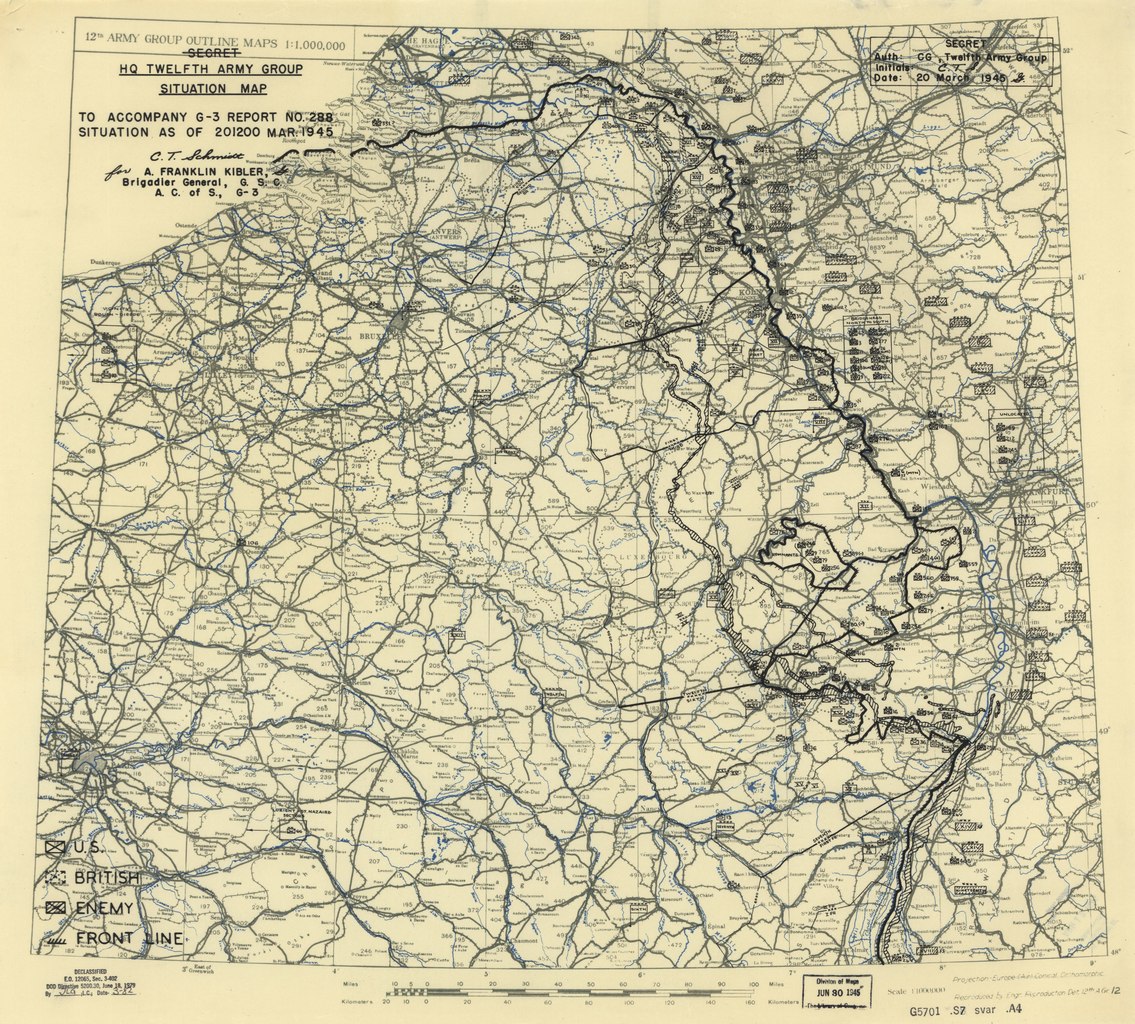 Troops of US 7th Army capture Saarbrucken as well as Zweibrucken a little to the east. Forces of US 3rd Army capture Ludwigshafen and Kaiserslautern. Farther north, the US 1st Army continues fighting to expand the Remagen bridgehead which is now almost 30 miles wide and 19 miles deep. Photo: Infantrymen belonging to the 2nd Battalion, 30th Infantry Regiment, 3rd Infantry Division moving through the town of Zweibrucken, Germany. 20 March, 1945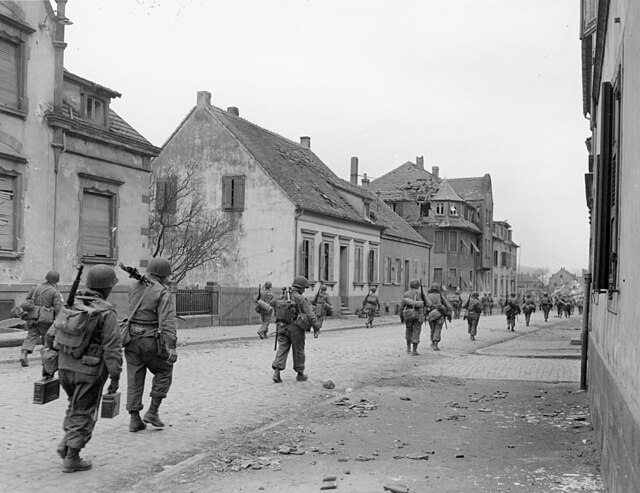 Photo: Infantrymen of 1st U.S. Army march past still-smouldering tank and roadblock in Beuel, Germany. 20 March, 1945 Photo: Infantrymen of 1st U.S. Army march past still-smouldering tank and roadblock in Beuel, Germany. 20 March, 1945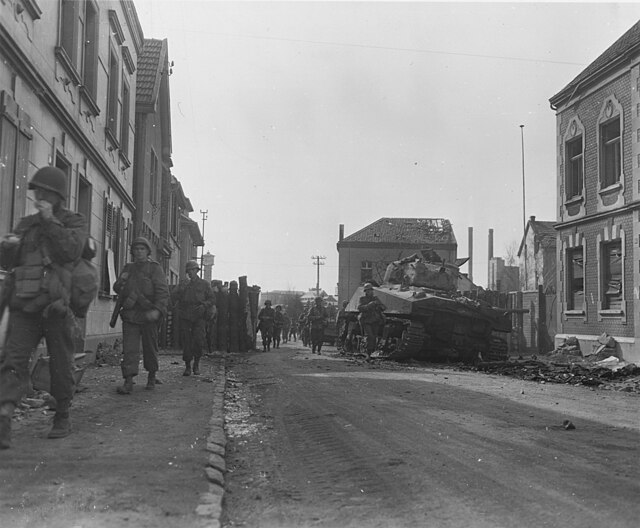 Photo: Two riflemen and a bazookaman pass smoke screen on a road to Zweibrucken. 20 March, 1945 Photo: Two riflemen and a bazookaman pass smoke screen on a road to Zweibrucken. 20 March, 1945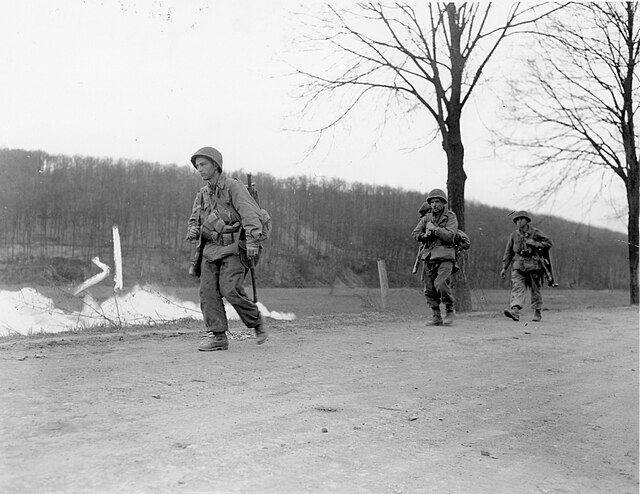 Photo: Infantrymen of the 80th Division, U.S. Third Army, enter the town of Kaiserslautern, Germany, only a few hours after the tanks of the 10th Armored Division. 20 March, 1945 Photo: Infantrymen of the 80th Division, U.S. Third Army, enter the town of Kaiserslautern, Germany, only a few hours after the tanks of the 10th Armored Division. 20 March, 1945 Air War over Europe Air War over Europe 153 RAF aircraft - 125 Halifaxes, 16 Lancasters, 12 Mosquitos - of Nos 4 and No 6 Groups attempted to hit the railway yards at Recklinghausen but cloud and a strong wind spoiled the Pathfinder marking and the bombing was well scattered. No aircraft lost. 99 RAF Lancasters of No 3 Group attacked the railway yards at Hamm and 14 Lancasters of No 9 Squadron attacked the railway bridge at Arnsberg. Bombs were seen to explode in the target area at both targets. No aircraft lost. 224 RAF Lancasters and 11 Mosquitos of No 5 Group attacked the synthetic-oil plant near Böhlen. This accurate attack put the plant out of action and it was still inactive when captured by American troops several weeks later. 9 Lancasters lost. 166 RAF Lancasters of Nos 1, 6 and 8 Groups carried out an equally effective attack upon the oil refinery at Hemmingstedt. 1 Lancaster lost. Support and 70 training aircraft on a diversionary sweep over France, 12 Lancasters in a feint raid on Halle, 38 Mosquitos to Berlin, 27 to Bremen and 16 to Kassel, 47 RCM sorties, 55 Mosquito patrols, 9 Lancasters minelaying off Heligoland. 3 aircraft lost - 1 Lancaster from the Halle raid and 1 Fortress and 1 Liberator RCM aircraft. (US Eighth Air Force): 3 missions are flown. Mission 898: 451 bombers and 355 fighters are dispatched to hit the shipyard and dock area at Hamburg and an oil refinery; they claim 14-3-17 Luftwaffe aircraft; 4 bombers and 2 P-51s are lost: 1. 13 of 152 B-17s hit the Blohm Voss U-boat yard at Hamburg; 133 others hit the secondary, the port area at Hamburg; bombing is visual; they claim 1-0-3 aircraft; 1 airman is KIA and 2 WIA. Escorting are 70 of 79 P-51s; they claim 0-0-2 aircraft. 2. 149 of 162 B-17s hit the secondary target, the Hamburg port area, using H2X radar; 1 other hits the Nordholz Airfield, a target of opportunity; they claim 5-3-2 aircraft; 3 B-17s are lost, 1 damaged beyond repair and 54 damaged; 27 airmen are MIA. The escort is 72 of 75 P-51s; they claim 0-0-2 aircraft. 3. 114 of 129 B-24s attack the oil refinery at Hemmingstedt; 1 B-24 is lost and 9 damaged; 12 airmen are MIA. 75 P-51s escort; they claim 2-0-1 aircraft in the air and 1-0-2 on the ground; 1 P-51 is lost (pilot MIA). 4. 6 B-17s fly a screening mission without loss. 5. 2 B-17s and 26 of 27 P-51s fly scouting missions. 6. 78 of 82 P-51s fly a strafing mission in the Bremen-Hannover area; they claim 2-0-3 aircraft in the air and 3-0-2 on the ground; 1 P-51 is lost (pilot MIA). 7. 17 P-51s escort 11 F-5s and 2 Spitfires on photo reconnaissance missions over Germany. Mission 899: 1 B-17, escorted by 4 P-51s, bombs Oberursel at 1650 hours from 25,000 feet (7,620 m); this is the first operational test of Micro-H Mk II radar. Mission 900: 12 B-24s drop leaflets in the Netherlands and Germany and 2 A-26s fly CARPETBAGGER missions (1 A-26 is lost). (US Ninth Air Force): In Germany, 360+ A-20s, A-26s, and B-26s bomb the Geisecke marshalling yard, Sythen ammunition-filling plant, the town of Gronau (including a rail bridge), and several casual targets in or near 9 other towns; fighters escort the bombers, fly patrols and armed reconnaissance, support the US III and VII Corps just E of the Rhine River between Bad Honningen and the Sieg River, and the XII and XX Corps as they push to the Rhine River at Worms and at a point N of Mannheim. (US Fifteenth Air Force): In Austria, 760+ B-17s and B-24s, with fighter escort, hit the Korneuburg and Kagran oil refineries, the marshalling yards at Wels, Sankt Polten, Amstetten, Wiener-Neustadt, and Klagenfurt, and the tank works at Steyr. Routine supply, reconnaissance, and escort missions continue. Twenty-two Me 262s from JG 7 take off to intercept USAAF bombers and their escorting fighters in the Hamburg area and destroy nine B-17s for the loss of four jets including Fw Buttner, the first jet experte of JG 7. Italian campaign The 885th Bombardment Squadron (Heavy), 2641st Special Group, moves from Brindisi to Rosignano, Italy with B-17s and B-24s (the squadron transports supplies to partisans and drops leaflets). (US Twelfth Air Force): In Italy, XXII Tactical Air Command A-20s during the night of 19/20 Mar continue intruder missions into the Po Valley while fighters and fighter-bombers pound communications targets in the Valley during the day and severely damage fuel dumps near Mantua; medium bombers hit 4 bridges on the Brenner line and 2 others in NE Italy and hit other bridge approaches nearby. HQ 79th Fighter Group moves from Fano to Cesenatico, Italy. Battle of the Atlantic 'U-683' listed as missing in the North Atlantic south-west of Ireland or in the English Channel. 49 dead (all hands lost). Probably sunk 12 March, 1945 in the English Channel near Land's End, in position 49.52N, 05.52W, by depth charges from the British frigate MS 'Loch Ruthwen' and the sloop 'Wild Goose'. Frigates HMCS 'Beacon Hill', 'Sussexvale', 'New Glasgow' and 'Ribble' sailed from Londonderry for training at Loch Alsh. After the group passed the Foyle buoy it, formed up, a mile apart and zigzagging independently, making about fourteen knots with CAT gear streamed. A periscope and schnorkel were visible on 'New Glasgow's' port bow, action stations were sounded and a shallow depth-charge pattern was ordered however, it was too late. The U-boat struck 'New Glasgow' just below the bridge. Subsequent searches by EG 26, C-4 and EG 25 failed to reveal 'U-1003'. In the afternoon, 'U-968' attacked Convoy JW-65 and reported a destroyer and a Liberty sunk and another Liberty ship torpedoed. In fact, sloop HMS 'Lapwing' of the 7th Escort Group and Liberty ship 'Thomas Donaldson' were sunk. Whilst escorting convoy JW.65 on its approach to Kola Inlet, HMS 'Lapwing' was hit amidships at 1325 and sank 20 minutes later. United KingdomLast hostile operations by enemy manned aircraft over Britain. Ten enemy aircraft which operated over Norfolk, Northamptonshire, Suffolk and Essex, but little damage was reported. BelgiumPhoto: Field Marshal Montgomery acknowledges the cheers of Belgian civilians during a tour of 5th Division in and around Ghent, 20 March 1945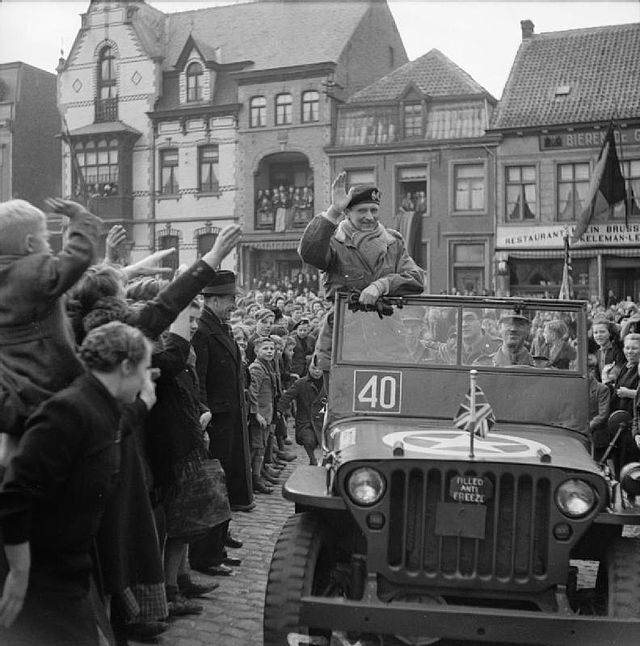 Pacific War Pacific War CHINA (Fourteenth Air Force): In French Indochina, 4 P-38s claim 11 trucks destroyed and 9 damaged between Son La and Hoa Binh. INDIA-BURMA (Tenth Air Force): 20 P-47s sweep roads S of the bomb line in C Burma; 16 others hit supply dumps behind Japanese lines. Transports continue to supply forward areas. BURMA The British 19th Indian Division completes the capture of Mandalay. The Fort Dufferin position has been among the most stubbornly defended by Japanese forces. Photo: The crew of a Lee tank pose with a captured Japanese flag during the advance south of Mandalay, 20 March 1945 Photo: Sherman tanks and other vehicles start the journey from Mandalay south to Rangoon, 20 March 1945 Photo: Sherman tanks and other vehicles start the journey from Mandalay south to Rangoon, 20 March 1945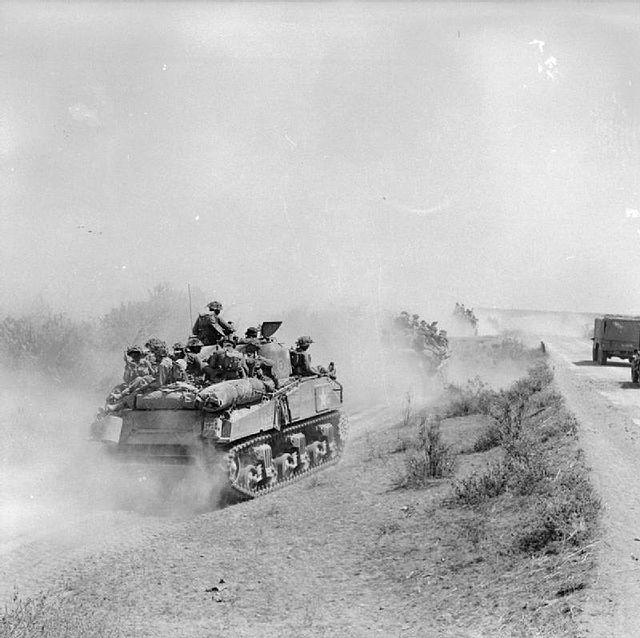 Photo: Sherman tanks and other vehicles start the journey from Mandalay south to Rangoon, 20 March 1945 Photo: Sherman tanks and other vehicles start the journey from Mandalay south to Rangoon, 20 March 1945 Photo: A Sherman tank during the advance south of Mandalay, 20 March 1945 Photo: A Sherman tank during the advance south of Mandalay, 20 March 1945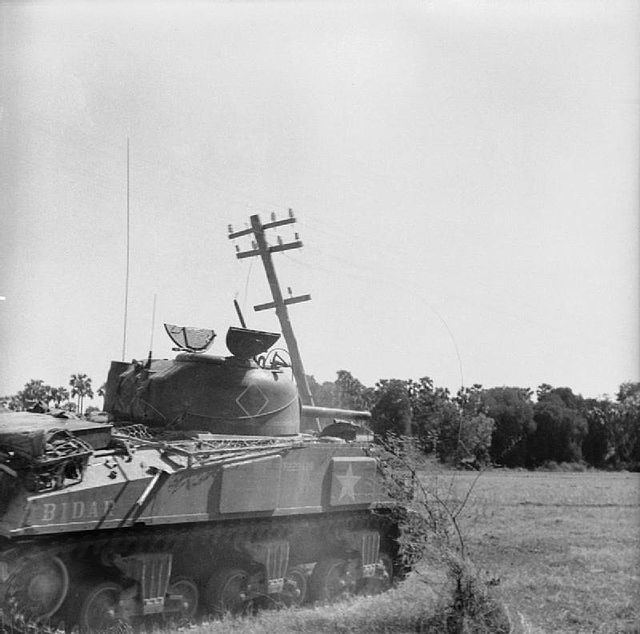 Photo: A Lee tank during the advance south from Mandalay, 20 March 1945 Photo: A Lee tank during the advance south from Mandalay, 20 March 1945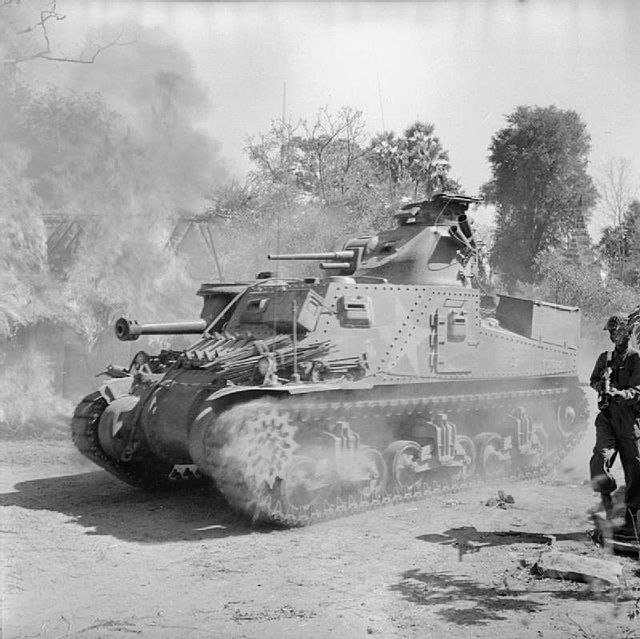 Photo: A soldier of 19th Division holds at Fort Dufferin in Mandalay, 20 March 1945 Photo: A soldier of 19th Division holds at Fort Dufferin in Mandalay, 20 March 1945 GUAM Seventh Air Force: 12 Guam based B-24s bomb Susaki Airfield; during the night of 20/21 Mar, 4 other B-24s fly single strikes against the airfield. VII Fighter Command: The air echelon of the 549th Night Fighter Squadron, ceases operating from Saipan and moves to Iwo Jima with P-61s. SOUTHWEST PACIFIC AREA [Far East Air Force]: B-24s bomb the town of Tainan. B-25s on a shipping sweep sink 3 small vessels near Qui Nhon, French Indochina. The 72d Bombardment Squadron (Heavy), 5th BG (Heavy), moves from Morotai to Guiuan Airfield with B-24s; the detachments of the 75th and 390th Bombardment Squadrons (Medium), 42d BG (Medium), operating from Morotai return to base at Sansapor with B-25s. PHILIPPINE CAMPAIGN (1945) On Luzon, B-24s, A-20s, and fighter-bombers fly numerous ground support missions and hit targets at Balete Pass, Bayombong, Tuguegarao, Antamok, San Fernando, Bontoc and along roads. B-24s pound the supply and personnel area E of Cebu City and N of Mambaling on Cebu, defensive positions NW of Talisay and AA guns to the N, and also bomb Talisay. JAPAN US Task Force 58 (Admiral Mitscher) is replenishing in preparation for operations around Okinawa. There are Japanese Kamikaze attacks that fail to achieve significant success. Admiral Spruance, command the US 5th Fleet, is present for the operations. TF 92 (Captain John M. Worthington) (six destroyers) sorties from Attu to proceed to Paramushiro to bombard Japanese installations in the Suribachi Wan area. Heavy ice, however, will cause a cancellation of the operation. Off Japan, carrier Enterprise (CV-6) is damaged by friendly fire, 30°01'N, 134°30'E, and destroyer Halsey Powell (DD-686) is crashed by kamikaze at 30°27'N, 134°28'E. TF 38 planes sink Japanese guardboat No.1 Kochi Maru east of Honshu. Photo: An Imperial Japanese Navy Yokosuka D4Y3 Suisei bomber (Allied code name "Judy") passes near the light aircraft carrier USS Bataan (CVL-29) during an unsuccessful dive bombing run on Task Force 58, while the U.S. ships were operating off Japan on 20 March 1945. The Japanese plane was soon shot down by anti-aircraft fire. The photo was taken from the aircraft carrier USS Hancock (CV-19), visible in the foreground. Bataan is the ship in the center of the view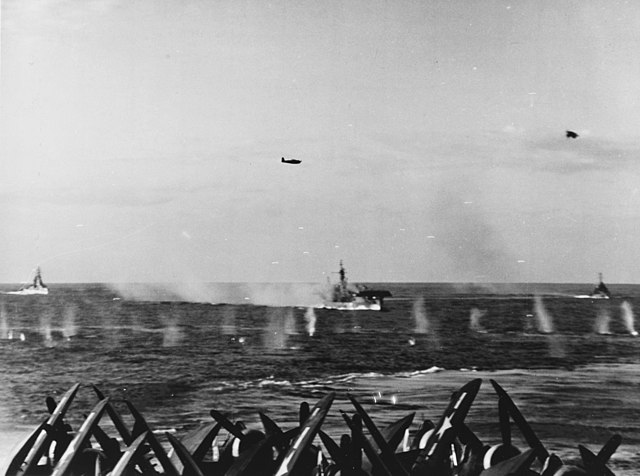 Photo: A Japanese Yokosuka D4Y Suisei (Allied reporting name "Judy") crashes close to the U.S. Navy light aircraft carrier USS Bataan (CVL-29) on 20 March 1945 Photo: A Japanese Yokosuka D4Y Suisei (Allied reporting name "Judy") crashes close to the U.S. Navy light aircraft carrier USS Bataan (CVL-29) on 20 March 1945 UNITED STATES NAVY DEPARTMENT COMMUNIQUES, CINCPOA COMMUNIQUÉ NO. 305, MARCH 20, 1945 After a day of destructive attacks on the enemy air force in Kyushu the Fast Carrier Task Force commanded by Vice Admiral Marc A. Mitscher, moved northeast and on March 19 (East Longitude Date) attacked the principal units of the Japanese Fleet in its home bases in the Inland Sea. During these attacks crippling damage wag inflicted on the Japanese Fleet and many Japanese aircraft were destroyed. A preliminary report from Admiral R. A. Spruance, Commander Fifth Fleet, who was present in tactical command of the Fleet forces engaged shows that the following damage was inflicted on the enemy during the two days fighting Aircraft: 200 shot out of the air 275 destroyed on the ground More than 100 damaged in the first day's attacks, and a large number damaged in the second day's attacks. Ships sunk: Six small freighters Ships damaged: One or two battleships Two or three aircraft carriers Two light aircraft carriers or escort carriers Two escort carriers One heavy cruiser One light cruiser Four destroyers One submarine One destroyer escort Seven freighters Ground installations: A large number of installations including hangars, shops, arsenals and oil storage facilities were destroyed. Our aircraft losses in combat were extremely light. The enemy made many air attacks on our forces. None of our ships was lost. One of our ships was seriously damaged and is returning to port under her own power. A few others received minor damage but are fully operational. Mopping up operations were continued by the Marines in Iwo on March 20. On March 19, Liberators of the Seventh Army Air Force bombed the airfield on Chichi Jima in the Bonins causing explosions and large fires. Navy search Mariners of Fleet Air Wing One bombed the town of Yap in the western Carolines on March 20. Fourth Marine Aircraft Wing fighters continued attacks on enemy‑held bases in the Marshalls. PACIFIC Submarine Blenny (SS-324) attacks Japanese convoy HI-88I off coast of French Indochina, sinking merchant tankers No.21 Nanshin Maru and Hosen Maru, and fishing boat Yamakuni Maru about 40 miles south of Cam Ranh Bay, 11°18'N, 108°57'E (see 21 March). Submarine Devilfish (SS-292) is damaged by suicide plane off Volcano Islands, 25°36'N, 137°30'E, and is forced to terminate her patrol. Submarine Perch (SS-313) lands men on east coast of Borneo. Japanese army ship No.1 Genzan Maru is sunk by aircraft off coast of French Indochina. USAAF B-25s attack Japanese convoy, sinking store ships Heishin Maru and Fukusei Maru, and damaging torpedo boat Hatsukari off Tungshan, China, 23°42'N, 137°15'E. Japanese Gyoraitei No.219 is damaged by aircraft, Toba, 30°06'N, 122°22'E.
|
|
lordroel
Administrator
Member is Online
Posts: 68,017 
Likes: 49,422
|
Post by lordroel on Mar 21, 2024 3:47:49 GMT
Day 2018 of World War II, March 21st 1945Eastern Front The Russians capture Stuhlweissenburg in Hungary, as the German 44th Infantry Division retreats from the town. The 8th Guards Army encircles the fortress city of Kustrin. Western Front (1945) - Western Allied invasion of GermanyMap: HQ Twelfth Army Group situation map, March 21st 1945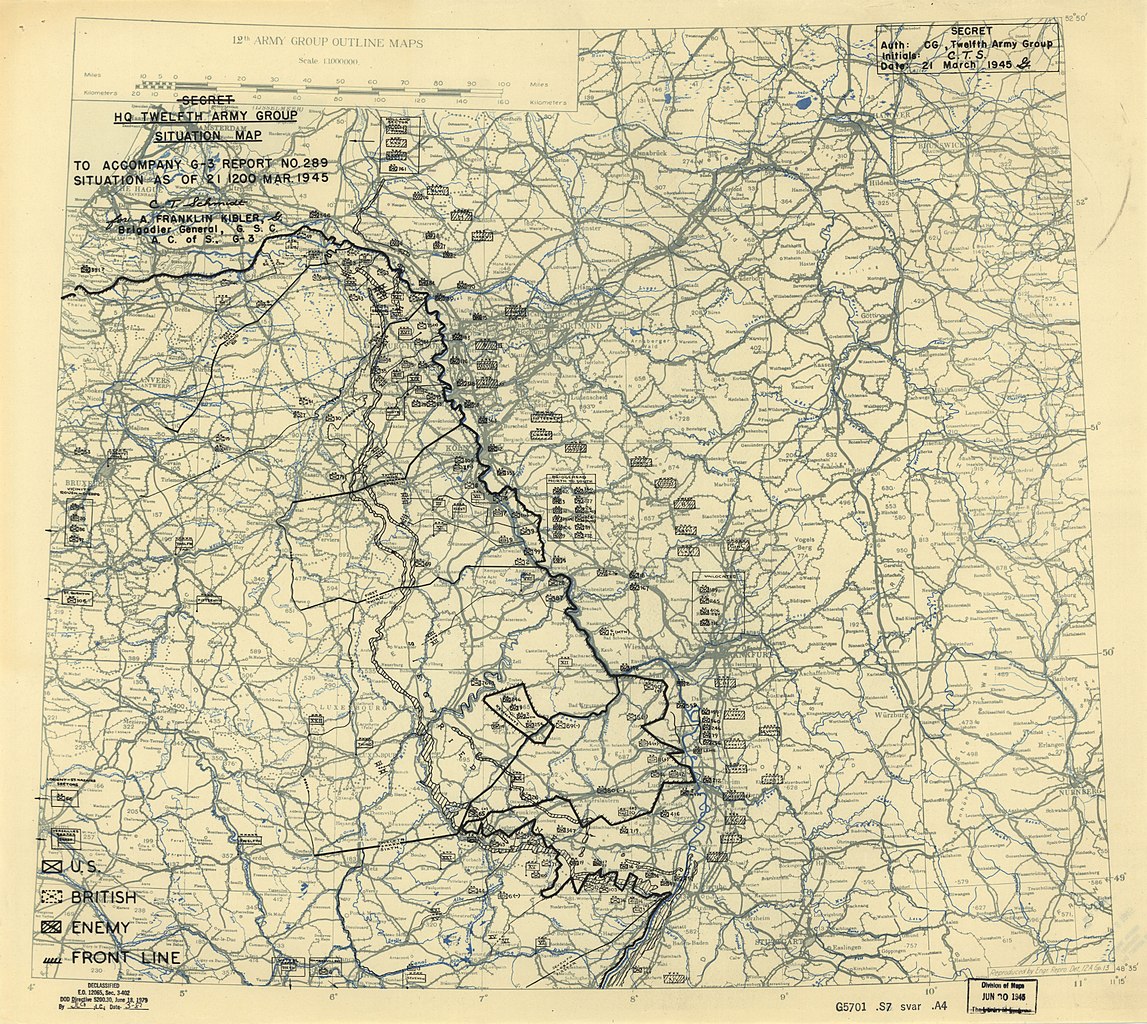 Most of US 3rd Army forces are engaged in clearing German resistance on the west bank of the Rhine River, to the north of Mannheim. Other elements of US 3rd and US 7th Army units are cooperating to take Annweiler, Neunkirchen, Neustadt and Homberg. Photo: The crew of a Sherman tank of the British 8th Armoured Brigade loading ammunition for the 75-mm gun near Xanten, Germany, 21 March 1945 Photo: 5.5-inch guns of 235 and 336 Medium Batteries, Royal Artillery, line up to fire in support of the Rhine crossing, 21 March 1945 Photo: 5.5-inch guns of 235 and 336 Medium Batteries, Royal Artillery, line up to fire in support of the Rhine crossing, 21 March 1945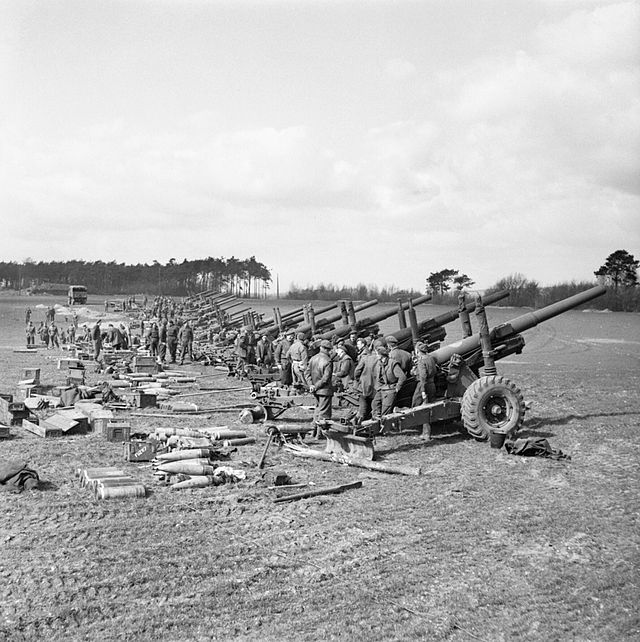 Photo: Buffaloes of 4th Royal Tank Regiment being transported forward in preparation for crossing the Rhine, 21 March 1945. Photo: Buffaloes of 4th Royal Tank Regiment being transported forward in preparation for crossing the Rhine, 21 March 1945.
 Photo: LVT Buffaloes of 4th Royal Tank Regiment near Xanten, 21 March 1945 Photo: LVT Buffaloes of 4th Royal Tank Regiment near Xanten, 21 March 1945 Patton's US 3rd Army captures Mainz. US 7th Army and US 3rd units met. Their pincer movement had destroyed the German Seventh Army, and left the First Army, the only German force west of the Rhine, in desperate straits. Moreover, Patton reported that all three of his corps had reached the Rhine. Photo: Infantry moving through Homburg on the road to Kaiserslautern in trucks to regain contact with retreating enemy. 21 March, 1945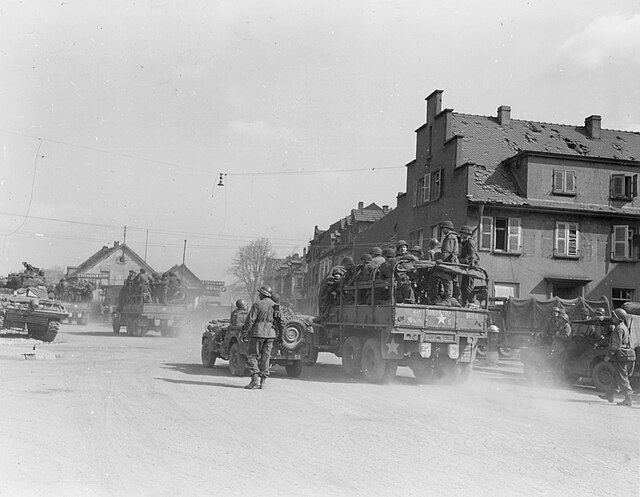 Photo: After crossing main river, infantrymen of the 5th Division, Third U.S. Army, advance into Frankfurt, Germany, in pursuit of fleeing Nazis. 21 March, 1945 Photo: After crossing main river, infantrymen of the 5th Division, Third U.S. Army, advance into Frankfurt, Germany, in pursuit of fleeing Nazis. 21 March, 1945 On 21 March a massive Allied ground force thus lay poised along the Rhine from Arnhem to Switzerland. Eisenhower's awesome armies, containing some 4.5 million personnel, included ninety divisions that anxiously awaited the final drive into the heart of the Nazi Reich. Map: Rhineland Campaign - 11-21 March 1945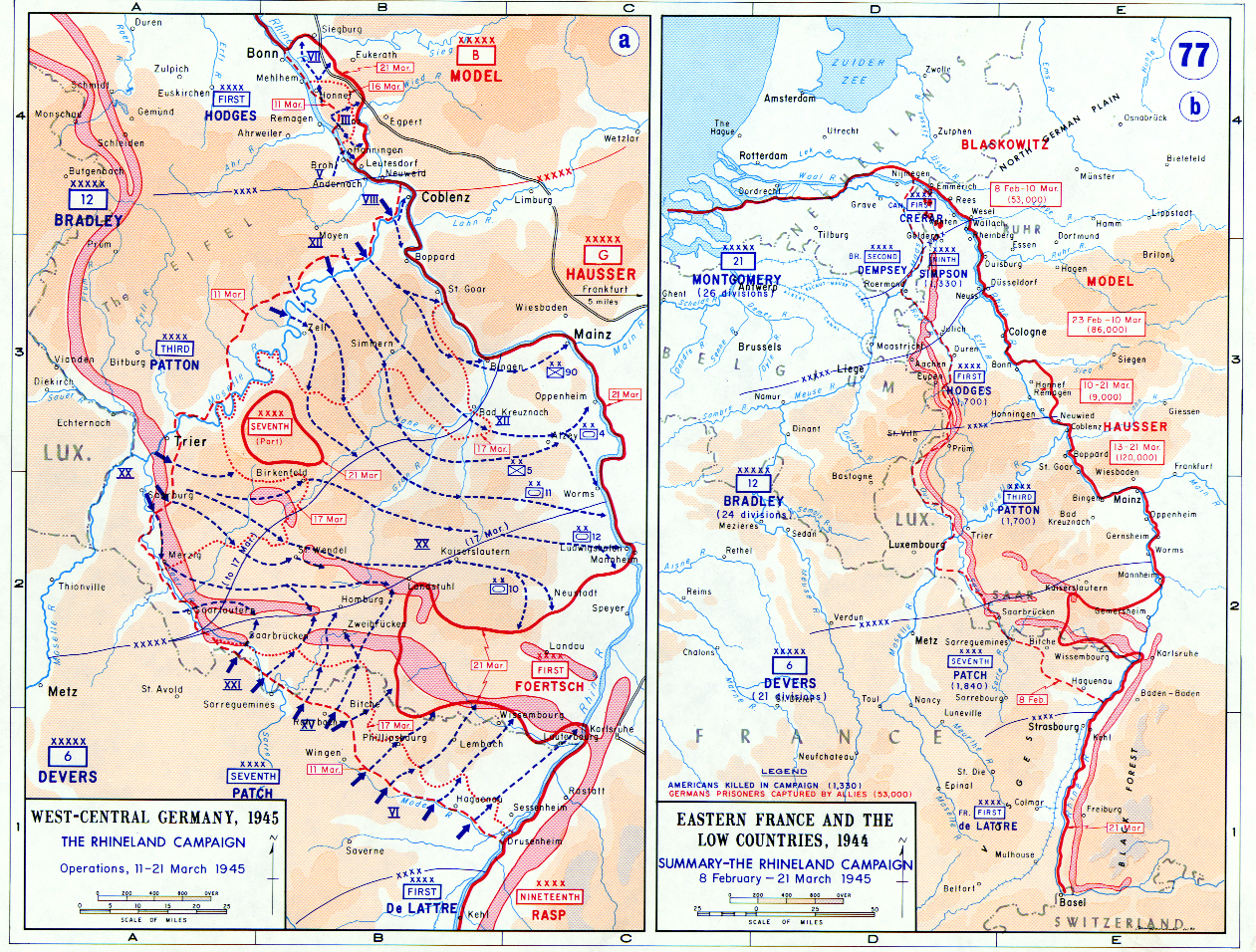 Air War over Europe Air War over Europe British Mosquito bombers attack and destroy the German Gestapo headquarters in Copenhagen. Some of the bombs dropped land on a nearby school, killing 86 students and 17 teachers. Photo: The bombing was a part of the Operation Carthage. The bombs where ment to hit the Shellhouse (Gestapo's headquarters), but one of the pilots dropped the bombs over the school because it lost control over the plane. After that the other pilots thought the school was the Shellhouse and dropped their bombs as well, 21 March 1945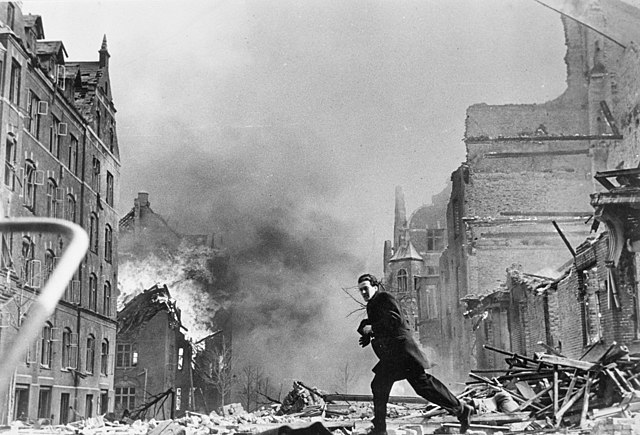 178 RAF aircraft - 150 Halifaxes, 16 Lancasters, 12 Mosquitos - of Nos 4, 6 and 8 Groups carried out an accurate attack upon the railway yards and the surrounding town area at Rheine. 1 Lancaster lost. 160 RAF Lancasters of No 3 Group attacked the railway yards at Münster and a nearby railway viaduct. 3 Lancasters lost. The only information available from Münster is that 17 people were killed. 133 RAF Lancasters and 6 Mosquitos of Nos 1 and 8 Groups attacked the Deutsche Vacuum oil refinery at Bremen .This appeared to be an accurate raid in clear weather conditions. No aircraft lost. 20 RAF Lancasters of No 617 Squadron attacked the Arbergen railway bridge just outside Bremen. 2 piers of the bridge were destroyed. 1 Lancaster lost. 151 RAF Lancasters and 8 Mosquitos of No 5 Group attacked Hamburg. 4 Lancasters lost. The target for this raid was the Deutsche Erdölwerke refinery .The attack was accurate; 20 storage tanks were destroyed and the plant was still out of action at the end of the war. 131 RAF Lancasters and 12 Mosquitos of Nos 1 and 8 Groups carried out an accurate attack on the benzol plant at Bochum. 1 Lancaster lost. 142 RAF Mosquitos in 2 attacks on Berlin (with some aircraft making 2 sorties), 3 Mosquitos to Bremen, 26 RCM sorties, 56 Mosquito patrols, 7 Mosquitos of No 5 Group minelaying in Jade Bay and the River Weser. 1 Mosquito from the Berlin raid and 1 RCM Fortress lost. (US Eighth Air Force): 5 missions are flown. Mission 901: Preparatory air operations for the forthcoming (23 Mar) crossing of the lower Rhine River by Allied ground forces begin. 1,408 bombers and 806 fighters, in conjunction with Ninth Air Force and RAF aircraft, attack jet fighter bases; with one exception, all attacks are visual; they claim 58-3-49 Luftwaffe aircraft; 7 B-17s and 9 P-51s are lost: 1. 107 of 152 B-17s hit the secondary target, the tank factory at Plauen; targets of opportunity are Reichenbach (34) and other (1); they claim 3-3-3 aircraft; 5 B-17s are lost and 48 damaged. The escort is 273 of 314 P-51s; they claim 9-0-0 aircraft in the air and 3-0-0 on the ground; 3 P-51s are lost (pilots MIA) and 1 damaged beyond repair. 2. 129 of 151 B-17s attack Hardorf Airfield; 14 others hit Vorden Airfield, a target of opportunity; 1 B-17 is lost, 1 damaged beyond repair and 71 damaged. Escorting are 94 of 98 P-51s; they claim 0-0-2 aircraft in the air. 3. 214 B-17s are sent to attack the airfields at Zwischenahn (57), Marx (77) and Wittmundhafen (74); casualties for 1., 2. and 3. above are 7 WIA and 56 MIA. 108 of 109 P-51s escort and claim 2-0-8 aircraft on the ground; 1 P-51 is lost (pilot MIA). 4. 518 B-24s are dispatched to hit airfields at Ahlhorn (61), Hesepe (165), Achmer (180) and Mulheim Airfield at Essen (90); 21 B-24s are damaged. Escorting are 95 of 99 P-51s; they claim 35-0-30 aircraft on the ground; 3 P-51s are lost (pilots MIA). 5. 373 B-17s are sent to hit airfields at Hopsten (159 using Gee-H) and Rheine (180); targets of opportunity are the airfields at Hesepe (13) and Achmer (12); 1 B-17 is lost and 49 damaged; 1 airman is KIA, 3 WIA and 9 MIA. 97 of 102 P-51s escort; they claim 6-0-0 aircraft on the ground. 6. 36 P-51s fly a sweep over Giebelstadt Airfield and claim 0-0-6 aircraft on the ground. 7. 13 P-51s escort 9 F-5s, 1 P-38 and 1 Spitfire on photo reconnaissance missions over Germany. 8. 35 P-51s fly a scouting mission. Mission 902: In a Disney operation, 3 B-17s attack the E-boat pens at Ijmuiden, the Netherlands with rocket bombs; 6 P-51s escort. Mission 903: 1 B-17 bombs Oberursel in a Micro-H Mk II radar test; 4 P-51s escort. Mission 904: During the afternoon, 90 of 92 B-24s attack Mulheim Airfield at Essen; 60 are damaged and 1 airman is WIA. Mission 905: 8 of 9 B-24s drop leaflets in the Netherlands and Germany during the night. (US Ninth Air Force): In Germany, 580+ A-20s, A-26s, and B-26s strike 6 communications centers and a marshalling yard E of the Rhine River, along with several casual targets, in the interdiction campaign to obstruct enemy movement; fighters fly patrols and armed reconnaissance, attack railroads and bridges, support the US VII Corps as its units reach the Sieg River near Siegburg, cooperate with the XII Corps as more of its elements reach the Rhine River at various points between Boppard and Worms, and support the XX Corps as additional units reach the Rhine between Worms and Mannheim. (US Fifteenth Air Force): 660+ B-24s and B-17s, with fighter escorts, bomb the Neuburg an der Donau Airfield, Germany, marshalling yards at Villach (2 yards), Klagenfurt, Graz and Bruck and der Mur, Au Italian campaign(US Twelfth Air Force): A-20s continue to attack communications in the Po Valley especially the Po River crossings during the night of 20/21 Mar; during the day fighter-bombers concentrate on railroad targets (lines, trains, bridges, and viaducts) and dumps in the Po Valley and areas N of the battleline in the N Apennines; medium bombers bomb a railroad fill at Salorno, bridges at Casarsa della Delizia and Pizzighettone, marshalling yards at Vipiteno and Brennero, and bridge approaches at Campo. The 86th and 87th Fighter Squadrons, 79th Fighter Group, move from Fano to Cesenatico, Italy with P-47s. Photo: Churchill tanks of the North Irish Horse laying down indirect fire on German positions, Alfonsini-Mezzano sector, 21 March 1945 Photo: Churchill tanks of the North Irish Horse lay down indirect fire on enemy positions in the Alfonsi sector, Italy, 21 March 1945 Photo: Churchill tanks of the North Irish Horse lay down indirect fire on enemy positions in the Alfonsi sector, Italy, 21 March 1945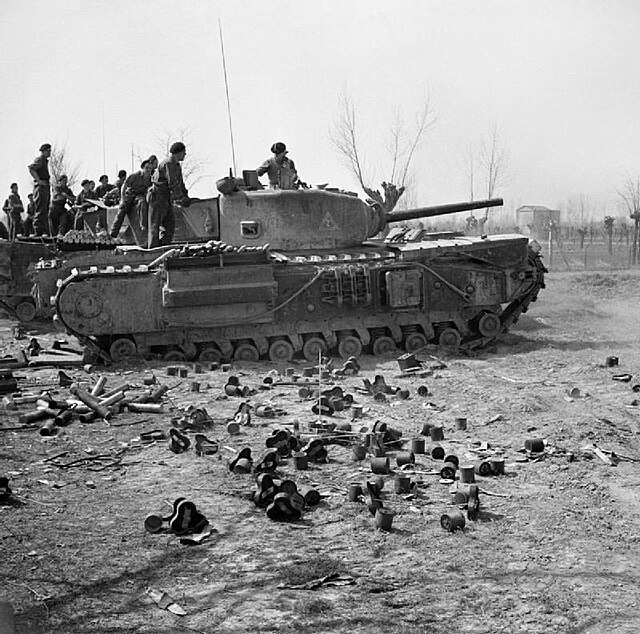 Photo: A Churchill ARV recovers a Churchill tank of the North Irish Horse that had slid down a steep bank, in the Alfonsini sector near Mezzano, 21 March 1945 Photo: A Churchill ARV recovers a Churchill tank of the North Irish Horse that had slid down a steep bank, in the Alfonsini sector near Mezzano, 21 March 1945 Germany GermanyGuderian fails to get Heinrich Himmler to go with him to Berlin to persuade Hitler to seek an armistice. Pacific WarCHINA (Fourteenth Air Force): 4 P-51s damage several locomotives and boxcars at Vinh Airfield, French Indochina and along the railroad to the N. 6 B-24s claim 1 vessel damaged in S China Sea. INDIA-BURMA (Tenth Air Force): In Burma, 30 P-47s support Chinese ground forces in the Hsipaw area; 34 P-38s sweep roads S of the bomb line; 13 B-25s and 18 P-47s attack troop concentrations and vehicles at several points behind the Japanese lines; 526 air supply sorties are flown to the forward areas; in ground action in the area of the British Fourteenth Army's 33 Corps, organized resistance ceases in Mandalay and Allied forces completely take over that city. BURMA Photo: Admiral Lord Louis Mountbatten, Supreme Allied Commander South East Asia, sits astride a captured Japanese 75mm gun while addressing men of the Royal Armoured Corps in Mandalay, 21 March 1945 Photo: Jeeps adapted for running on railway tracks head southwards from Mandalay, Burma, 21 March 1945 Photo: Jeeps adapted for running on railway tracks head southwards from Mandalay, Burma, 21 March 1945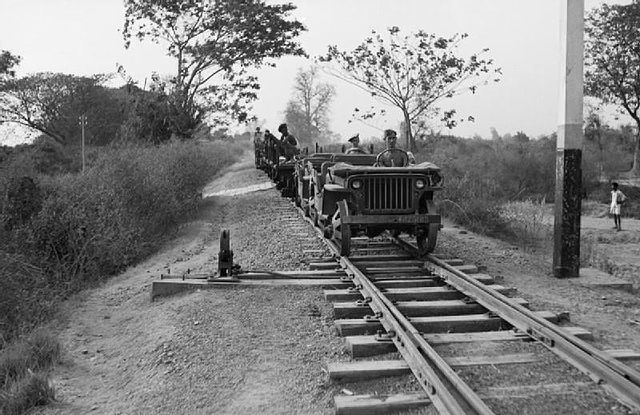 GUAM Seventh Air Force: 13 B-24s, based on Guam hit Susaki Airfield, which is hit again during the night of 21/22 Mar by 5 more, flying separate strikes. VII Fighter Command: 16 P-51s from Iwo Jima strafe and bomb barracks and radio and radar installations on Chichi Jima. PHILIPPINE CAMPAIGN (1945) Patrols land on Guimaras Island across Iloilo Strait from Iloilo, Panay, and find it clear of Japanese troops. B-25s, A-20s, and fighters continue large-scale support missions, hitting a variety of targets including Japanese defenses at Lipa and Tarlac and the town of Naga and Camiling. In the C Philippines B-24s hit targets near Cebu City while A-20s pound other towns on Cebu. B-24s bomb Samah Airfield on Hainan. B-25s on a shipping sweep attack and set afire a freighter SE of Nanao, China. HQ 42d BG (Medium) and the 390th Bombardment Squadron (Medium) move from Morotai to Puerto Princesa with B-25s; the 67th Fighter Squadron, 347th FG, ceases operating from Morotai with P-38s and returns to base at Puerto Princesa. VOLCANO AND RYUKYU ISLANDS CAMPAIGN US Task Force 58 (Admiral Mitscher) is replenishing in preparation for operations around Okinawa. The Japanese 5th Air Force deploys the first Ohka piloted rocket bombs, slung under Misubishi bombers, against the American fleet. The flight of 18 aircraft is intercepted by carrier aircraft and all but one are shot down. Admiral Spruance, command the US 5th Fleet, is present for the operations. ADMIRALTY ISLANDS Photo: The U.S. Navy attack transport USS Titania (AKA-13) and the motor torpedo boat tender USS Mobjack (AGP-7) in drydock of the Navy Advanced Base Section Dock no. 2 (USS ASBD-2) at Manus, Admiralty Islands, prior to undocking, 21 March 1945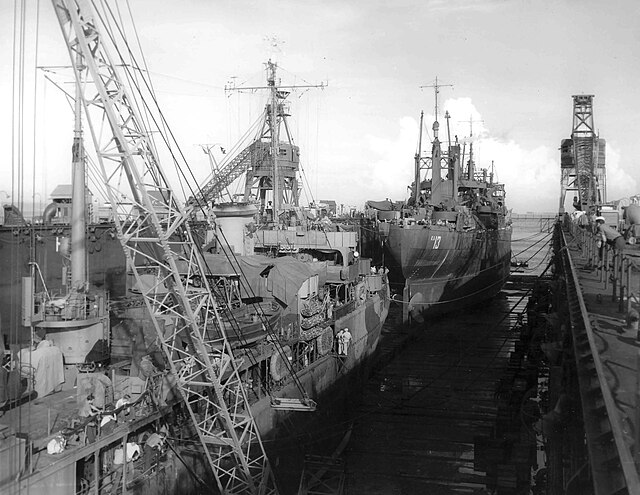 UNITED STATES NAVY DEPARTMENT COMMUNIQUES, N. D. COMMUNIQUÉ NO. 586, MARCH 21, 1945 The submarine USS Barbell is overdue from patrol and is presumed lost. Next of kin of officers and crew have been notified. UNITED STATES NAVY DEPARTMENT COMMUNIQUES, CINCPOA COMMUNIQUÉ NO. 306, MARCH 21, 1945 On March 20 (East Longitude Date) Army Liberators of the Strategic Air Force bombed the airfield on Chichi Jima in the Bonins. Army Mustang Fighters based on Iwo dive bombed barracks, a radio station and other installations on Chichi on the following day. Navy search Venturas of Fleet Air Wing Four made rocket and strafing attacks on buildings and small craft at Hayake Kawa on Paramushiru in the Kuriles on March 19. On the same day Mitchells and Liberators of the Eleventh Army Air Force bombed and strafed canneries, buildings, and radio installations in southern Paramushiru. Fighters, dive bombers, and torpedo planes of the Fourth Marine Aircraft Wing carried out rocket and bombing attacks on airfield installations, piers, and buildings on Yap in the western Carolines on March 21. Navy search Privateers of Fleet Wing Two caused an explosion and fire after bombing attacks on Wake Island on March 20. PACIFIC Two U.S. motor torpedo boats, supported by a British destroyer, attack enemy shipping in Sarawak harbor. Japanese convoy HI-88I comes under attack off coast of French indochina. Submarine Baya (SS-318) sinks auxiliary netlayer Kainan Maru off Cam Ranh Bay, 12°00'N, 109°17'E, and although damaged by depth charges, 11°55'N, 109°18'E, remains on patrol. USAAF B-25s (Fifth Air Force) sink submarine chaser Ch 33, cable layer Tateishi, and cargo vessels No.1 Motoyama Maru and 2 Fushimi Maru and No.6 Takasago Maru and damage submarine chaser Ch 9 off Nha Trang, 11°50'N, 109°18'E. Surviving vessels, the damaged Ch 9 and merchant tanker No.30 Nanshin Maru take refuge at Nha Trang and are assigned to convoy HI-88-J. Japanese gunboat Okitsu is damaged by U.S. aircraft near Cape Hung Hua.
|
|
lordroel
Administrator
Member is Online
Posts: 68,017 
Likes: 49,422
|
Post by lordroel on Mar 22, 2024 7:19:10 GMT
Day 2019 of World War II, March 22nd 1945Eastern FrontIn Silesia, troops of the 1st Ukrainian Front achieve a breakthrough in attacks over the Oder River to the south of Oppeln as well as extending an existing bridgehead to the north of the town. In the Polish Corridor, the Soviet forces continue fighting to reach the Baltic between Gdynia and Danzig. Western Front (1945) - Western Allied invasion of GermanyMap: HQ Twelfth Army Group situation map, March 22nd 1945 The US 5th Division (an element of US 3rd Army) establishes a bridgehead over the Rhine River near Nierstein. Other US 3rd Army units are completing the mopping up west of the Rhine and preparing to make crossings of their own. In the north, British 21st Army Group (Montgomery) forces are also preparing to establish bridgeheads over the Rhine. Photo: The Commander of the 21st Army Group, Field Marshal Sir Bernard Montgomery (left), the Commander of the 2nd Tactical Air Force, Air Marshal Sir Arthur Coningham (centre) and the Commander of the British 2nd Army, Lieutenant General Sir Miles Dempsey, talking after a conference held in a small German village attended by all Senior Officers of the 21st Army Group and 2nd Tactical Air Force. At the conference Field Marshal Montgomery gave the order for the 2nd Army to begin the assault crossing of the Rhine, 22 March 1945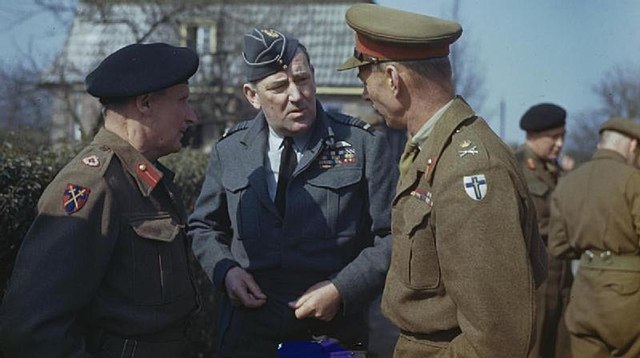 Photo: Infantrymen of 26th Division, 3rd US Army, ride into action on a light tank. Just behind them a mortar crew has gone into action, near Neustadt, Germany. 22 March, 1945 Photo: Infantrymen of 26th Division, 3rd US Army, ride into action on a light tank. Just behind them a mortar crew has gone into action, near Neustadt, Germany. 22 March, 1945 Photo: Tanks of the 9th Armored Division, 1st U.S. Army, move through Leutesdorf, Germany, on the east bank of the Rhine. With very little opposition, 22 March 1945 Photo: Tanks of the 9th Armored Division, 1st U.S. Army, move through Leutesdorf, Germany, on the east bank of the Rhine. With very little opposition, 22 March 1945 Air War over Europe Air War over Europe HQ 69th Tactical Reconnaissance Group and the 10th Tactical Reconnaissance Squadron arrive at Nancy, France from the US with F-6s; HQ 474th Fighter Group moves from Florennes, Belgium to Strassfeld, Germany; the 31st Tactical Reconnaissance Squadron, Ninth AF [attached to 9th Tactical Reconnaissance Group (Provisional)], arrives at Maastricht, the Netherlands from the US with F-6s; the 72d Liaison Squadron, Ninth Air Force (attached to Sixth Army Group), moves from Buhl to Sarreguemines, France with L-5s. 227 RAF Lancasters and 8 Mosquitos of Nos 1 and 8 Groups to Hildesheim. 4 Lancasters lost. The target was the railway yards; these were bombed but the surrounding built-up areas also suffered severely in what was virtually an area attack. This was the only major Bomber Command raid of the war on Hildesheim and the post-war British survey found that 263 acres, 70 per cent of the town, had been destroyed. Attack on Dülmen by 130 RAF aircraft - 106 Halifaxes, 12 Lancasters, 12 Mosquitos - of Nos 4 and 8 Groups. No aircraft lost. This was an area attack and the town was soon burning after a concentrated raid in clear weather conditions. No other details are available. 124 RAF aircraft - 100 Halifaxes, 12 Lancasters, 12 Mosquitos - of Nos 6 and 8 Groups bombed Dorsten. Dorsten was a rail and canal centre and also the location of a Luftwaffe fuel dump. All these targets were believed to have been hit but the town probably suffered as well. No aircraft were lost. 100 RAF Lancasters of No 3 Group carried out a G-H attack on the town of Bocholt, probably with the intention of cutting communications. The town was seen to be on fire. No aircraft lost. 102 RAF Lancasters of No 5 Group attacked bridges at Bremen (82 aircraft) and Nienburg (20 aircraft of No 617 Squadron). The bridge at Nienburg was destroyed; the bombing at the Bremen bridge appeared to be accurate but no results were seen. No aircraft lost. Photo: "Nienburg RR Brigde," 22 March 1945 (US Eighth Air Force): 2 missions are flown. Mission 906: Air attacks in preparation for the lower Rhine River crossing by Allied ground forces continue; 1,331 bombers and 662 fighters attack barracks and military encampments in the Ruhr and airfields in Germany visually; they claim 27-1-12 Luftwaffe aircraft; 1 B-17 and 3 P-51s are lost: 1. 99 of 114 B-17s hit Ahlhorn Airfield; 13 others hit the marshalling yard at Oldenburg, a target of opportunity; 1 B-17 is lost; 9 airmen are MIA. Escorting are 95 of 99 P-51s. 2. 457 B-17s are sent to hit military camps at Bottrop (36), Dorsten (74), Barningholten (111), Westerholt (116), Feldhausen N (74) and S (39); 3 B-17s are damaged beyond repair and 111 damaged; 2 airmen are KIA and 8 WIA. The escort is 95 of 99 P-51s. 3. 297 B-17s are sent to hit military camps at Hinsbeck (67), Geresheim (73), Ratingen (75) and Mulheim (74); 114 B-17s are damaged and 3 airmen are WIA. 48 P-51s escort; they claim 0-0-1 aircraft on the ground. 4. 342 B-24s are dispatched to hit airfields at Kitzingen (168), Giebelstadt (75) and Schwab Hall (82); 8 others hit Wurzburg, the secondary target; 1 B-24 is damaged beyond repair and 1 damaged; 8 airmen are KIA. The escort is 138 of 153 P-51s; they claim 3-0-1 aircraft in the air and 13-0-7 on the ground. 5. 109 of 113 B-17s hit the Rhein Main Airfield at Frankfurt; 31 B-17s are damaged. Escorting are 56 P-51s. 6. 6 B-17s fly a screening mission. 7. 19 of 22 P-51s escort 19 of 22 F-5s on photo reconnaissance missions over Germany; they claim 11-1-3 aircraft in the air. 8. 2 B-17s and 31 of 32 P-51s fly a scouting mission. 9. 150 of 153 P-51s escort Fifteenth AF bombers from Italy. Mission 907: 9 of 10 B-24s drop leaflets in the Netherlands and Germany. (US Ninth Air Force): In Germany, nearly 800 A-20s, A-26s, and B-26s bomb 9 communications centers and a marshalling yard E of the Rhine River (plus 7 towns, flak positions, and a target of opportunity) as part of the interdiction program to impede the movement of supplies and troops; fighters escort the bombers, attack railroads and other assigned targets, fly patrols and armed reconnaissance, support the US 1st and 9th Infantry Divisions SE of Honnef and along the Wied River, cooperate with the XII Corps as it begins crossing the Rhine River in the Mainz-Oppenheim areas and with the XX Corps which begins an attack on Ludwigshafen. (US Fifteenth Air Force): 680+ B-17s and B-24s (with Eighth and Fifteenth AF fighter escort) hit the Ruhland, Germany and Kralupy and Vltava, Czechoslovakia oil refineries (some bombers on the Ruhland raid bomb the Lauta aluminum works to the N), a railroad communications and ordnance depot, a marshalling yard, and 2 oil refineries at Vienna, Austria, marshalling yards at Graz, Wels, Zeltweg and Klagenfurt, Austria, and Neratovice, Czechoslovakia, and scattered targets of opportunity; reconnaissance and reconnaissance escort missions are also flown. Italian campaign(US Twelfth Air Force): In Italy during the night of 21/22 Mar, A-20s and A-26s continue intruder raids concentrating on Po River crossings in the E Po Valley; during the day P-47s blast rail lines, trains and other communications targets, especially in the E Po Valley and areas to the N. In Austria, B-25s destroy a bridge at Brixlegg, severely damage the Steinach bridge, and hit bridge approaches at Muhlberg and the town of Matrei am Brenner. Weather prevents successful attacks on 2 targets in N Italy. Photo: Infantry of 17 Platoon, 'H' Company, 2nd London Irish Rifles hurl hand grenades during an attack on a German strongpoint on the southern bank of the River Senio, 22 March 1945 Photo: A 2-inch mortar team of 2nd London Irish Rifles in action during an attack on a German strongpoint on the River Senio, 22 March 1945 Photo: A 2-inch mortar team of 2nd London Irish Rifles in action during an attack on a German strongpoint on the River Senio, 22 March 1945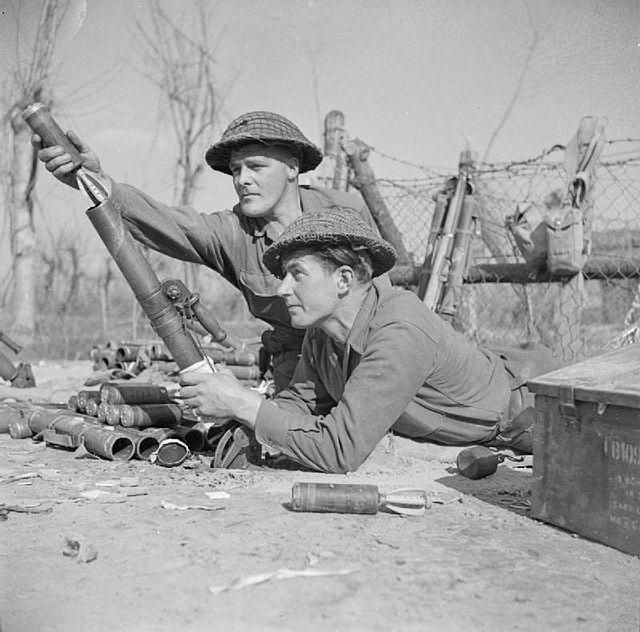 Photo: Infantry of 17 Platoon, 'H' Company, 2nd London Irish Rifles move forward through barbed wire defences on their way to attack a German strongpoint on the southern bank of the River Senio, 22 March 1945 Photo: Infantry of 17 Platoon, 'H' Company, 2nd London Irish Rifles move forward through barbed wire defences on their way to attack a German strongpoint on the southern bank of the River Senio, 22 March 1945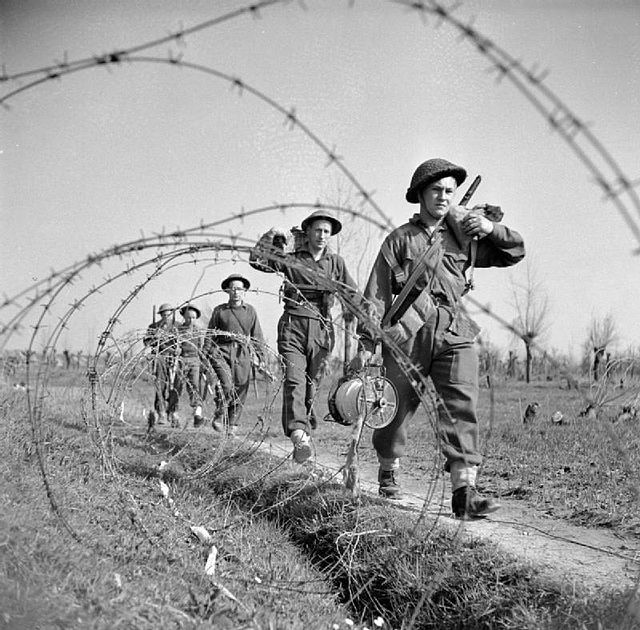 Battle of the Atlantic Battle of the Atlantic German submarines attack Wales-bound convoy TBC 102 and Ghent, Belgium-bound convoy BTC 103. In the former, U-399 torpedoes and sinks U.S. freighter John R. Park, 49°56'N, 05°26'W (all hands are rescued by U.S. freighter American Press); in the latter, what is most likely U-1195 torpedoes and sinks freighter James Eagan Lane, 50°13'N, 04°14'W. British freighter Monkstone and rescue tug Flaunt rescue the survivors. A skeleton crew (including four Armed Guard sailors) reboard the freighter and rig the ship for towing. Tugs Flaunt and Atlas beach the ship at Whitesand Bay, but James Eagan Lane is ultimately written off as a total loss. U.S. freighter Charles D. McIver sinks after striking a mine as she leaves Antwerp, Belgium, in convoy ATM 100, 31°22'35"N, 03°05'50"W. British motor minesweeper BYMS 2279 rescues one of the four boatloads of survivors; the other three boatloads, rescued by a motor torpedo boat, find safety on board tank landing ship LST-430. Charles D. McIver is later written off as a total loss; there are no casualties among the merchant crew or the 27-man Armed Guard. SpainDon Juan, the pretender to the Spanish crown, demands the resignation of Franco and the restoration of the monarchy. United StatesPhoto: The U.S. Navy small seaplane tender USS Floyds Bay (AVP-40) underway off Houghton, Washington (USA), on 22 March 1945. Her camouflage is Measure 33, Design 1F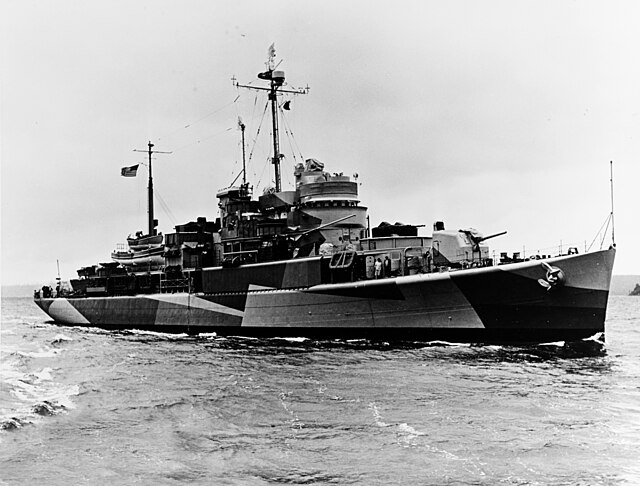 Photo: The U.S. Navy destroyer escort USS Hill (DE-141) off New York City (USA) on 22 March 1945. She is painted in Camouflage Measure 32, Design 3D. A few days later, she was repainted in Camouflage Measure 22 for service in the Pacific Photo: The U.S. Navy destroyer escort USS Hill (DE-141) off New York City (USA) on 22 March 1945. She is painted in Camouflage Measure 32, Design 3D. A few days later, she was repainted in Camouflage Measure 22 for service in the Pacific Photo: The U.S. Navy destroyer escort USS Herbert C. Jones (DE-137) underway off New York City (USA) on 22 March 1945. The "Liberty" ship S.S. Robert S. Lovett is behind her, at right Photo: The U.S. Navy destroyer escort USS Herbert C. Jones (DE-137) underway off New York City (USA) on 22 March 1945. The "Liberty" ship S.S. Robert S. Lovett is behind her, at right Pacific War Pacific War CHINA (Fourteenth Air Force): In China, 24 fighter-bombers and a single B-25 attack railroad traffic and railroad yards in and around Shihkiachwang, at Chukiatsi, and from Sinsiang to Chenghsien. (Twentieth Air Force): Mission 45: 76 of 78 B-29s, operating in 2 waves, blast storage dumps at Rangoon without loss. Photo: 468th Bombardment Group Boeing B-29s attacking Rangoon Burma, 22 March 1945 INDIA-BURMA (Tenth Air Force): In Burma, 16 fighter-bombers support Chinese ground forces near Hsipaw; 12 B-25s and 41 fighter-bombers hit numerous targets along and immediately behind the enemy lines; troops, supplies, and communications are attacked and 2 bridges are knocked out; 547 air supply sorties are flown to forward areas; the 71st Liaison Squadron, Tenth Air Force [attached to 1st Liaison Group (Provisional)], moves from Katha to Myitkyina with L-1s, L-4s, L-5s and UC-64s. GUAM Seventh Air Force: 13 B-24s from Guam bomb Susaki Airfield. 20 B-24s from Angaur Airfield bomb Cebu. During the night of 22/23 Mar, 4 B-24s from Guam make individual raids on Susaki Airfield. VII Fighter Command: 16 Iwo Jima based P-51s bomb and strafe a weather station fuel storage, and radar installations on Chichi Jima. SOUTHWEST PACIFIC AREA On Formosa, B-24s hit Tainan and Okayama Airfields, destroying several hangars, planes, and gun positions. PHILIPPINE CAMPAIGN (1945) Patrols land on Inampulugan Island in Guimaras Strait, and destroy a Japanese mine control station and eliminate the small garrison there. Japanese aircraft attack American shipping in Lingayen Gulf. During the ensuing antiaircraft barrage, friendly fire damages U.S. freighter Ransom A. Moore; there are, however, no casualties among the merchant crew or the 27-man Armed Guard. B-24s and A-20s (along with US Marine Corps aircraft) hit Cebu City, defenses at several locations on Cebu, and targets on Inampulugan nearby. On Luzon, B-24s, B-25s, A-20s, and fighters continue to hit numerous objectives, chiefly Balete Pass, Tangadon, San Fernando, and the Batangas areas. The 64th Bombardment Squadron (Heavy), 43d BG (Heavy), moves from Tacloban, Leyte to Clark Field, Luzon with B-24s; the 69th and 100th Bombardment Squadrons (Medium), 42d BG (Medium), cease operating from Morotai with B-25s and move to base at Puerto Princesa, Palawan; the 75th Bombardment Squadron (Medium), 42d BG (Medium), moves from Sansapor to Puerto Princesa with B-25s; and the 868th Bombardment Squadron (Heavy), Thirteenth AF, moves from Noemfoor to Morotai with B-24s (the squadron uses airborne radar for low-level attacks at night and for pathfinder operations). JAPAN The carriers of US Task Force 58 (Admiral Mitscher) are attacked by Japanese Kamikaze aircraft that fail to achieve significant success. However, it is noted that many of the attacks are made by manned rocket bombs. Admiral Spruance, commanding the US 5th Fleet, is present for the operations. PACIFIC Tank landing ship LST-727 is damaged by grounding off Iwo Jima, 24°46'N, 141°19'E. Submarine Perch (SS-313) sinks Japanese Communication Vessel No. 463 en route to Balikpapan, 01°03'S, 117°20'E. Japanese submarine chaser Ch 23 is damaged by mine at mouth of Yangtze River. Covered lighters YF-724 and YF-725 founder and sink in heavy weather 380 miles off the Farallones.
|
|
lordroel
Administrator
Member is Online
Posts: 68,017 
Likes: 49,422
|
Post by lordroel on Mar 23, 2024 14:59:07 GMT
Day 2020 of World War II, March 23rd 1945YouTube (Chiang versus Mountbatten)Eastern Front Three German Gotha-242 and DFS-230 transport planes land on the Kaiserstrasse runway in Breslau, as three others are shot down by Russian flak. They provide howitzer guns and 150 mm ammunition. Western Front (1945) - Western Allied invasion of GermanyMap: HQ Twelfth Army Group situation map, March 23rd 1945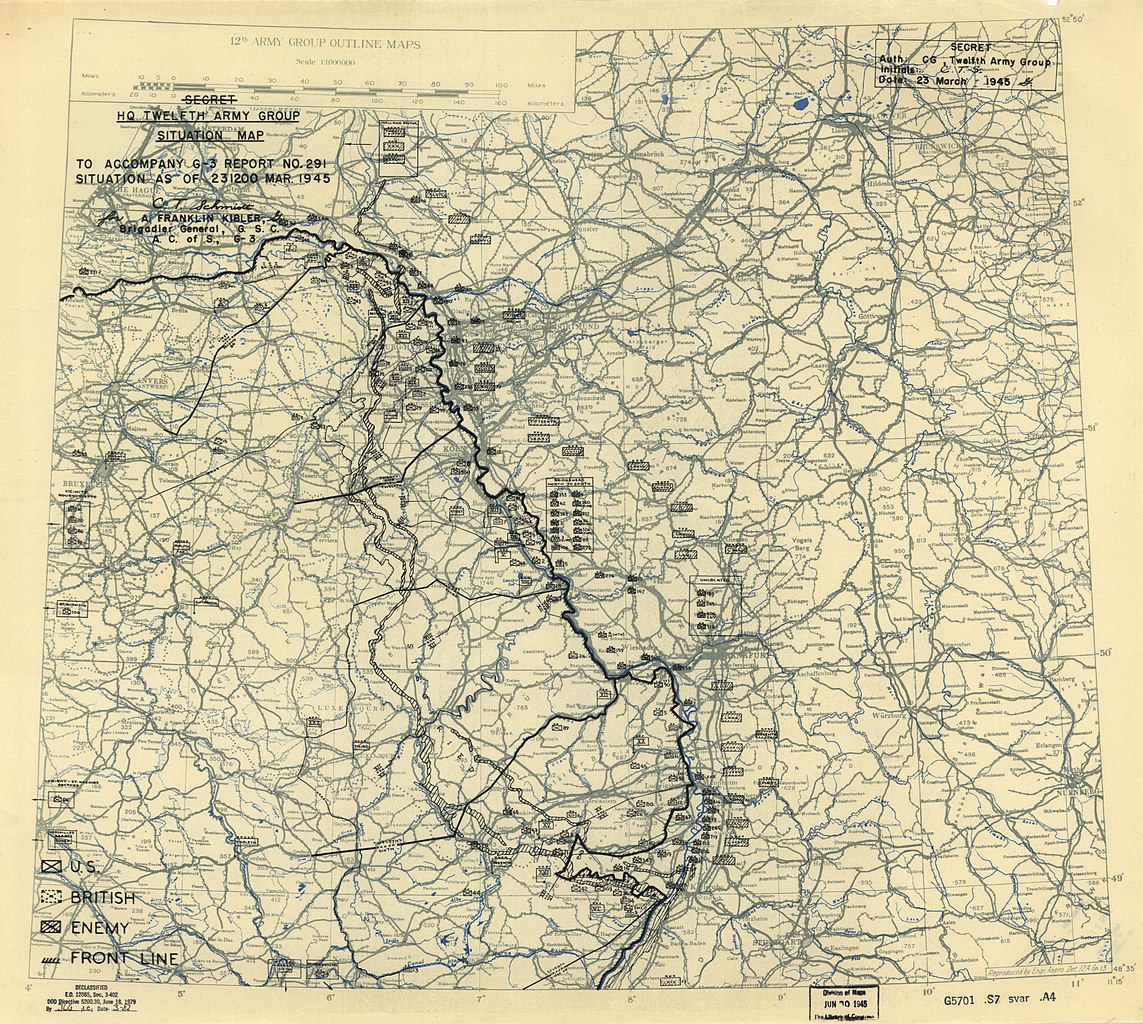 The British 2nd Army and Canadian 1st Army mount a carefully prepared operation, code named Plunder, to cross the Rhine River in the area from Emmerich to just south of Wesel. There is massive artillery and air support. Two parachute divisions are also to be dropped to aid the crossing. The operation begins at 2100 hours and continues in the moonlight. Photo: Crossing the Rhine 23 March 1945 : British commandos of the 1st Commando Brigade man two Vickers machine guns in the shattered outskirts of Wesel. The 1st Commandos had formed the spearhead of the British assault by making a surprise crossing in assault craft on the night of 23 - 24 March under a barrage of 1500 guns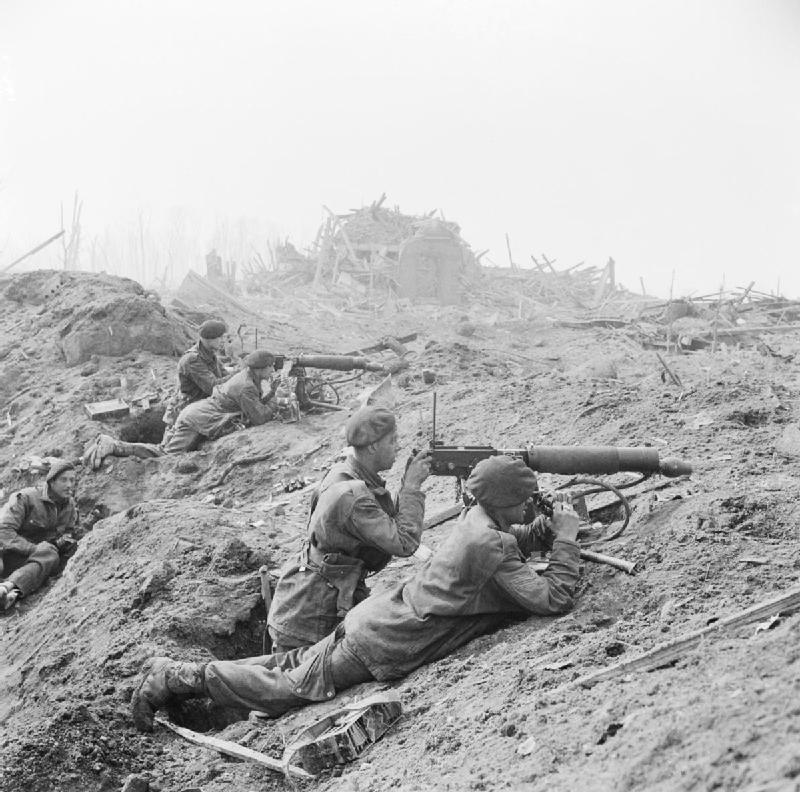 The US 1st Army and the elements of US 3rd Army are extending their bridgeheads over the Rhine. Photo: Diamond T Model 980 tractor towing a trailer loaded with a Churchill tank during preparations for crossing the Rhine, 23 March 1945 Photo: Troops stand on a Sherman Crab flail tank to watch Allied aircraft over Weeze during the Rhine crossing, 23 March 1945 Photo: Troops stand on a Sherman Crab flail tank to watch Allied aircraft over Weeze during the Rhine crossing, 23 March 1945 Air War over Europe Air War over Europe 195 RAF Lancasters and 23 Mosquitos of Nos 5 and 8 Groups carried out the last raid on the unfortunate town of Wesel. No aircraft lost. Wesel claims to have been the most intensively bombed town, for its size, in Germany. 97 per cent of the buildings in the main town area were destroyed. The population, which had numbered nearly 25,000 on the outbreak of war, was only 1,900 in May 1945. 80 RAF Lancasters of No 3 Group attacked Wesel, which was an important troop centre behind the Rhine front in an area about to be attacked by British troops. The raid was accurate and no aircraft were lost. Support and 78 training aircraft on a sweep across France and as far as Mannheim, 65 Mosquitos to Berlin and 23 to Aschaffenburg, 41 RCM sorties, 39 Mosquito patrols. 2 Mosquitos lost from the Berlin raid. Mosquitos of RAF Coastal Command attack shipping at Dalsfjord, Norway. The 107th Tactical Reconnaissance Squadron, 67th Tactical Reconnaissance Group, moves from Gosselies, Belgium to Vogelsang, Germany with F-6s. 128 RAF Lancasters of Nos 1 and 5 Groups attacked bridges at Bremen (117 aircraft) and Bad Oeynhausen (11 aircraft). Both bridges were hit. 2 Lancasters were lost from the Bremen raid. (US Eighth Air Force): 3 missions are flown. Mission 908: The Allied ground assault across the lower Rhine River begins; 1,276 bombers and 499 fighters visually attack rail targets in W and C Germany; they claim 1-0-1 Luftwaffe aircraft; 7 bombers are lost: 1. 319 B-24s are sent to hit the Rheine Bridge (79) and the Osnabruck (80) and Munster (142) marshalling yards; 2 others hit Hoya Airfield, a target of opportunity; 3 B-24s are lost, 1 damaged beyond repair and 95 damaged; 1 airman is KIA, 3 WIA and 35 MIA. Escorting are 79 of 80 P-51s. 2. 519 B-17s are sent to hit marshalling yards Hengstey (113), Giesecke (91), Holzwickede (184) and the Unna yard at Dormund (38); secondary targets hit are Meschede (19) and marshalling yards at Siegen (93) and Marburg (10); targets of opportunity are Herdecke (10), Haliger (1) and Schwerte (10); 3 B-17s are lost, 2 damaged beyond repair and 178 damaged; 6 airmen are KIA, 4 WIA and 27 MIA. 82 P-51s escort. 3. 438 B-17s are dispatched to hit marshalling yards at Coesfeld (145), Recklinghausen (120) and Gladbeck (141); targets of opportunity are Hechfeldt (12) and the marshalling yard at Westerholt (13); 1 B-17 is lost; 3 airmen are WIA and 10 MIA. The escort is 71 of 79 P-51s. 4. 125 of 131 P-51s fly a fighter sweep of the Bremen-Kassel area; they claim 1-0-0 aircraft in the air and 0-0-1 on the ground. 5. 71 of 84 P-51s fly a sweep for the Ninth AF. 6. 16 P-51s escort 15 F-5s and 4 Spitfires on photo reconnaissance missions over Germany. 7. 25 of 27 P-51s fly weather reconnaissance missions. Mission 909: 1 B-17, escorted by 4 P-51s, bombs Ettinghausen Airfield in a Micro-H Mk II radar test. Mission 910: During the night, 9 of 10 B-24s drop leaflets in the Netherlands and Germany; and 19 B-24s fly CARPETBAGGER missions to Denmark. (US Ninth Air Force): In Germany, around 800 A-20s, A-26s and B-26s strike 7 communications centers, a factory, and targets of opportunity (including several flak positions); attacks on communications centers are aimed at obstructing the movement of reinforcements to the front; fighters escort the bombers, fly patrols and armed reconnaissance, attack assigned ground targets, support the US III and VII Corps SE of Honnef and E of the Wied River and the XII and XX Corps astride and on the W bank of the Rhine River between Mainz and Worms. (US Fifteenth Air Force): 658 B-17s and B-24s, (with fighter escort) hit oil refineries at Ruhland, Germany, and at Vienna, Austria, marshalling yards at Budejovice, Czechoslovakia and Gmund, Sankt Polten and Sankt Valentin, Austria, and a tank works at Sankt Valentin, plus scattered targets of opportunity. 40+ F-5s, P-38s and P-51s fly reconnaissance. Italian campaign General Vietinghoff takes over command of German forces in Italy replacing Field Marshal Kesselring who has been withdrawn to the Western Front. Throughout March there have been small attacks by both US 2nd and 4th Corps of US 5th Army in the area around the Pistoia-Bologna road and to the west. (US Twelfth Air Force): In Italy, A-20s attack loading points and crossings along the Po River during the night of 22/23 Mar; P-47s concentrate on communications and general movement in the lower Brenner area during the day; the fighter-bombers also blast several dumps in the C Po Valley; B-25s hit bridges, railroad fills, and bridge approaches in the Brenner area at Matrei am Brenner, Austria and Pordenone, Salorno, San Michele all' Adige, Vo Sinistro, Longarone, and Perca, Italy. Pacific WarCHINA (Fourteenth Air Force): In China, 28 B-24s bomb the Tsinan railroad shops and Yellow River bridge; 5 B-25s bomb town areas, storage facilities, and targets of opportunity at Sinsiang and Wu-yang and chiefly in the Hsiangcheng area; 50+ fighter-bombers attack troops, horses, and river, road, and railroad targets in N French Indochina and S and E China. INDIA-BURMA (Tenth Air Force): In Burma, 15 P-47s support Chinese ground forces, bomb troops, and positions at Nampongpang and Nakang; 16 P-47s hit targets of opportunity along roads from Mong Nawng to Wan Sing and to Kunlong, China; 11 P-47s hit quarters at Monglawng while 3 others attack supply dumps at Laihka; 9 B-25s bomb communications routes, creating 2 road blocks behind enemy lines. In large-scale air supply operations, 536 sorties are flown. BURMA As well as capturing Mandalay, British 33rd Corps units attack southward. Wundwin is taken by British 20th Indian Division on one flank of this advance. GUAM Seventh Air Force: During the night of 23/24 Mar, 5 Guam based B-24s, flying single-bomber strikes, pound Susaki Airfield. VII Fighter Command: 15 P-51s from Iwo Jima bomb and strafe various targets on Chichi Jima, Haha Jima, and Ani Jima. PHILIPPINE CAMPAIGN (1945) On Luzon, San Fernando is taken by US 1st Corps with help from Filipino guerrillas. B-24s, B-25s, A-20s, and fighters hit bomb Cebu City, hitting defenses on Cebu and other islands, and on Luzon, bomb the Antamok mines, Balete Pass, and the Tangadon areas, along with several other targets. B-24s also hit targets on Mindanao and fighter-bombers attack Takao, Formosa. The detachment of the 421st Night Fighter Squadron, 86th Fighter Wing, operating from Tacloban with P-61s, returns to base at San Marcelino. VOLCANO AND RYUKYU ISLANDS CAMPAIGN TF 58 (Vice Admiral Marc A. Mitscher) begins daily strikes against Japanese shipping and installations in the Okinawa area. TF 58 planes sink army cargo ship Kachosan Maru 25 miles northwest of Okinawa, 30°23'N, 128°40'E. Cargo vessel No.19 Yamato Maru is also sunk in these strikes. In addition, TF 58 aircrew also claim sinking one midget submarine and damaging another, and damaging Coast Defense Ship No.29 and submarine chaser Ch 58 off Sotsukozaki. ALASKA (Eleventh Air Force): An 8-bomber strike is called off due to weather. UNITED STATES NAVY DEPARTMENT COMMUNIQUES, CINCPOA COMMUNIQUÉ NO. 307, MARCH 23, 1945 Further reports by the Fifth Fleet of attacks by carrier aircraft on Japan during the period of March 18 to 21 (East Longitude Dates) reveal damage inflicted on the enemy air force in addition to that reported in communiqué No. 305 making the total: 281 aircraft shot out of the air. 275 aircraft destroyed on the ground. 175 aircraft probably destroyed or damaged on the ground. Reconnaissance reports indicate that extensive damage was done by our carrier aircraft to air installations at Oita, Omura, Kanoya, Kagoshima, Miyazaki, Saeki and Nittagahara during the attacks on Kyushu. Army Liberators of the Strategic Air Force bombed the airfield on Chichi Jima in the Bonins on March 21 and 22. Army Mustang fighters on March 22 and 23 attacked fuel dumps, a weather station and other installations on the same island. Corsair and Hellcat fighters and Avenger torpedo planes of the Fourth Marine Aircraft Wing bombed targets in the Palaus on March 22. Marine aircraft struck dock and airfield installations at Yap in the Western Carolines on March 22 and 23. Navy search aircraft of Fleet Air Wing Two continued neutralizing attacks on enemy‑held bases in the Marshalls on March 21. PACIFIC Destroyer Haggard (DD-555) is damaged when she rams and sinks Japanese submarine RO 41 in the Philippine Sea, 22°57'N, 132°19'E. Submarine Seahorse (SS-304) is damaged by aerial bomb off the Ryukyus, 26°00'N, 128°00'E. Submarine Spadefish (SS-411) attacks Japanese Sasebo-to-Ishigaki convoy SAI-05 in the East China Sea about 120 miles north-northwest of Amami O Shima, sinking transport Doryu Maru, 29°38'N, 127°36'E. Fleet tug Zuni (ATF-95) is damaged by grounding off Iwo Jima, 24°46'N, 141°19'E. USAAF B-24 (5th Air Force) sinks Japanese cargo ship Hokka Go Maru (ex-Chinese Peihua) 110 miles northeast of Wenchow, China, 29°21'N, 122°66'E. USAAF B-24 attacks Japanese Coast Defense Vessel No.40, 26°58'N, 120°29'E, but although the airmen claim damage to their quarry, she in fact escapes undamaged. Japanese destroyer Kuri is damaged by mine at mouth of Yangtze River. Photo: Aerial photo of a rendezvous between the British submarine HMS Telemachus (P321) and a No. 112 Air Sea Rescue Flight RAAF Consolidated Catalina (PBY-5A, s/n A24-54) in the Banda Sea, Netherlands East Indies, 23 March 1945. An engineer officer, injured in an accident, was transferred from the submarine to the Catalina by dinghy and flown to Darwin, Australia, for emergency surgery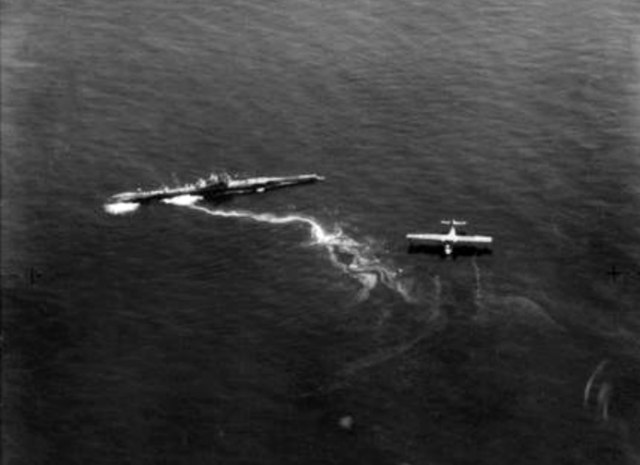
|
|
lordroel
Administrator
Member is Online
Posts: 68,017 
Likes: 49,422
|
Post by lordroel on Mar 24, 2024 6:41:41 GMT
Day 2021 of World War II, March 24th 1945Eastern FrontThe Red Army is preparing with great deliberation for its last campaign, the attack on Berlin, in its long march to the west from the very gates of its own capital. Marshal Zhukov, having taken the fortress of Kustrin, the last obstacle on the road to Berlin, is now enlarging his bridgehead across the Oder to set the scene for the drama which is about to unfold. With six infantry divisions and two tank brigades he has reached the road junction at Golzow, just 33 miles from greater Berlin. In the north, Marshal Rokossovsky is tightening his grip on Danzig and Konigsberg as the Germans continue their evacuation of East Prussia. It is General Schorner, rescued from command of the cut-off forces in Courland to take over Army Group A opposite Marshal Konev, who has felt the full weight of the Red Army. Konev has hit him hard near Oppeln in Silesia. Soviet forces capture Spolot on the Baltic coast between Gdynia and Danzig. In Hungary Marshal Tolbukhin finished off Hitler's ill-fated Operation Spring Awakening and is about to resume his march on Vienna. Szekesfehervar falls to the attacks of troops of 2nd Ukrainian Front. Meanwhile, the front line of the Soviet offensive has already pushed farther to the west, taking Veszprem and Mor. The German and Hungarian forces of German Army Group South are retreating in disorder after sustaining heavy losses. Western Front (1945) - Western Allied invasion of GermanyMap: HQ Twelfth Army Group situation map, March 24th 1945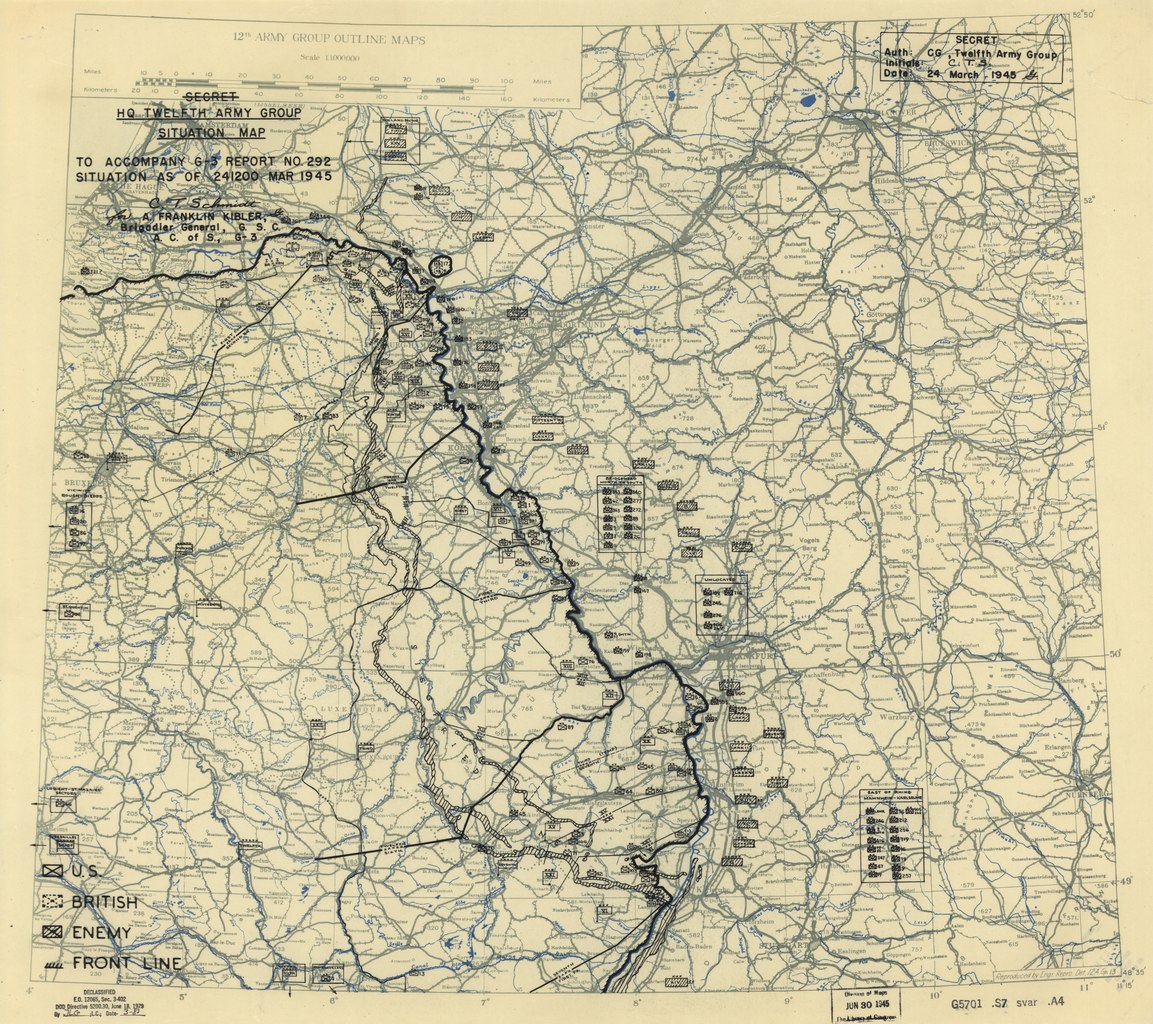 Operation Varsity begins, as 134 American and British gliders cross the Rhine Rive rin support for the 9th US and 2th British Armies' crossing of the Rhine. An enormous air armada crossed the River Rhein near Wesel in Western Germany. The column, two-and-a-half hours long, consisted of more than 1,500 IX Troop Carrier Command airplanes and gliders. To their left were about 1,200 RAF airplanes and gliders, supported by 880 US and RAF fighters. Over 21,000 airborne infantry were dropped north-east of Wesel. They quickly overcame enemy resistance and linked up with the main force. Only on the extreme left wing, near Emmerich, is resistance really tough. "The enemy", say the Canadians, "are fighting like madmen." There are now three bridgeheads between Wesel in the north and Mainz in the south: Montgomery's, Patton's and the US First Army's at Remagen. General Montgomery extends the bridgehead to a depth of 5 miles. With 1,250,000 Britons, Canadians and Americans under him, Montgomery has more than 5,500 artillery pieces, anti-tanks guns and rockets. The US 9th Army, now part of Montgomery's 21st Army Group, begins to cross the Rhine south of the British and Canadians. Photo: 5.5-inch guns firing in support of the Rhine crossing, 24 March 1945 Photo: 3-inch mortar of the 8th Royal Scots under enemy fire during the Rhine crossing, 24 March 1945 Photo: 3-inch mortar of the 8th Royal Scots under enemy fire during the Rhine crossing, 24 March 1945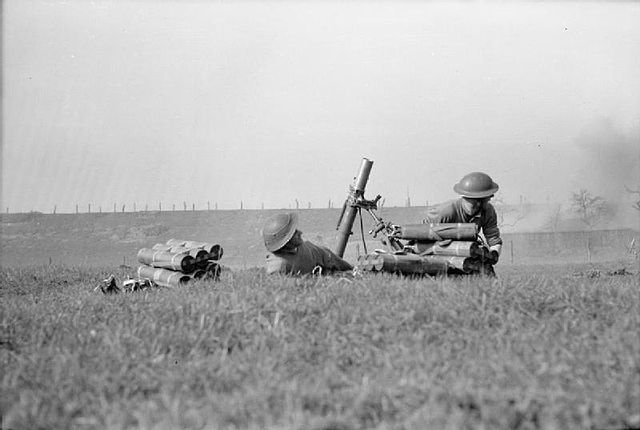 Montgomery's crossing of the Rhine was meticulously prepared and impatiently awaited. 100 miles to the south, Patton crossed the Rhine 24 hours ahead of Montgomery. He went across at Nierstein against light opposition and swept down on Darmstadt. The Canadian 51st Highland Div. of the British 2nd Army attacked German villages north of Reeserward. The Canadian 1st Black Watch brigade of the 51st Div. reaches the German town of Speldrop. Wesel had been reduced to rubble by Allied bombing and shelling, but the Germans clung on for the best part of 24 hours. Photo: Men of the 15th Scottish Division leave their assault craft after crossing the Rhine and double up the east bank to their assembly point near Xanten, 24 March 1945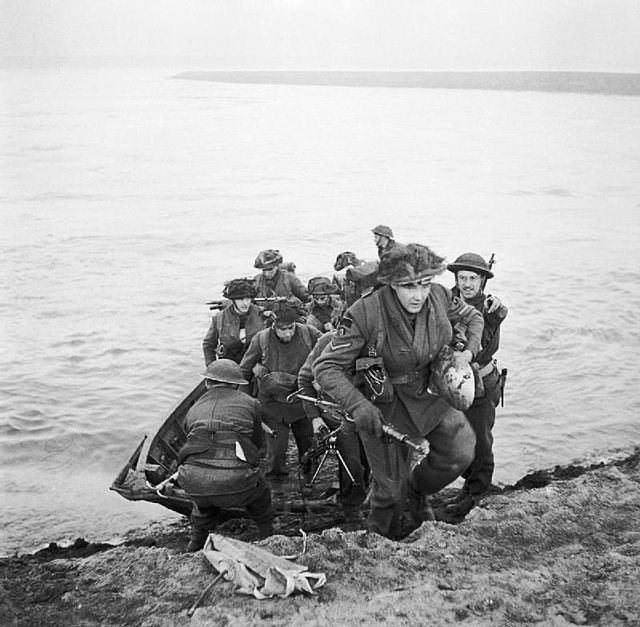 Photo: Men of the 1st Cheshire Regiment crossing the Rhine in Buffaloes at Wesel, 24 March 1945 Photo: Men of the 1st Cheshire Regiment crossing the Rhine in Buffaloes at Wesel, 24 March 1945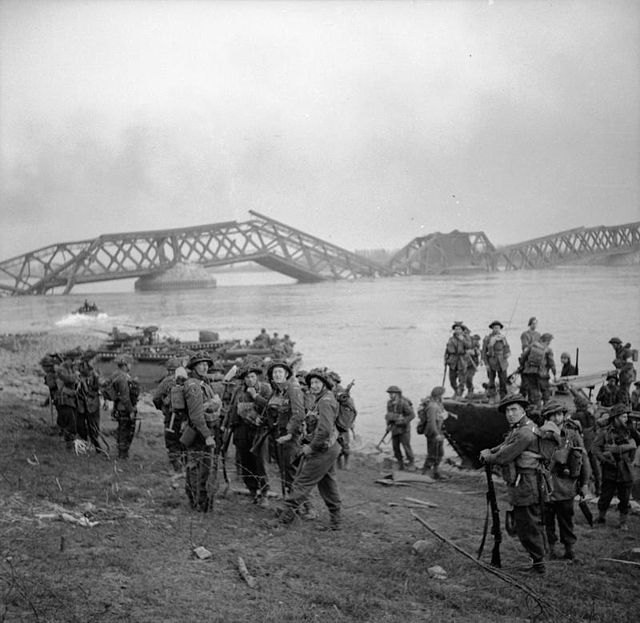 Photo: A Sherman ARV (armoured recovery vehicle) and other specialised armour moving up to cross the Rhine, 24 March 1945 Photo: A Sherman ARV (armoured recovery vehicle) and other specialised armour moving up to cross the Rhine, 24 March 1945 Photo: American soldiers cross the Rhine near Oppenheim with an M 36 over a ponton bridge erected on March 24, 1945 Photo: American soldiers cross the Rhine near Oppenheim with an M 36 over a ponton bridge erected on March 24, 1945 Air War over Europe Air War over Europe 177 RAF aircraft - 155 Halifaxes, 16 Lancasters, 6 Mosquitos - of 4 and 8 Groups attacked the railway yards at Sterkrade so successfully that, according to Bomber Command, there was 'complete destruction of a well packed marshalling yard'. No aircraft lost. 153 RAF Halifaxes, 16 Lancasters, 6 Mosquitos - of 6 and 8 Groups attacked Gladbeck situated on the northern edge of the Ruhr and not far from the new battle area. The target was 'devastated'. 1 Halifax lost. 173 RAF Lancasters and 12 Mosquitos of Nos 1, 6 and 8 Groups attacked the Harpenerweg plant at Dortmund and the Mathias Stinnes plant at Bottrop. 3 Lancasters were lost on the Dortmund raid. 67 RAF Mosquitos to Berlin, 8 to Nordheim and 2 which bombed both Berlin and Magdeburg on nuisance flights, 38 RCM sorties, 33 Mosquito patrols. No aircraft lost. (US Eighth Air Force): 2 missions are flown. Mission 911: In conjunction with the allied ground forces assault across the lower Rhine River (Operation VARSITY) the Eighth flies bombing, supply, and armed reconnaissance missions; during the day, 1,749 bomber sorties and 1,375 fighter sorties are flown to attack airfields visually in W and NW Germany in the morning and afternoon and drop supplies to US and British troops at midday; they claim 54-0-6 Luftwaffe aircraft; 19 bombers and 9 fighters are lost; 1. 175 of 179 B-17s bomb Vechta Airfield in the morning; 1 hits Rheine Airfield, a target of opportunity; 1 B-17 is lost; 1 airman is WIA and 9 MIA. 2. 527 B-17s are sent to hit Steenwijk (114), Zwischenahn (74), Varel (88), Varrelbusch (113) and Plantlunne (13) Airfields in the morning; targets of opportunity are Wittmundhafen Airfield (13) and other (2); 1 B-17 is lost and 2 damaged; 1 airman is KIA and 9 MIA. 3. 294 B-17s are dispatched to hit Rheine (36), Hopsten (62), Vechtel at Furstenau (72), Achmer (73) and Hesepe (36) Airfields in the morning; 1 other hits a target of opportunity; they claim 1-0-0 aircraft; 3 B-17s are lost, 1 damaged beyond repair and 100 damaged; 8 airmen are KIA, 5 WIA and 28 MIA. 4. All 58 B-24s hit Nordhorn Airfield without loss. 5. The 4 forces above have 1,158 P-47s and P-51s flying area support; they claim 53-0-2 aircraft in the air and 0-0-4 on the ground; 9 P-51s are lost (8 pilots MIA). 6. At midday, 240 B-24s are sent to drop supplies in the US (122) and British (118) assault areas flying at 300 to 400-feet (91 to 122 m); 14 B-24s are lost (mostly to small arms fire), 4 damaged beyond repair and 103 damaged; 5 airmen are KIA, 30 WIA and 116 MIA. 7. 182 B-24s are sent to hit Stormede (96) and Kirtorf (65) Airfields in the afternoon; 9 hit Ziegenhain Airfield, the secondary, and 11 hit the Treysa marshalling yard, a target of opportunity; 16 B-24s are damaged. 8. 114 B-17s are sent to hit Ziegenhain Airfield (104) in the afternoon; 6 others hit Siegen marshalling yard, the secondary; 2 B-17s are damaged. 9. 152 of 153 B-17s hit Enschede Airfield at Twente; 20 B-17s are damaged. 10. The 3 forces above are escorted by 95 P-47s and P-51s without loss. 11. 2 B-17s and 19 of 20 P-51s fly scouting missions; 1 P-51 is lost 12. 8 P-51s escort 4 Mosquitos that monitor operations for the bombers. 13. 17 P-51s escort 19 aircraft on photo reconnaissance missions over Germany. Mission 912: 10 of 12 B-24s drop leaflets in Germany and the Netherlands during the night and 24 B-24s fly CARPETBAGGER missions over Scandinavia. (US Ninth Air Force): Almost 700 A-20s, A-26s, and B-26s blast communications centers, rail bridges, flak positions, and numerous other targets in cooperation with the combined land-airborne assault across the Rhine River (Operation PLUNDER-VARSITY) by the British Second and US Ninth Armies and the US XVIII Corps of the First Allied Airborne Army; fighters attack with the bombers before the drop and carpet the landing zones with fragmentation bombs, immobilizing numerous flak batteries; fighters escort bombers and transports, cover the assaulting 30th and 79th Infantry Divisions, attack troop concentrations, flak positions, supply and ammunition dumps, airfields, defended villages, and road and rail traffic, and patrol the perimeter of the battle sector; fighters also support US First Army elements across the Rhine E of Remagen between Koblenz and the Sieg River as they prepare for the breakout assault, and the US Third Army's XII Corps as it strengthens its Rhine bridgehead E of Oppenheim and commits its armor to push through toward the Main River. (US Fifteenth Air Force): 660 B-24s and B-17s bomb a tank factory at Berlin and airfields at Munich and Neuburg an der Donau, Germany, plus the Budejovice, Czechoslovakia marshalling yard, and alternate targets and targets of opportunity including airfields at Plattling and Erding, Germany and Udine, Italy; P-38s and P-51s escort the missions against German targets and fly reconnaissance. Italian campaign A re-equipped and revitalized Allied army is braced for a major new campaign aimed at trapping the German army in the Po valley. Fears that Hitler is planning a fight to the death in a mountain redoubt have put pressure on Allied commanders to moce quickly. Field Marshal Alexander, supreme Allied commander, Mediterranean, is planning for the Eighth Army to attack westwards through the Argenta Gap, with the US Fifth Army attacking northwards, west of Bologna. Alexander hopes to achieve the critical element of surprise by simulating preparations for seaborne landings north of the Po. Photo: Infantrymen of the new Jewish Brigade moving up to take positions in the line. 24 March, 1945 The Eighth Army's low morale of December has been improved by the arrival of new weapons including flame-throwing tanks and 400 Fantails, tracked amphibious troops carriers. The commanders have not been cheered by the loss of the Canadian Corps to north-west Europe; nor by the universal shortage of artillery ammunition which is restricting many batteries to five rounds daily for each gun. (US Twelfth Air Force): In Italy, A-20s and A-26s pound marshalling yards, river crossings and other bridges, and a variety of other targets in the Po Valley and NE Italy where fighters and fighter-bombers during the day destroy or damage numerous rail lines and train cars; B-25s bomb bridges or bridge approaches at Piacenza, Chiari, Perea, Casarsa della Delizia and Palazzolo sull'Oglio, Italy and Muhlberg and Steinach, Austria. United StatesPhoto: The U.S. Navy destroyer USS Walke (DD-723) off the Mare Island Naval Shipyard, California (USA), on 24 March 1945 Photo: The U.S. Navy battle damage repair ship USS Sarpedon (ARB-7) underway near Baltimore, Maryland (USA), on 24 March 1945, after completion of conversion to a battle damage repair ship. Beginning with this ship, the 3"/50 gun was eliminated and the after 40 mm quad mount was moved to the extreme stern Photo: The U.S. Navy battle damage repair ship USS Sarpedon (ARB-7) underway near Baltimore, Maryland (USA), on 24 March 1945, after completion of conversion to a battle damage repair ship. Beginning with this ship, the 3"/50 gun was eliminated and the after 40 mm quad mount was moved to the extreme stern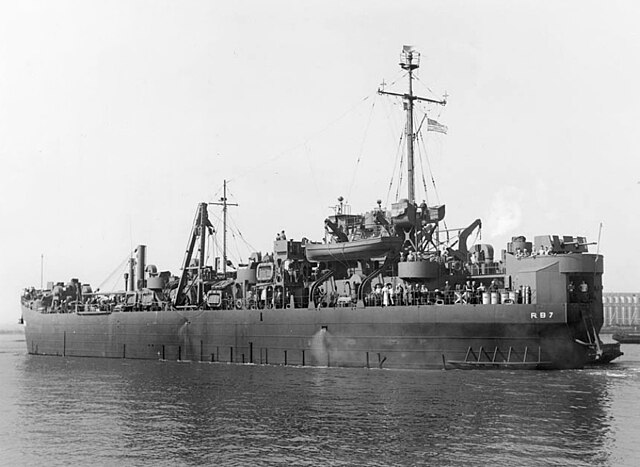 Pacific War Pacific War CHINA (Fourteenth Air Force): In China, 34 B-24s, with an escort of 9 fighters, pound the Chenghsien locomotive park and Yellow River bridge; 30+ B-25s and 100+ fighter-bombers, operating in forces of 1 to 8 aircraft, attack tanks, trucks, locomotives, troop concentrations, storage areas, airstrips, bridges, gun positions, and general targets of opportunity throughout S and E China. INDIA-BURMA (Tenth Air Force): 31 fighter-bombers and 9 B-25s operating over the battlefront and behind enemy lines in C Burma pound troop concentrations, supply areas, a truck park, and general targets of opportunity; 9 other fighter-bombers attack targets of opportunity along roads S of the bomb line; 504 air supply sorties are flown, landing men and supplies at advanced bases and dropping supplies to frontline forces. Lost is B-24L 44-49607. GUAM Seventh Air Force: 9 B-24s from Guam bomb the torpedo storage area on Marcus in the N Pacific. 24 Angaur Airfield based B-24s bomb defensive positions and the town of Naga on Luzon . During the night of 24/25 Mar, 5 Guam -based B-24s hit the airfield and town of Okimura on Haha Jima. VII Fighter Command: 16 Iwo Jima based P-51s hit air, naval, and radar installations and targets of opportunity on Chichi Jima. MARIANAS ISLANDS (Twentieth Air Force): Mission 45: 223 of 248 B-29s, from the Marianas, attack the Mitsubishi aircraft engine plant at Nagoya, Japan during the night of 24/25 Mar; 3 other B-29s hit alternate targets; 5 B-29s are lost. SOUTHWEST PACIFIC AREA [Far East Air Force]: On Formosa, B-24s hit the harbor at Takao and power plant and alcohol factory E of Okayama. BURMA The Allied Chinese New 1st Army links up with the Chinese 50th Division near Hsipaw, bringing the campaign in northern Burma to an end. PHILIPPINE CAMPAIGN (1945) B-24s and A-20s pound Cebu City and defenses and installations on Cebu. On Luzon, B-24s, B-25s, A-20s, and P-38s attack Balete Pass, Legaspi, the Batangas area, and scattered targets throughout Luzon. HQ 91st Photographic Wing (Reconnaissance) moves from Mindoro to Clark Field. VOLCANO AND RYUKYU ISLANDS CAMPAIGN US Task Force 58 (Admiral Mitscher) conduct air raids on Okinawa. The island is also bombarded by 5 battleships and 11 destroyers under the command of Admiral Lee. Japanese submarines make unsuccessful attacks on the American ships. Meanwhile USAAF B-24 (possibly a USN PB4Y) attacks nine-ship Japanese Naha-to-Kagoshima convoy Kana-304 (probably rerouted into the East China Sea because of Allied air activity in the Ryukyus), sinking auxiliary minesweeper Seki Maru off Tokara Gunto, 29°12'N, 125°13'E. Planes from TG 58.1--carriers Bennington (CV-20) and Hornet (CV-12) and small carriers Belleau Wood (CVL-24) and San Jacinto (CVL-30)--complete the destruction of Kana-304, sinking torpedo boat Tomozuru, Coast Defense Vessel No. 68, auxiliary minesweepers Chitose Maru and No.16 Shonan Maru, army cargo ships Koshu Maru, and merchant cargo ships Soka Maru, Kaijo Maru and No.3 Tsukushi Maru about 200 miles northwest of Okinawa, 28°25'N, 124°32'E. The same day, TF 58 planes also sink army cargo ship Seizan Maru and merchantmen Sanko Maru at 29°15'N, 125°13'E, and Kobe Maru at 30°00'N, 126°30'E. Photo: The Japanese torpedo boat Tomozuru sinking 220 km north-west of Okinawa on 24 March 1945. It was attacked by aircraft from the U.S. Navy Task Group 58.1 Photo: A Japanese ship explodes in the China Sea during an attack by U.S. Navy aircraft, 24 March 1945 Photo: A Japanese ship explodes in the China Sea during an attack by U.S. Navy aircraft, 24 March 1945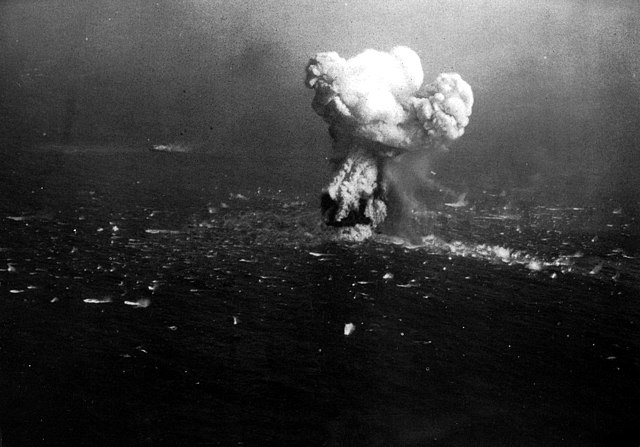 Photo: The Japanese torpedo boat Tomozuru sinking 220 km north-west of Okinawa on 24 March 1945. It was attacked by aircraft from the U.S. Navy Task Group 58.1 Photo: The Japanese torpedo boat Tomozuru sinking 220 km north-west of Okinawa on 24 March 1945. It was attacked by aircraft from the U.S. Navy Task Group 58.1 Photo: The U.S. Navy destroyer USS Hart (DD-594) underway in the Pacific Ocean on 24 March 1945, during the Okinawa operation Photo: The U.S. Navy destroyer USS Hart (DD-594) underway in the Pacific Ocean on 24 March 1945, during the Okinawa operation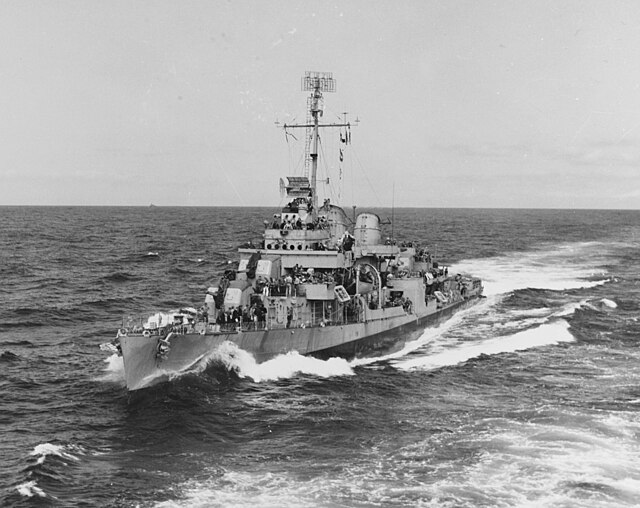 UNITED STATES NAVY DEPARTMENT COMMUNIQUES, CINCPOA COMMUNIQUÉ NO. 308, MARCH 24, 1945 Following the destructive attacks on objectives in the Inland Sea on March 19 (East Longitude Date), fighting between the carrier‑based aircraft of the Fifth Fleet operating in Japanese home waters and the enemy air force based on Kyushu, Shikoku and Honshu continued on March 20 and 21. Although complete details are not yet available reports show that large numbers of Japanese aircraft were shot down both by the fire of the Hellcat and Corsair fighters of the Fleet and by its antiaircraft guns. On the afternoon of March 21 approximately fifty enemy aircraft were shot down in one encounter with a loss of three of our fighters. During this fighting one of our destroyers was seriously damaged and one larger unit received minor damage. On March 23 and 24, in bad weather, units of the U. S. Pacific Fleet struck objectives in the Ryukyus including aircraft, shipping, airdromes and installations in the Kerama‑Retto at Okinawa, at le Shima and at Minami Daito Shima. Carrier aircraft destroyed some enemy shipping and damaged numerous small craft. Fast battleships attacked coastal objectives with their heavy guns. Mustangs of the Seventh Fighter Command based on Iwo attacked targets on Chichi Jima in the Bonins on March 24. Corsair and Hellcat fighters of the Fourth Marine Aircraft Wing bombed and damaged the causeway between Koror and Babelthuap in the Palaus and set supply dumps afire elsewhere in these Islands on March 24. During the week of March 11 through 17, garrison forces killed 51 of the enemy and took 16 prisoners on Saipan, Tinian and Guam in the Marianas and Peleliu in the Palaus. On March 23, Navy Search Privateers of Fleet Air Wing Two bombed Wake Island. Neutralizing attacks on enemy‑held bases in the Marshalls were continued by Fighters of the Fourth Marine Aircraft Wing on March 23 and 24. UNITED STATES NAVY DEPARTMENT COMMUNIQUES, CINCPOA PRESS RELEASE NO. 45, MARCH 24, 1945 The Commander in Chief, U. S. Pacific Fleet, regrets to announce the loss of the escort aircraft carrier, USS Bismarck Sea, due to enemy action. The commanding officer and most of the ship's company are survivors. Next of kin of those who lost their lives have been notified. While supporting the assault on Iwo Island, the Bismarck Sea was damaged by enemy air attacks on the evening of 21 February (East Longitude Date) and fires were started aboard her. Subsequently the fires spread throughout the ship and, having made every effort to save her, the ship's company was ordered to abandon her. She sank a short time later. The Bismarck Sea, of the Casablanca Class, was built by the Kaiser Shipyards at Vancouver, Washington, and was commissioned in 1944. After a period of escort duty, she was assigned to the Seventh Fleet and supported the invasion of Lingayen, Luzon. She then joined the forces which participated in the Iwo operation. Captain John Lockwood Pratt, USN, was commanding officer. Published information on the Casablanca. Class Displacement‑ About 4,000 tons. Length ‑ About 500 feet. Speed ‑ About 19 knots. Aircraft ‑ About 20. PACIFIC USAAF B-24s (13th Air Force) sink Japanese cargo ship Koshin Maru off Boeton Island Celebes, 05°40'S, 122°49'E.
|
|
lordroel
Administrator
Member is Online
Posts: 68,017 
Likes: 49,422
|
Post by lordroel on Mar 25, 2024 3:46:27 GMT
Day 2022 of World War II, March 25th 1945Eastern FrontIn East Prussia, Keiligenbeil falls to units of the 3rd Belorussian Front. In Hungary, the Soviet offensive continues with the capture of Esztergom on the Danube River. Just north of the Danube, there are attacks by other elements of 3rd Ukrainian Front. Western Front (1945) - Western Allied invasion of GermanyMap: HQ Twelfth Army Group situation map, March 25th 1945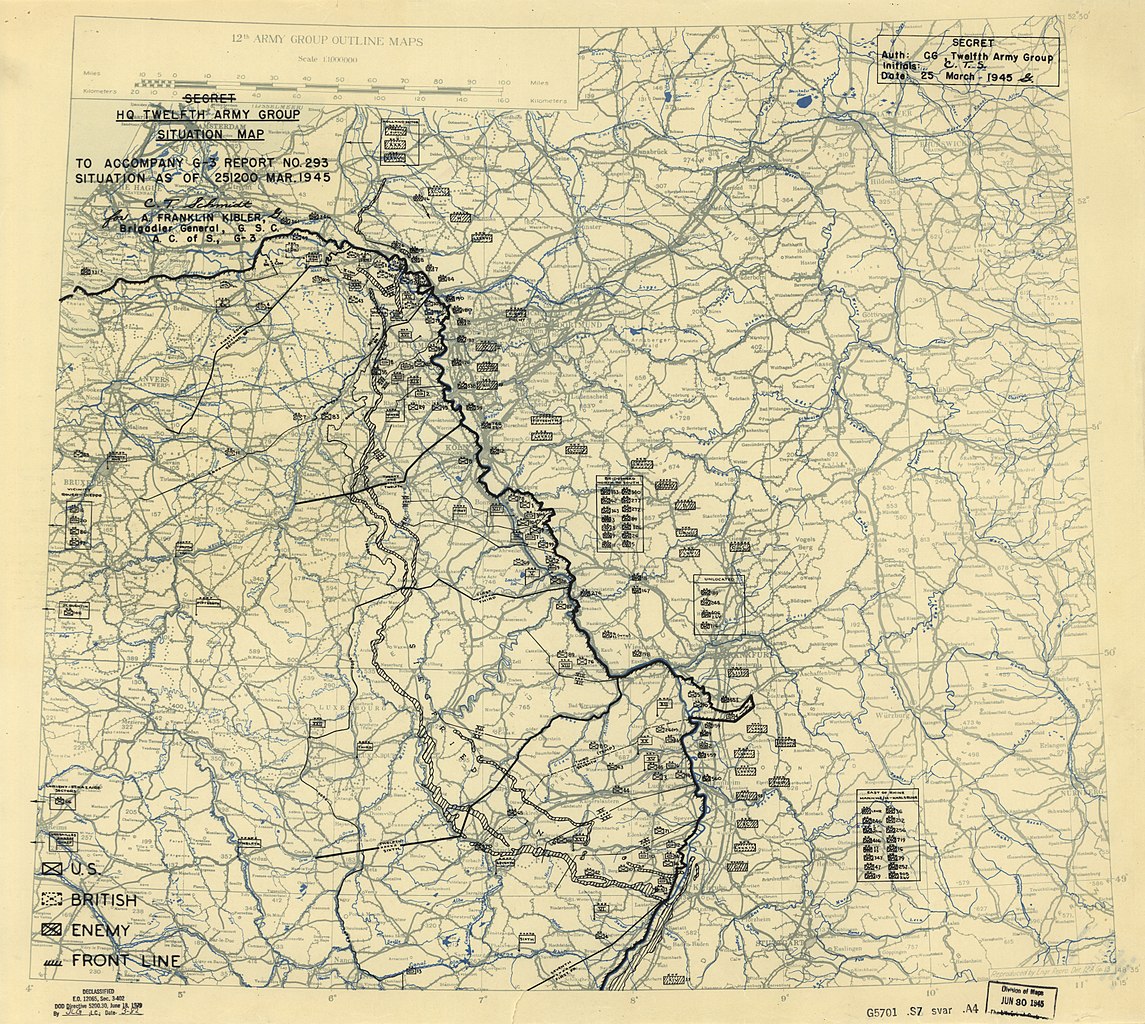 During the day, the various crossings of British 21st Army Group are consolidated into a single bridgehead, 30 miles wide. Photo: British Polsten triple 20mm anti-aircraft mounting on the banks of the Rhine, 25 March 1945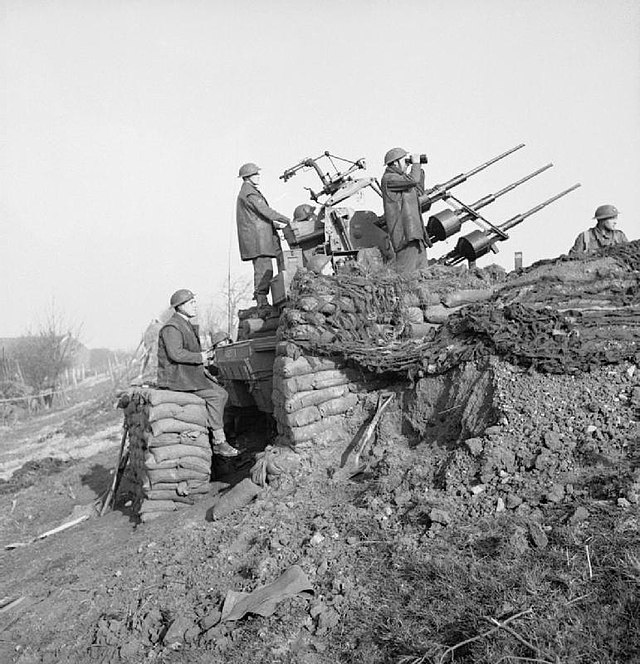 Photo: DUKW amphibious vehicles ferrying supplies across the Rhine, 25 March 1945 Photo: DUKW amphibious vehicles ferrying supplies across the Rhine, 25 March 1945 Photo: The Prime Minister Winston Churchill crosses the River Rhine to the east bank, south of Wesel, in an American Landing Craft Vehicle Personnel (or Higgins boat) with Field Marshal Sir Bernard Montgomery, Field Marshal Sir Alan Brooke and US General William Simpson on 25 March 1945 Photo: The Prime Minister Winston Churchill crosses the River Rhine to the east bank, south of Wesel, in an American Landing Craft Vehicle Personnel (or Higgins boat) with Field Marshal Sir Bernard Montgomery, Field Marshal Sir Alan Brooke and US General William Simpson on 25 March 1945 Photo: Churchill on the east bank of the Rhine, south of Wesel, 25 March 1945 Photo: Churchill on the east bank of the Rhine, south of Wesel, 25 March 1945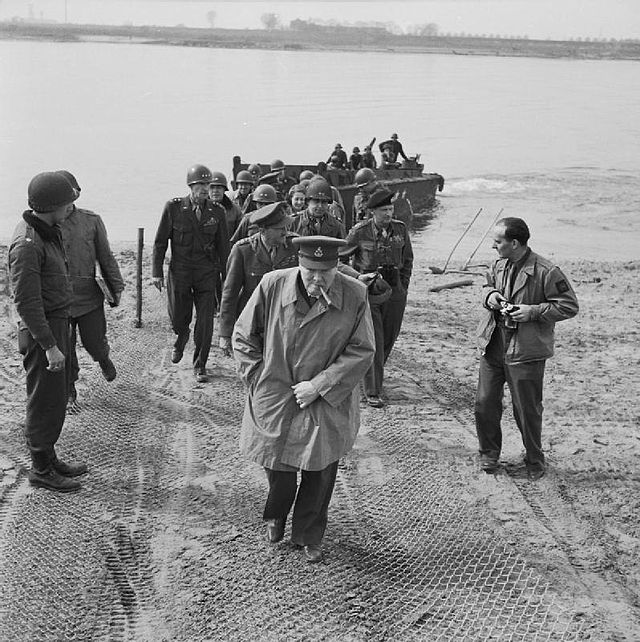 With British and US troops linking up on the east bank of the Rhine, Montgomery forbids British troops to "fraternize" with the local population. As part of Operation Varsity, the US 17th Airborne Division is dropped over the east bank of the Rhine. Canadian troops of the British 2nd Army cross the Rhine river and begin an attack on Bienen, Germany, against the German 1st Parachute Army and 47th Panzer Corps. Photo: Horsa gliders landing near Hamminkeln during the airborne drop east of the Rhine, 25 March 1945 Photo: British paratroops in Hamminkeln, Germany, during airborne landings east of the Rhine, 25 March 1945 Photo: British paratroops in Hamminkeln, Germany, during airborne landings east of the Rhine, 25 March 1945 Photo: British airborne troops study a sign outside Hamminkeln during operations east of the Rhine, 25 March 1945 Photo: British airborne troops study a sign outside Hamminkeln during operations east of the Rhine, 25 March 1945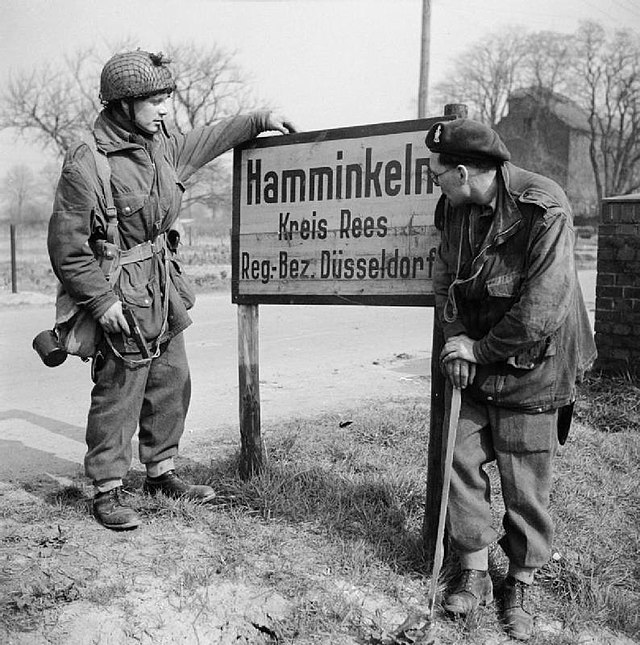 Photo: British airborne troops with a 6-pdr anti-tank gun in Hamminkeln, Germany, 25 March 1945 Photo: British airborne troops with a 6-pdr anti-tank gun in Hamminkeln, Germany, 25 March 1945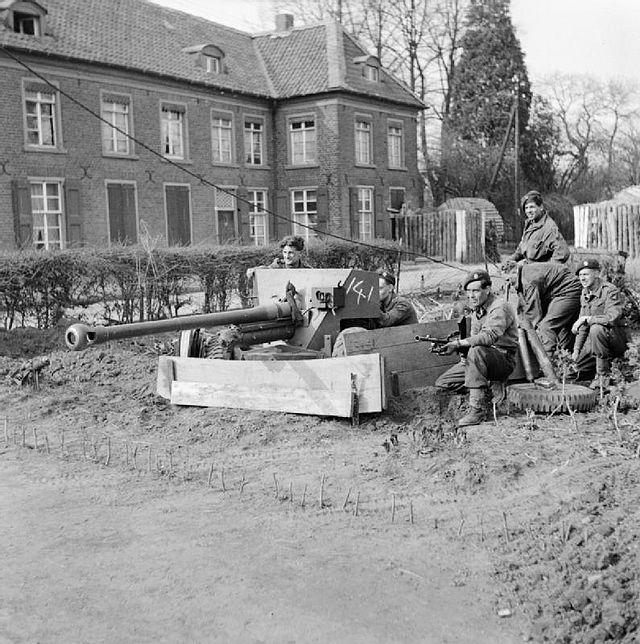 US 1st Army units, principally from US 3rd Corps, begin to break out of the Remagen bridgehead. The US 8th Corps (part of US 3rd Army) begins to cross the Rhine River near Boppard. To the south, Darmstadt is taken by US 12th Corps units who crossed at Nierstein. Other units have advanced farther east to the Main near Hanau and Aschaffenburg. Photo: Infantrymen of the 5th Division, 3rd U.S. Army, enter the town of Hasslach, Germany, near the river Rhine. 25 March, 1945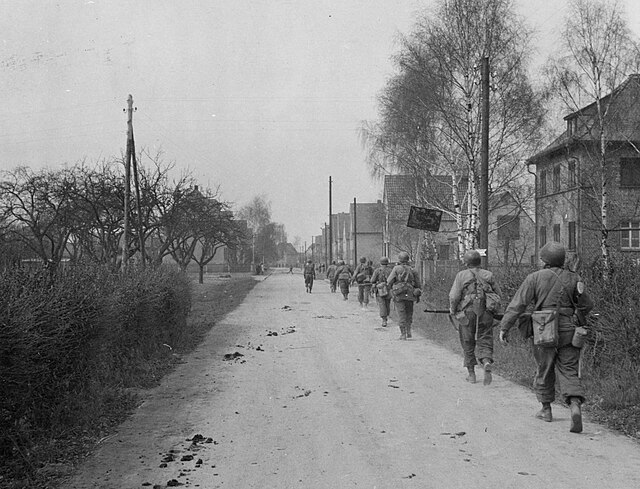 Air War over Europe Air War over Europe (US Fifteenth Air Force): In Czechoslovakia, 650+ B-17s and B-24s strike 2 airfields and a tank works at Prague (the patterns of the bombs also hit 2 other nearby airfields) and an airfield at Cheb. Alternate targets that are bombed include Wels, Austria and Udine Airfield, Italy. P-38s and P-47s escort the bombers, and sweep and strafe the Nurnberg- Eibelstadt-Wurzburg-Regensburg, Germany areas, and fly reconnaissance operations. The Bomber Command operations on this day were directed to towns on the main reinforcement routes into the Rhine battle area. Heavy attacks were made on the railway routes through these towns and on the surrounding built-up areas. Hannover attacked by 267 Lancasters and 8 Mosquitos of Nos 1, 6 and 8 Groups. The bombing was observed to fall in the target area. 1 Lancaster lost. Photo: A group of cluster bombs falling towards Hanover, Germany, 25 March 1945 175 RAF aircraft - 151 Halifaxes, 14 Lancasters, 10 Mosquitos - of Nos 4, 6 and 8 Groups raided Münster. 3 Halifaxes lost. Few results were seen by the bombers because the target area rapidly became smoke-covered. Münster reports a large number of bombs but only 2 people dead. 156 RAF aircraft - 132 Halifaxes, 14 Lancasters, 10 Mosquitos - of Nos 4 and 8 Groups to Osnabrück. No aircraft lost. Osnabrück reports extensive property damage throughout the town. 8 RAF Mosquitos to Berlin and 1 Lancaster dropping leaflets over The Hague. No losses. (US Eighth Air Force): 2 missions are flown. Mission 913: 1,009 bombers and 341 fighters are dispatched to hit seven oil plants and a tank factory in Germany; they claim 6-4-13 Luftwaffe aircraft; 4 B-24s and 1 P-51 are lost: 1. 272 B-24s are sent to hti the Ehmen (59), Hitzacker (127) and Bucken (57) oil depots; they claim 2-4-9 aircraft; 4 B-24s are lost, 2 damaged beyond repair and 19 damaged; 16 airmen are KIA, 2 WIA and 39 MIA. Escorting are 223 P-47s and P-51s; they claim 4-0-3 aircraft in the air. 2. 737 B-17s are dispatched to hit oil plants but bad weather during the assembly and the increasing possibility of adverse conditions causes the mission to be cancelled; 3 B-17s are damaged beyond repair and 9 airmen are KIA. 3. 47 of 48 P-51s escort Ninth AF B-26s. 4. 24 P-51s fly a fighter-bomber mission against the Schmalge ammunition dump; 1 P-51 is lost (pilot MIA). 5. 11 P-51s fly a scouting mission claiming 0-0-1 aircraft in the air. 6. 16 P-15s escort 8 F-5s and 3 Spitfires on photo reconnaissance missions over Germany. Mission 914: 10 B-24s drop leaflets in Germany and the Netherlands during the night. (US Ninth Air Force): In Germany, the 9th Bombardment Division hits 4 communications centers, 3 marshalling yards, and targets of opportunity, including flak positions; fighters fly escort, armed reconnaissance, and missions against several ground targets; fighters support the US 79th Infantry Division as it pushes 2 miles (3.2 km) to the E of the Rhine River (SE of Wesel), the III and VII Corps as they begin their breakout assault toward Altenkirchen and in the Epgert and Willroth areas, and the XII Corps as it establishes bridgeheads on the Main River in the Hanau and Aschaffenburg areas. Italian campaign (US Twelfth Air Force): In Italy during the night of 24/25 Mar, A-20s and A-26s continue intruder missions, attacking Po River crossings and railroad and motor transport targets; P-47s, during the day, raid railroad bridges and lines, hitting targets at Lavis, Casarsa della Delizia, San Michele all'Adige, Pavia, Santa Margherita d'Adige, and other points in the Po Valley and NE Italy, and bomb fuel dumps N of the battle area; 6 medium bomber missions against bridges and fills in Italy and Austria are ineffective because of bad weather. GermanyField Marshal Albert Kesselring is moved from being Commander-in-Chief Armed Forces West to be Commander-in-Chief Armed Forces South. United StatesPhoto: The U.S. Navy troop transport USS General M. C. Meigs (AP-116) underway in the Atlantic Ocean on 25 March 1945, wearing Camouflage Measure 32, Design 10T. The photo was taken by a blimp from squadron ZP-12 out of Naval Air Station Lakehurst, New Jersey (USA)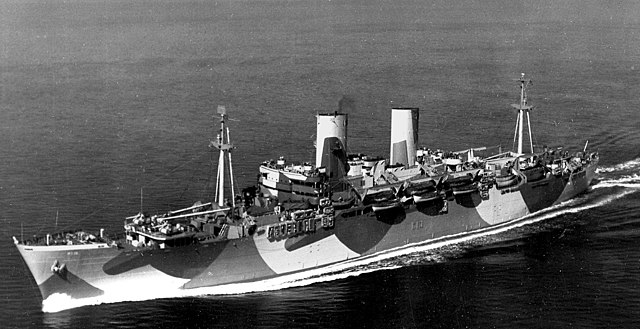 Pacific War Pacific War CHINA (Fourteenth Air Force): In China, 20+ B-25s and 150+ fighters, operating individually and in flights of up to 8 aircraft, continue attacks on numerous targets including river, road, and rail traffic, airfields, troop concentrations, storage areas, horses, and gun positions throughout S and E China; the detachment of the 22d Bombardment Squadron (Medium), 341st BG (Medium), operating from Peishiyi with B-25s, returns to base at Yangkai. INDIA-BURMA (Tenth Air Force): In Burma, 26 P-47s support forces of the Chinese 50th Division in the Hsipaw area; 44 fighter-bombers and 14 B-25s attack troops and supplies and hit targets of opportunity along roads behind the battleline in C Burma; 557 transport sorties are flown to forward areas. GUAM (Seventh Air Force During): the night of 25/26 Mar, 5 B-24s from Guam Island hit Susaki Airfield. 23 B-24s from Angaur Airfield bomb defenses on Cebu. The US Marines complete the reduction of the final resistance pocket on Iwo Jima. VII Fighter Command: 16 Iwo Jima based P-51s bomb and strafe Susaki Airfield, and naval and radar installations on Chichi Jima; 16 more follow with attacks on a radar station and personnel concentration on the island. PHILIPPINE CAMPAIGN (1945) Cebu City is thoroughly pounded by nearly 70 B-24s. B-24s hit Legaspi, and B-25s and fighter-bombers fly numerous ground support missions, especially between Montalban and Laguna de Bay. B-25s attack Pandanan Island, Philippine Islands. The 6th Combat Cargo Squadron, 2d Combat Cargo Group, moves from Biak to Dulag with C-46s; and the 339th Fighter Squadron, 347th Fighter Group, ceases operating from Morotai with P-38s and returns to base at Puerto Princesa. VOLCANO AND RYUKYU ISLANDS CAMPAIGN TF 54 (Rear Admiral Morton L. Deyo) battleships, cruisers, and destroyers bombard Kerama Retto and southeast coast of Okinawa, Ryukyus; bombardment continues daily. Off Okinawa, kamikazes damage destroyer Kimberley (DD-521), 26°02'N, 126°54'E; light minelayer Robert H. Smith (DM-23), 26°00'N, 128°00'E; high speed transport Gilmer (APD-11), 26°00'N, 127°20'E; destroyer escort Sederstrom (DE-31) is damaged in collision with escort carrier Sangamon (CVE-26), 25°00'N, 130°00'E; high speed transport Knudsen (APD-101) is damaged by horizontal bomber, 26°12'N, 127°04'E. UNITED STATES NAVY DEPARTMENT COMMUNIQUES, CINCPOA COMMUNIQUÉ NO. 309, MARCH 25, 1945 Avenger torpedo planes and Helldiver bombers of the Fifth Fleet covered by Corsair and Hellcat fighters destroyed a convoy of three large cargo ships, two destroyers, and three other escort vessels west of the Amami Gunto in the Ryukyus on March 24 (East Longitude Date). On the same date Navy search Liberators of Fleet Air Wing One attacked a medium sized cargo ship in the northern Ryukyus. Navy search Venturas strafed two small cargo ships north of the Bonins on March 25, leaving one ship dead in the water and the other damaged. Liberators of the Seventh Army Air Force bombed the airfield on Chichi Jima in the Bonins on March 23. Naval installations and air facilities were bombed and strafed by Army Mustang fighters on March 23 and 24. Storage areas on Marcus Island were bombed by Seventh Army Air Force Liberators on March 24. Attacking through intense antiaircraft fire, planes of the Fourth Marine Aircraft Wing destroyed a bridge and large building and started fires on Babelthuap in the Palaus on March 25. On the same date installations on Yap in the Western Carolines were bombed by Marine Corsair fighters. PACIFIC Submarine Tirante (SS-420) sinks Japanese auxiliary netlayer Fuji Maru off Tori Jima, Japan, 31°08'N, 130°30'E. TF 58 planes sink Japanese merchant cargo ships No.5 Okinoyama Maru and Chokai Maru near Naha, Okinawa, 26°13'N, 127°39'E. Auxiliary submarine chaser Sobun Maru is damaged between Yaku Jima and Amami O Shima. USAAF B-24s (5th Air Force) sink Japanese Kori Go Maru (ex-Chinese Houlee) in Yangtze estuary near Shanghai, 31°11'N, 122°23'E.
|
|



















































































































































